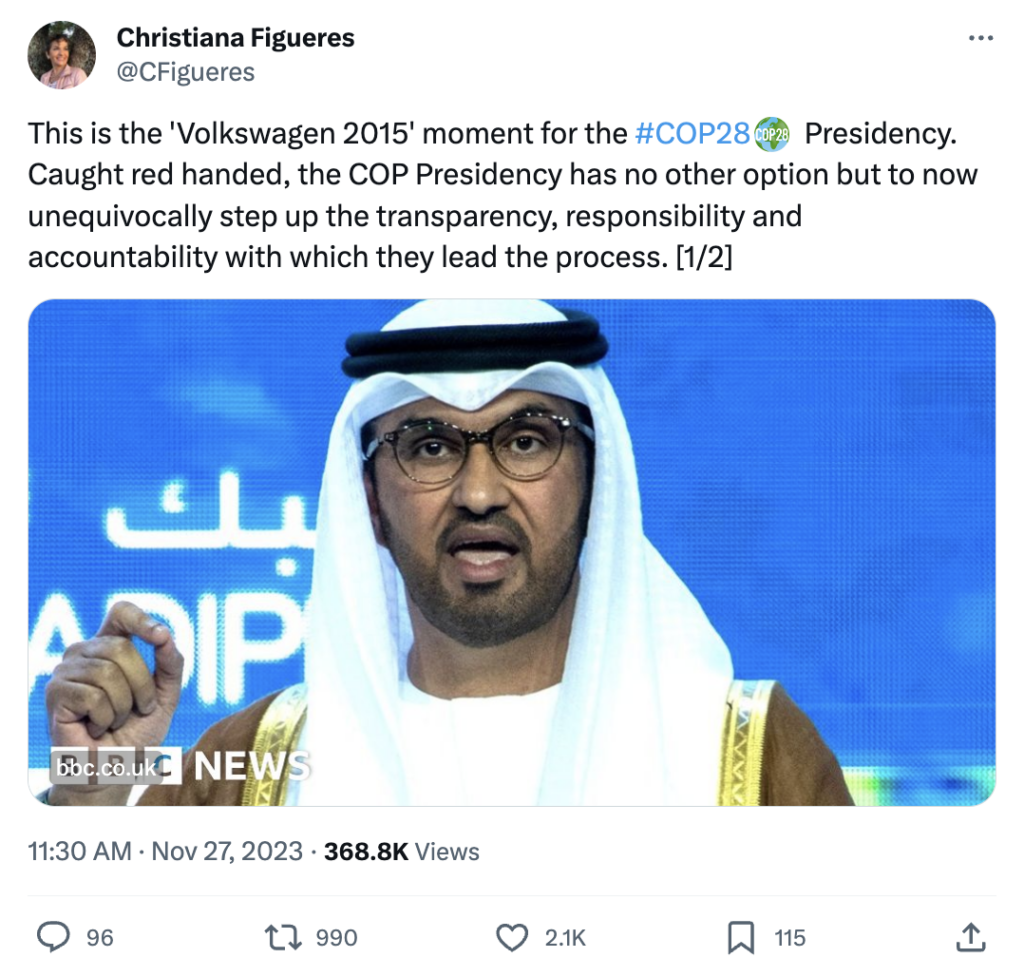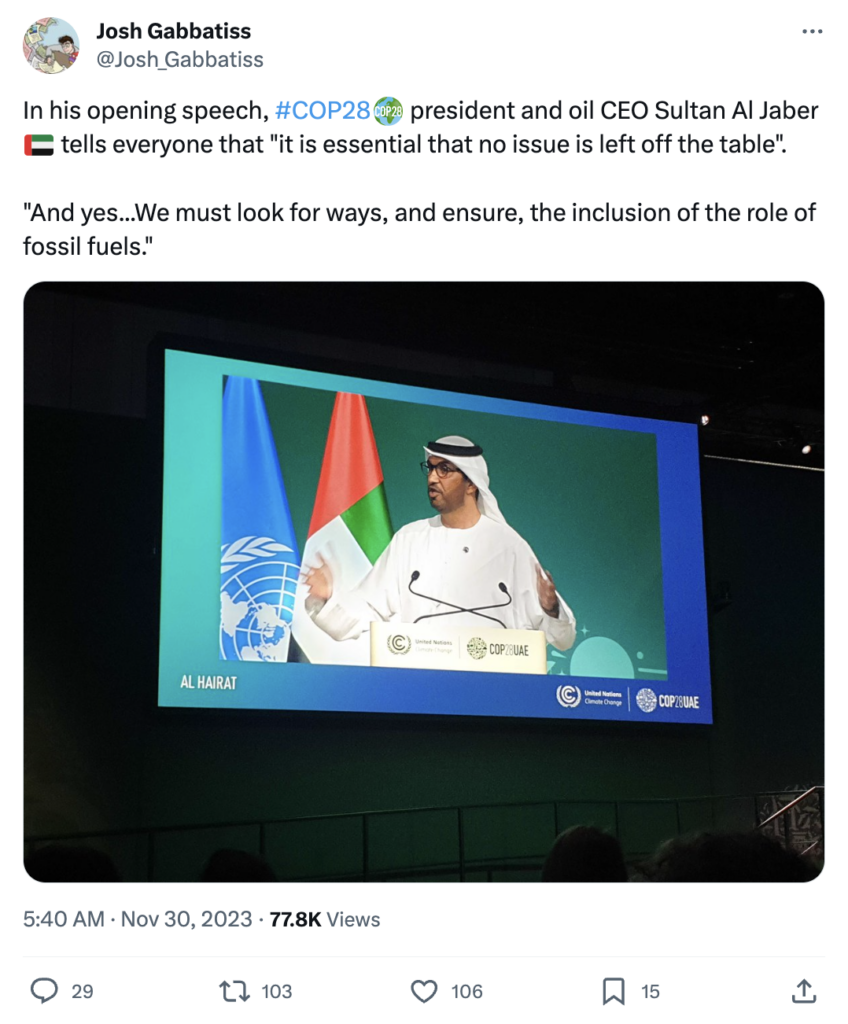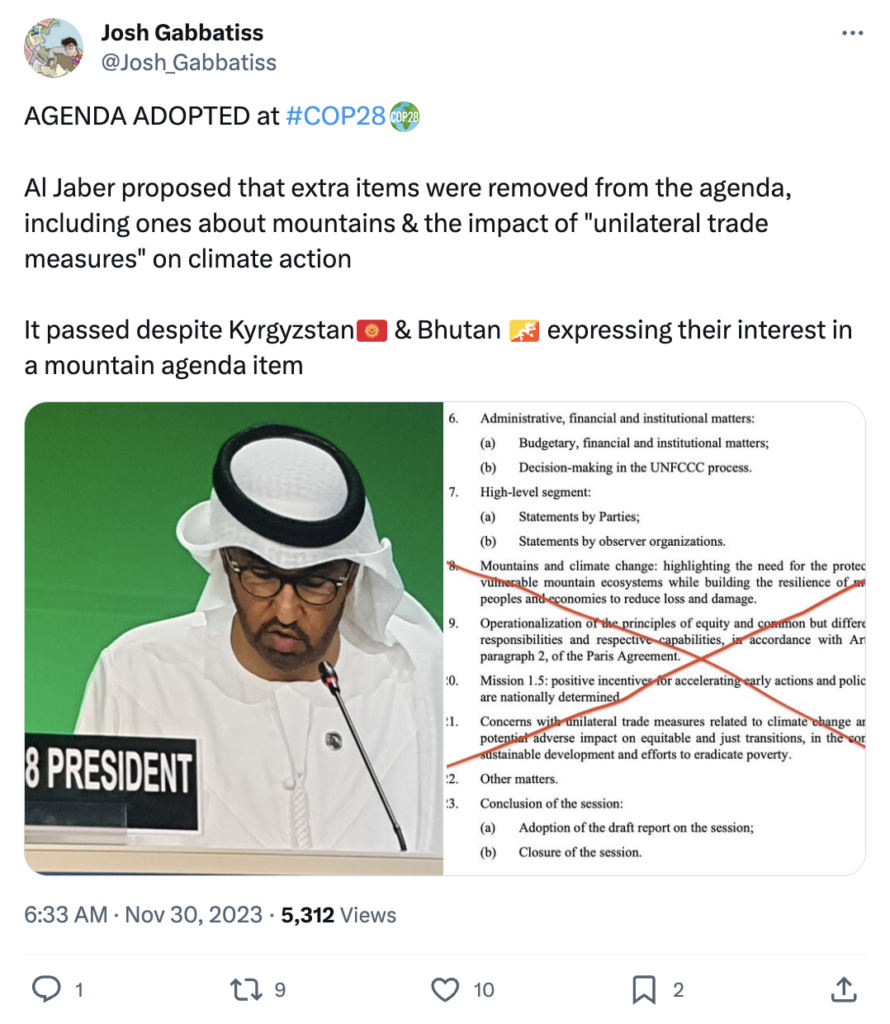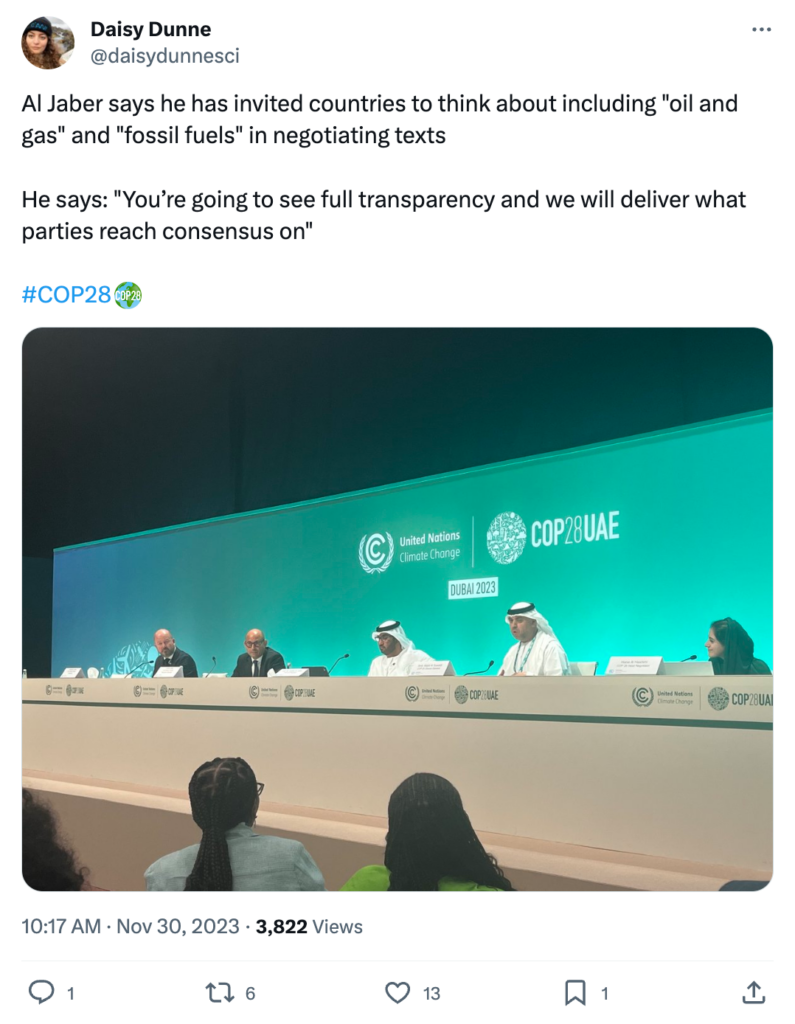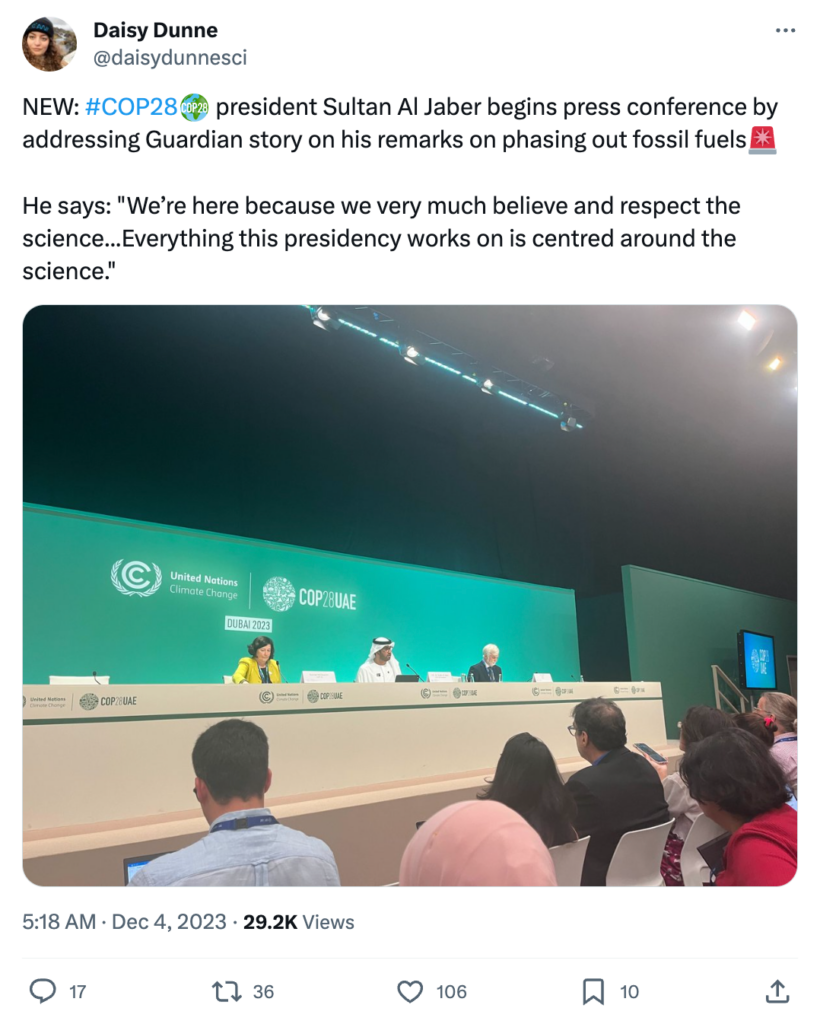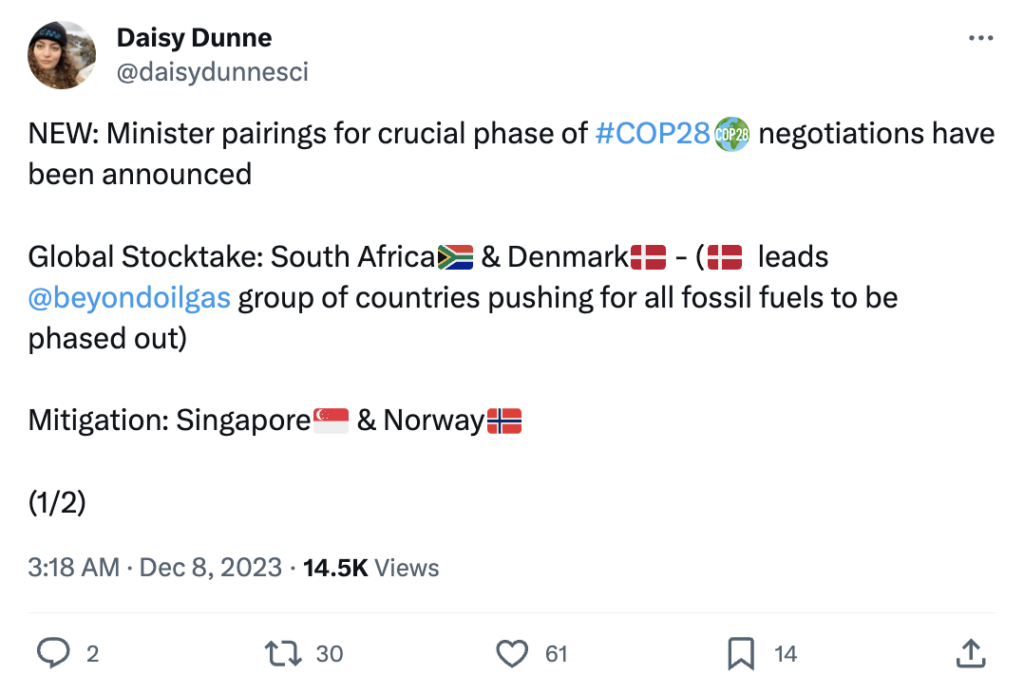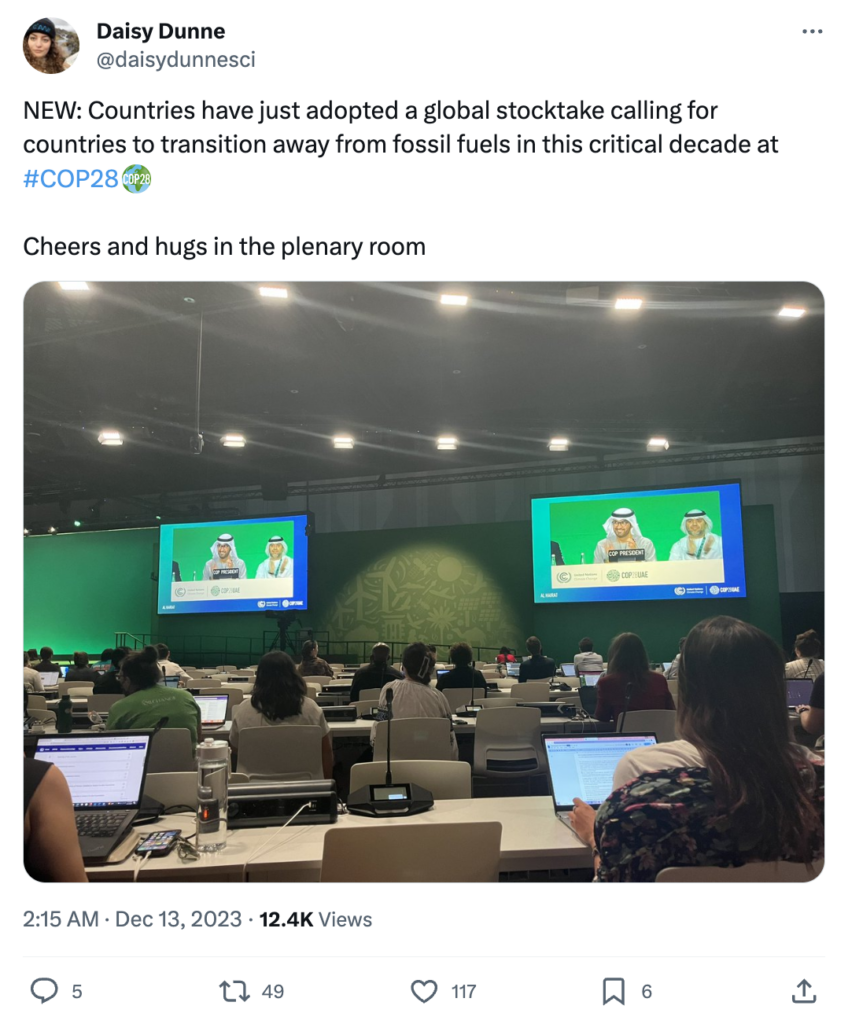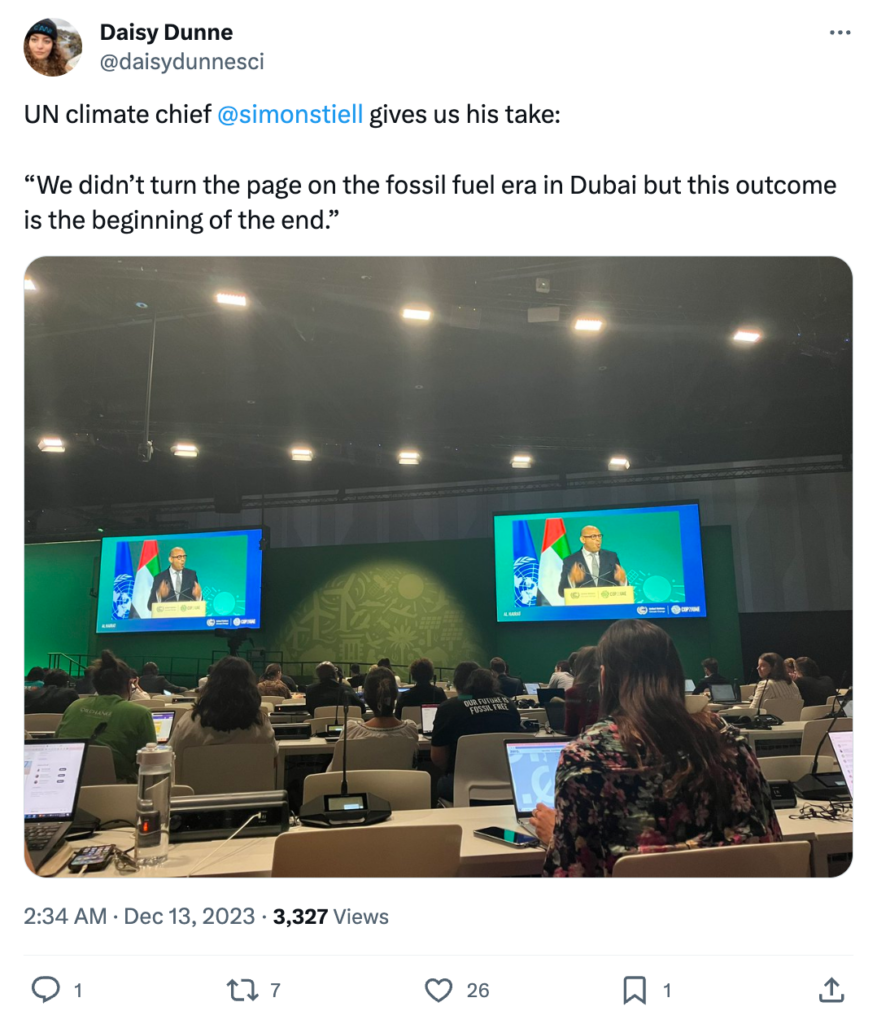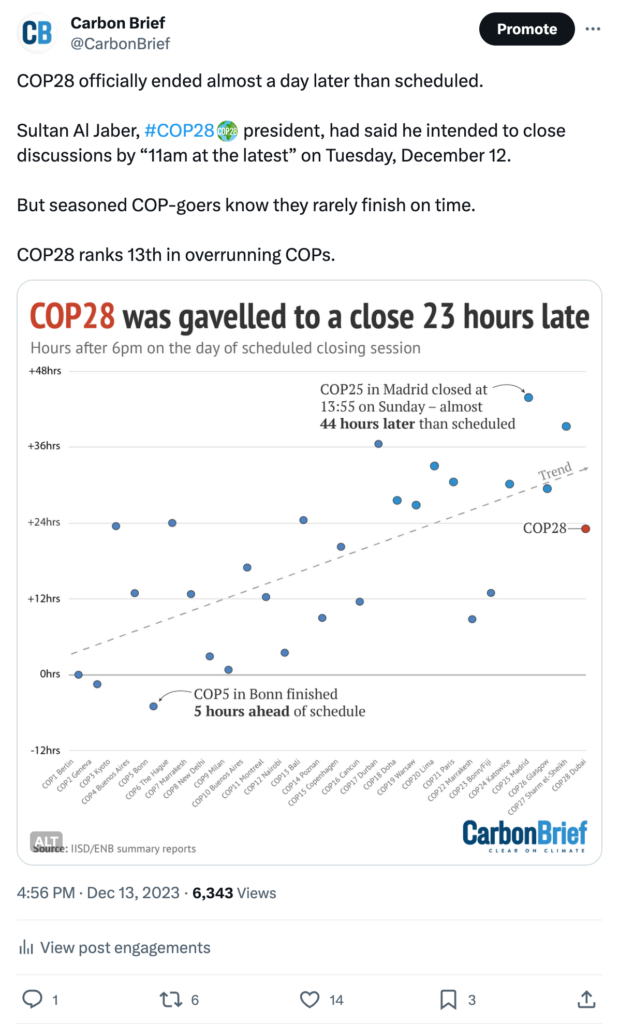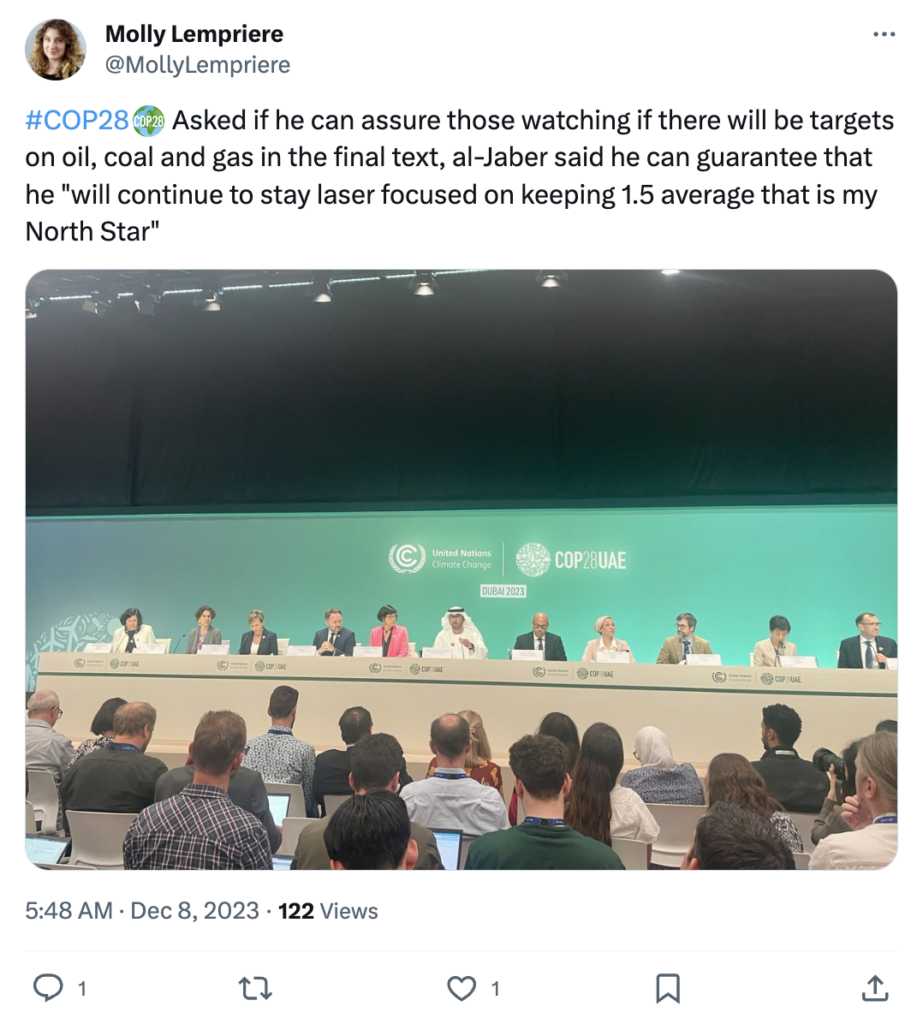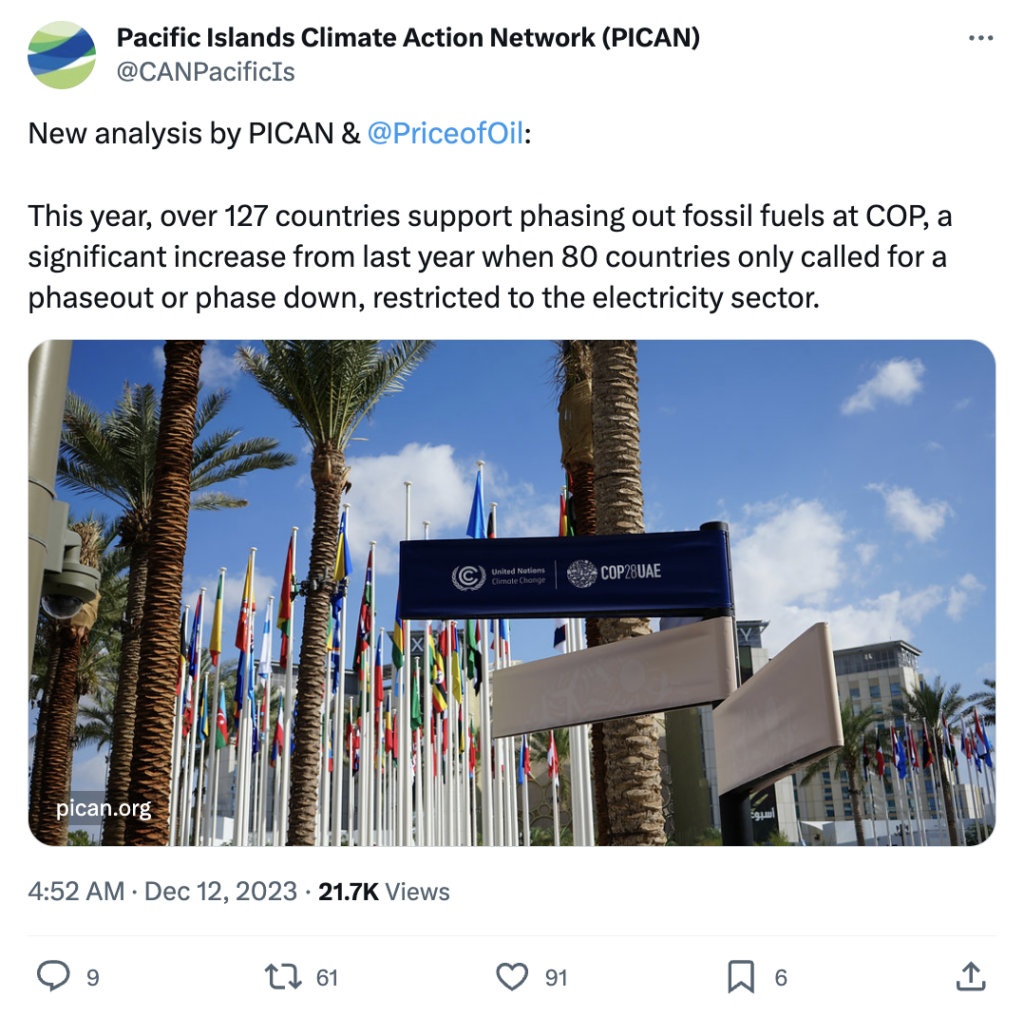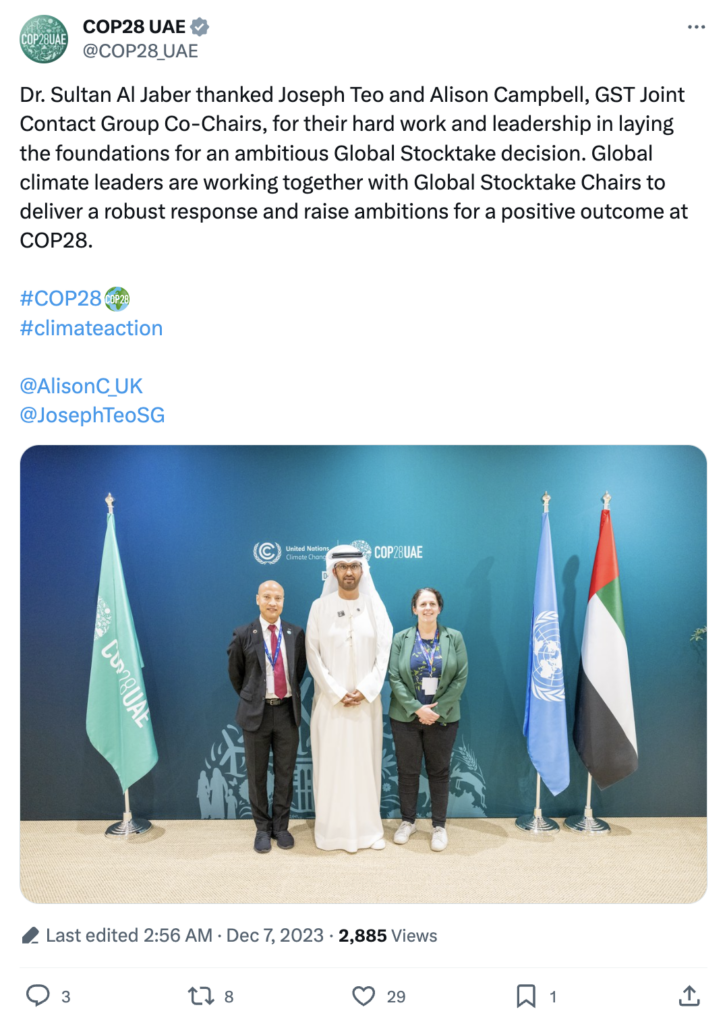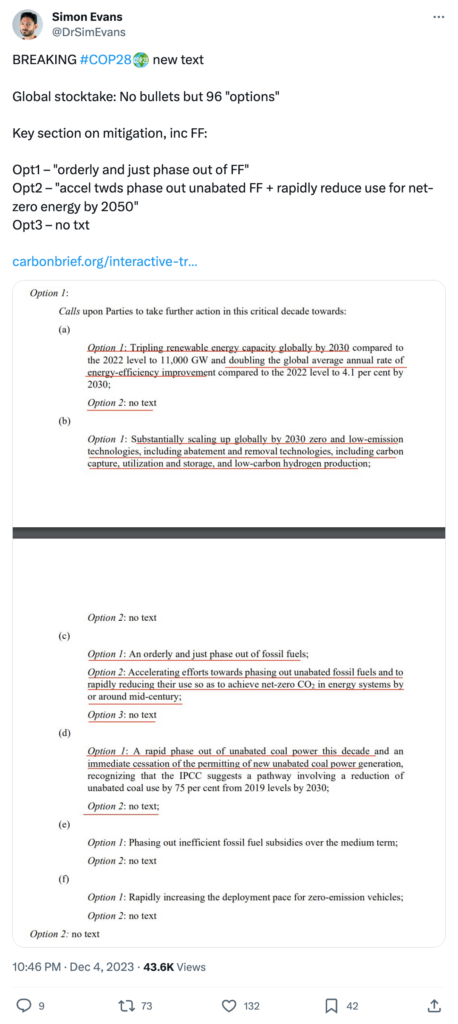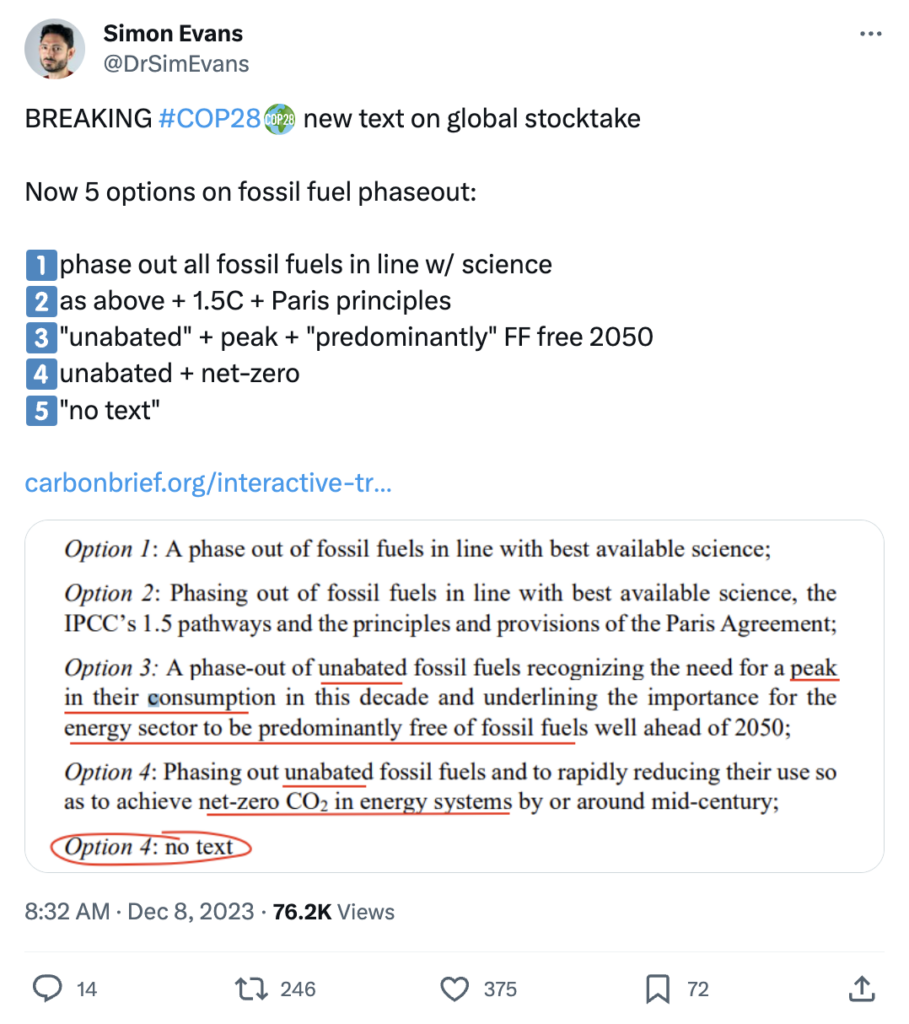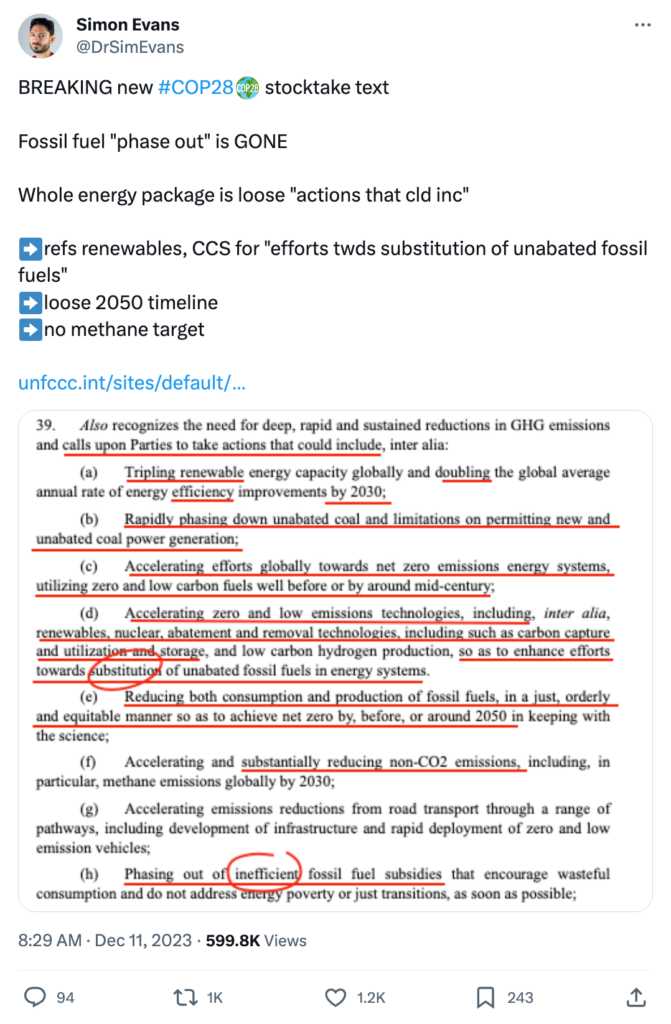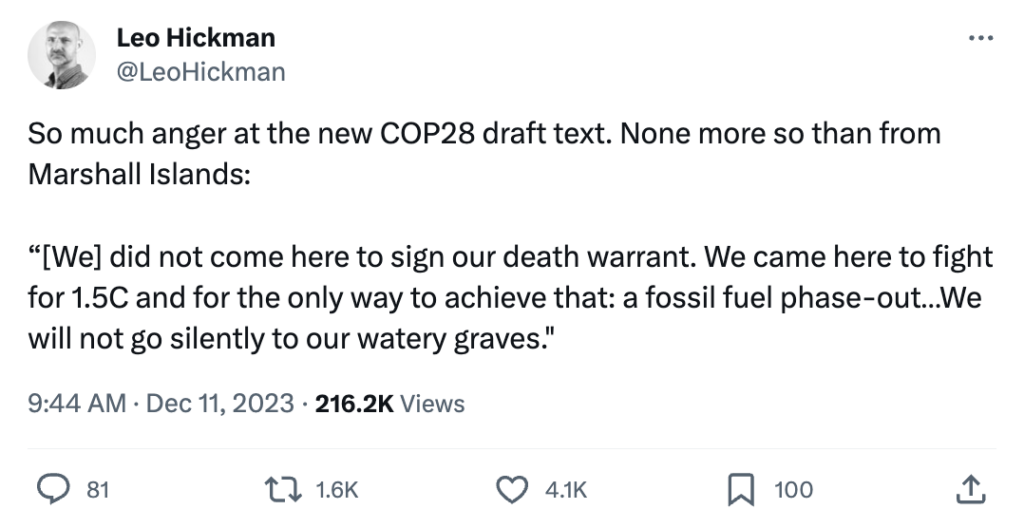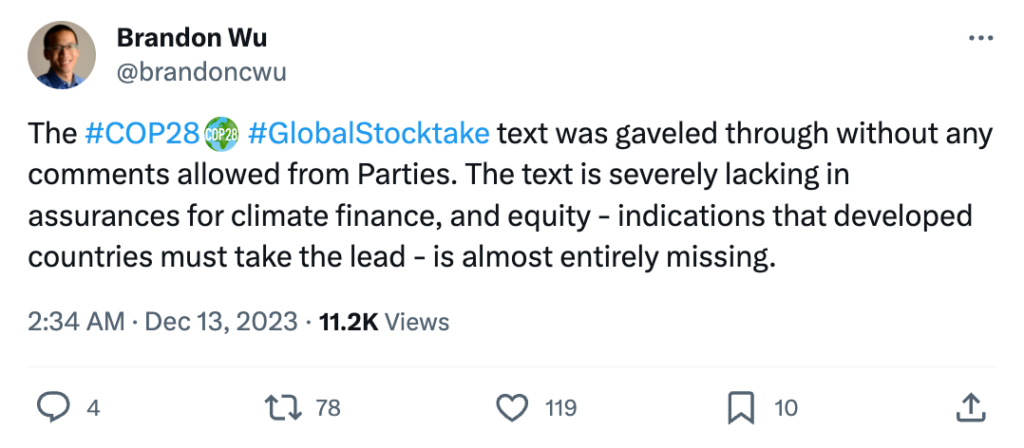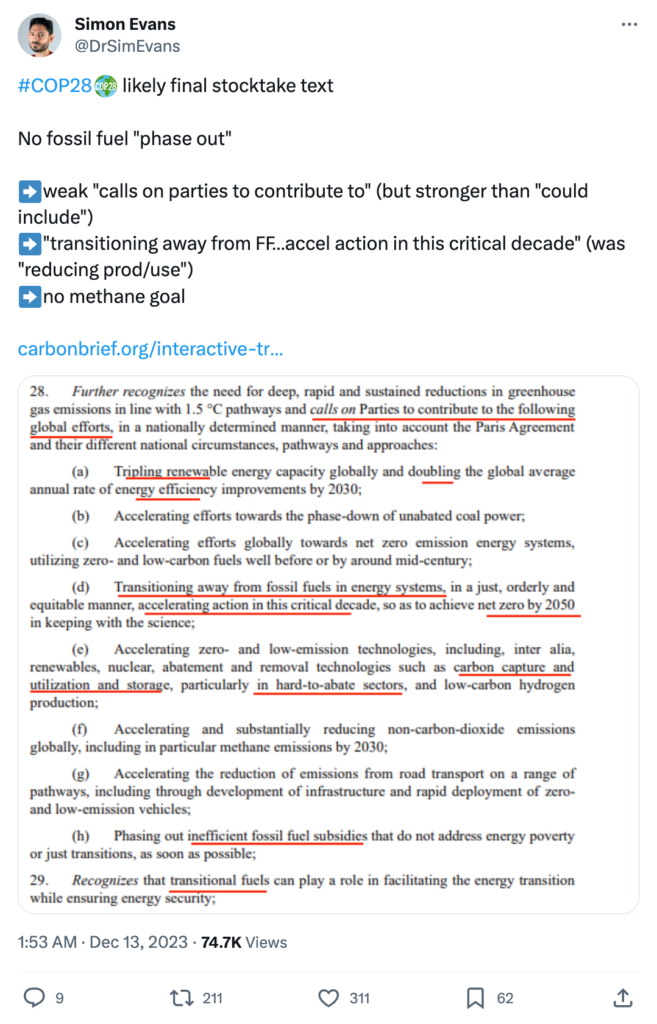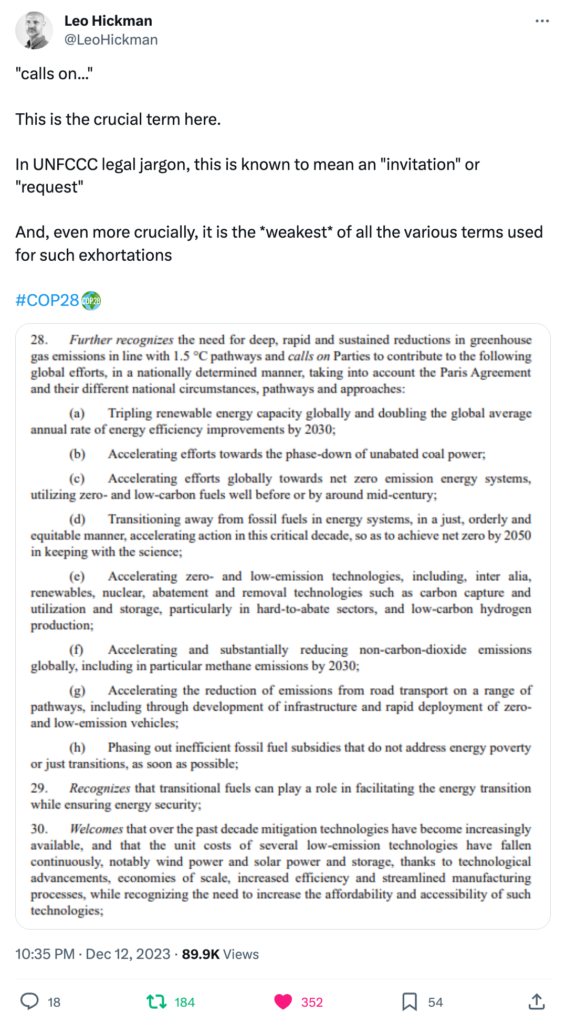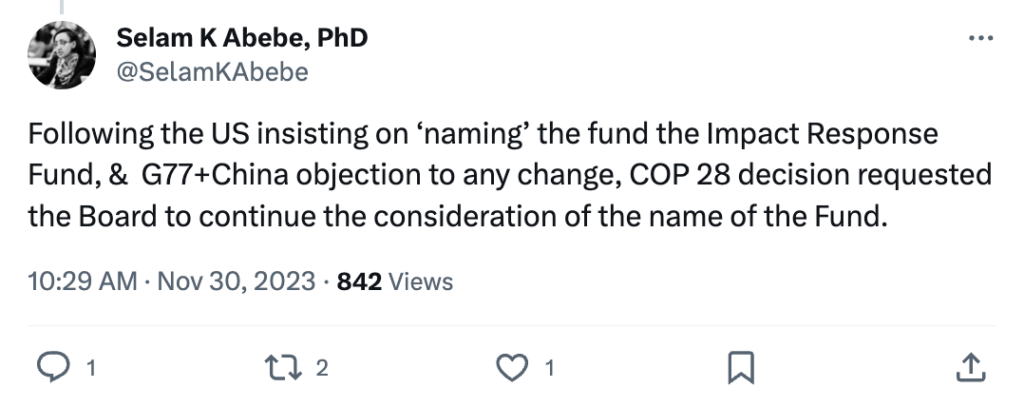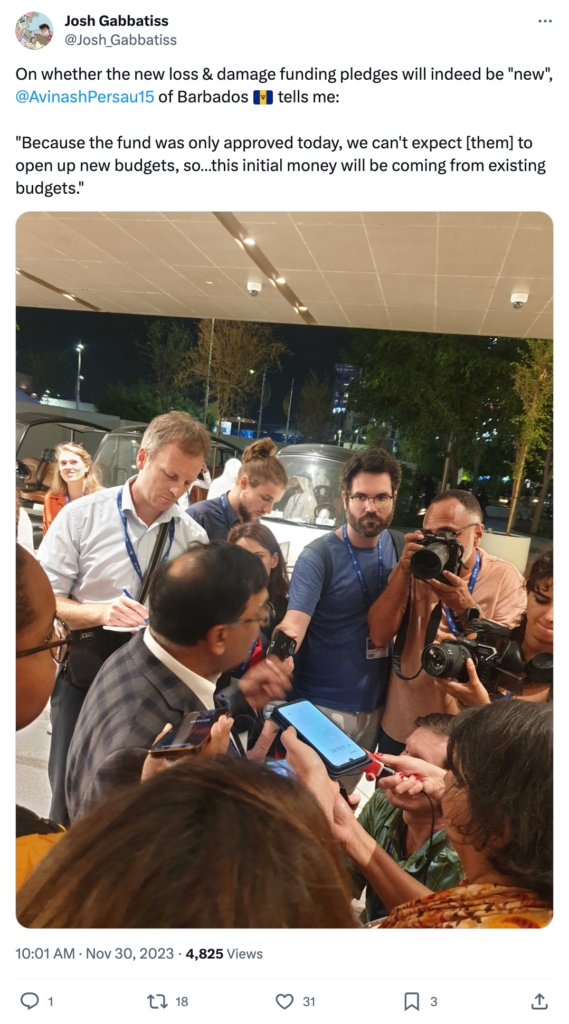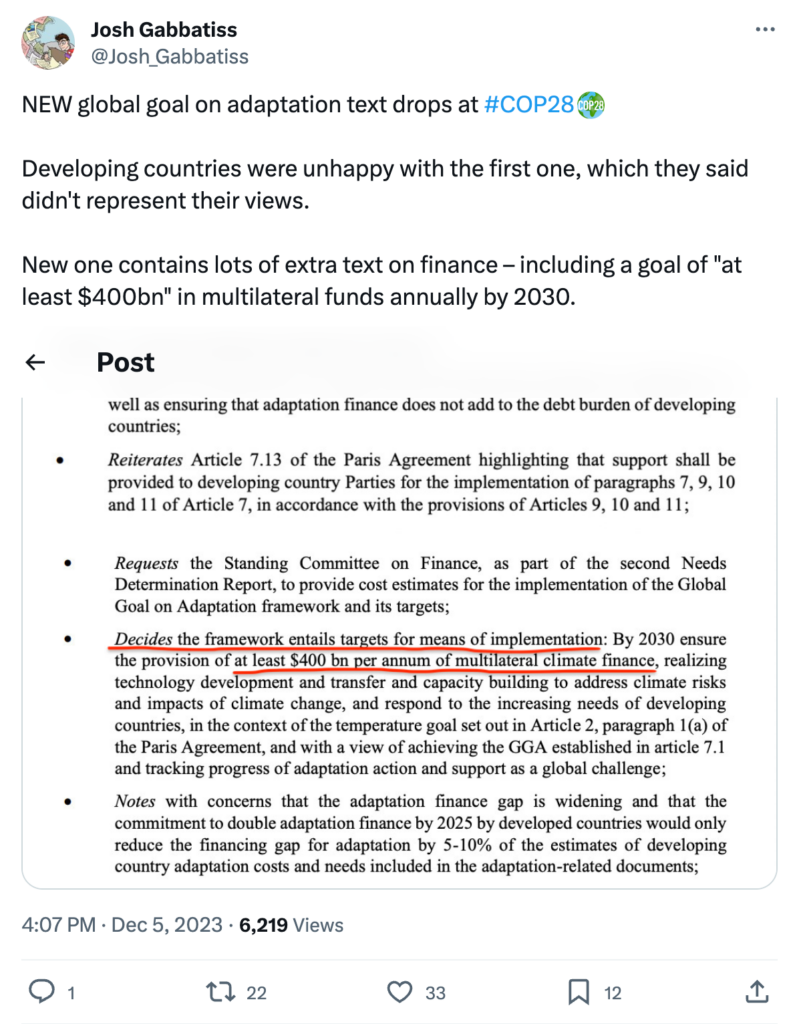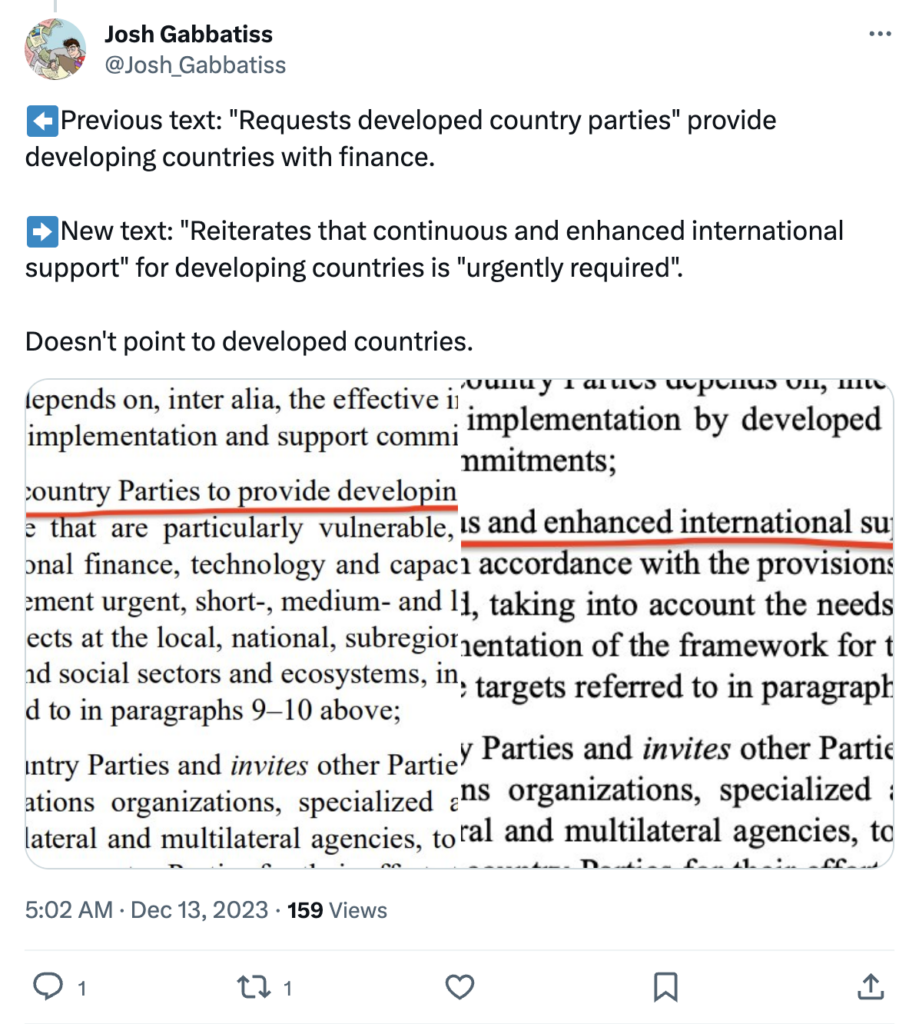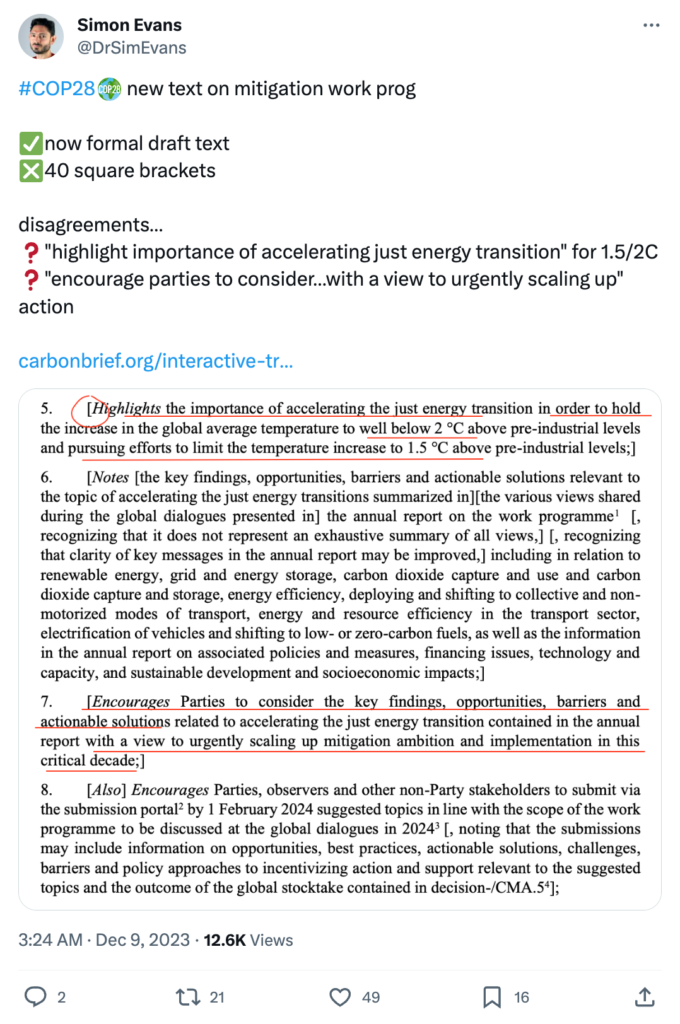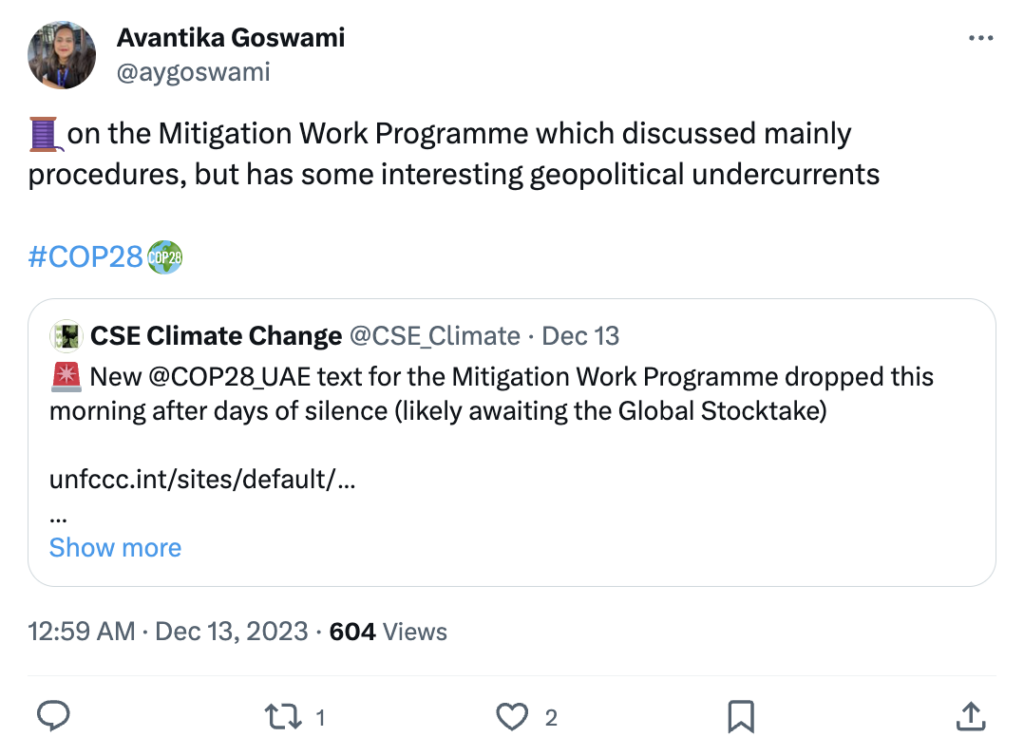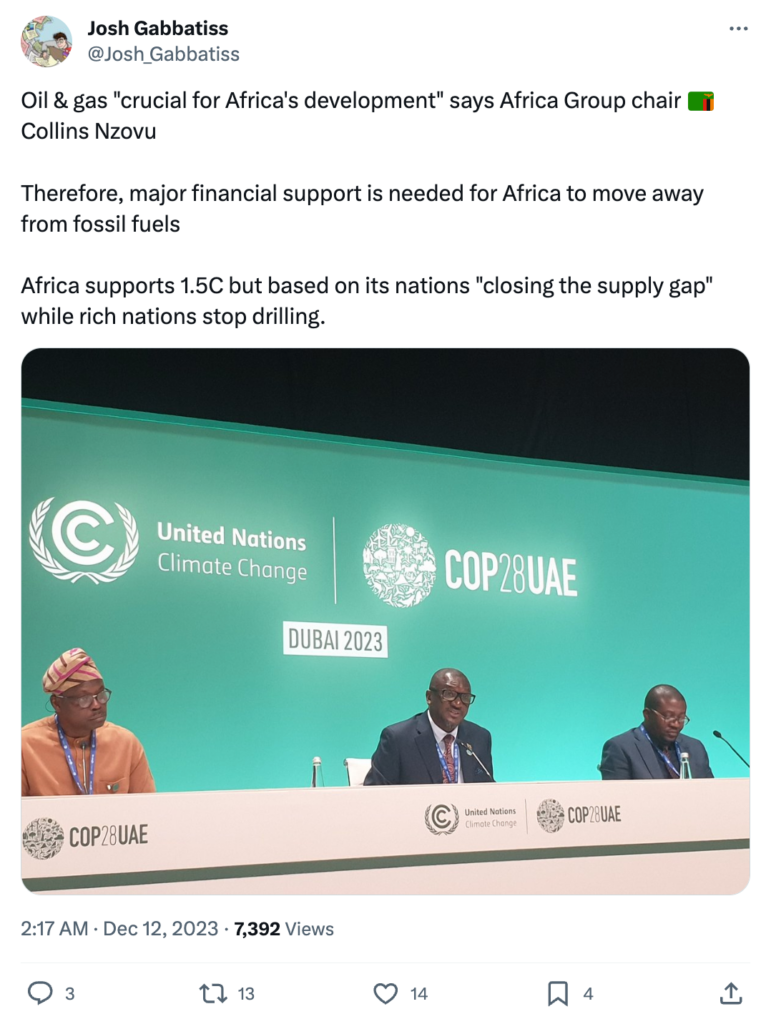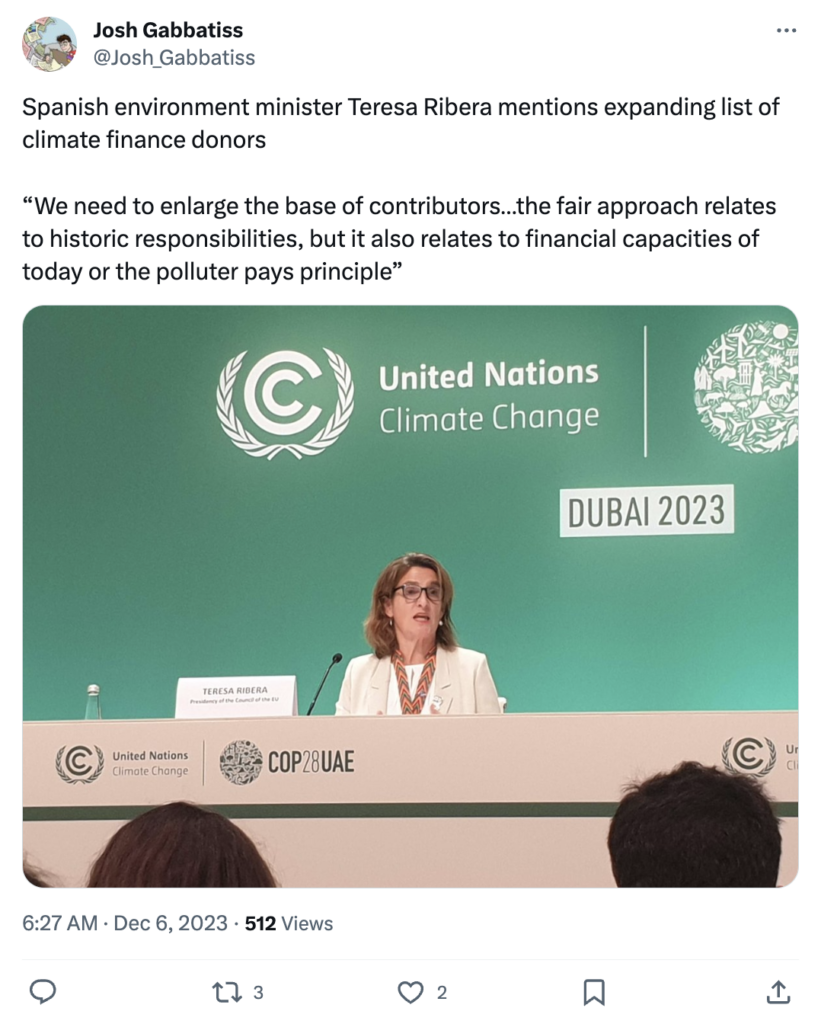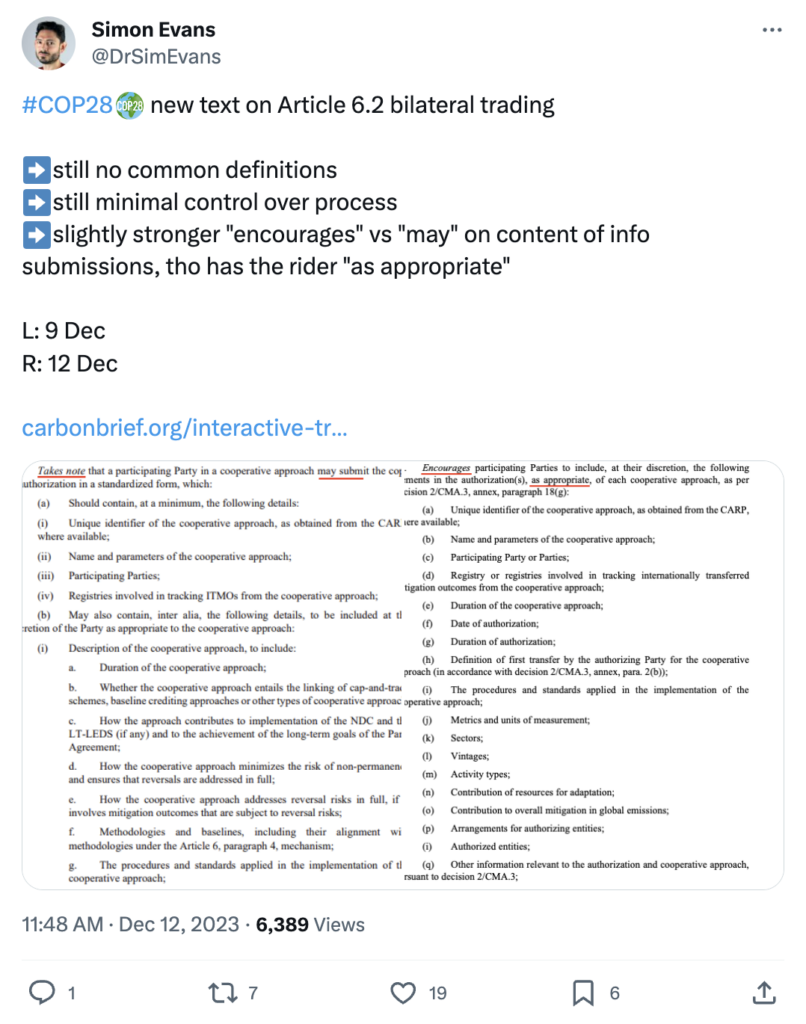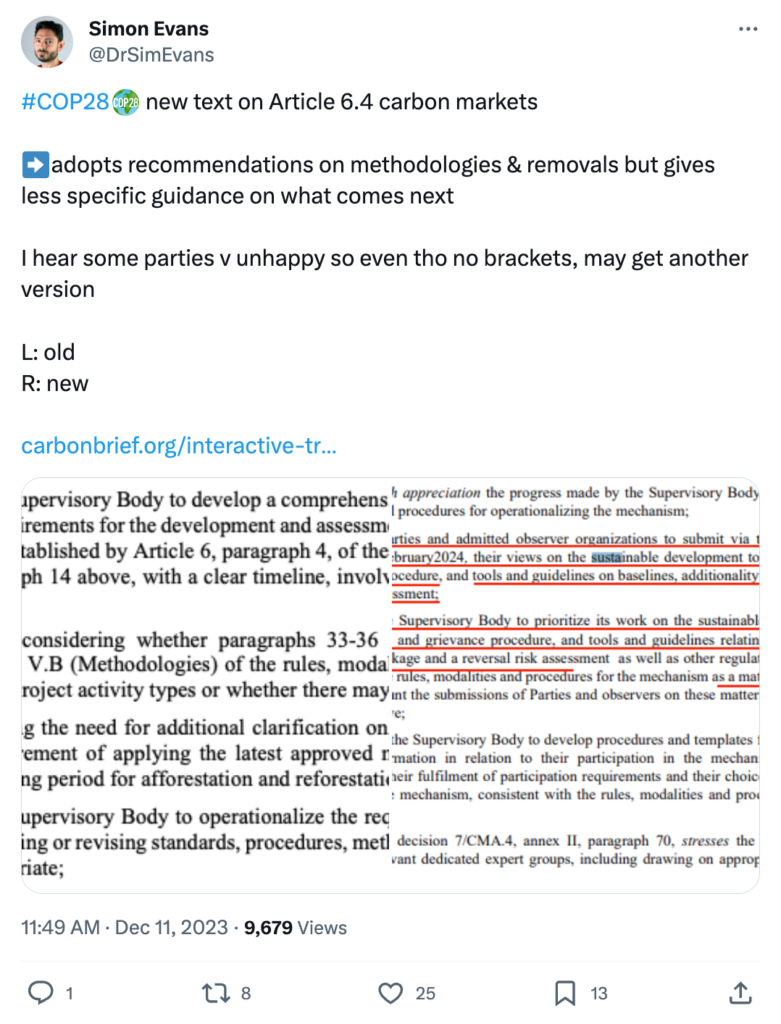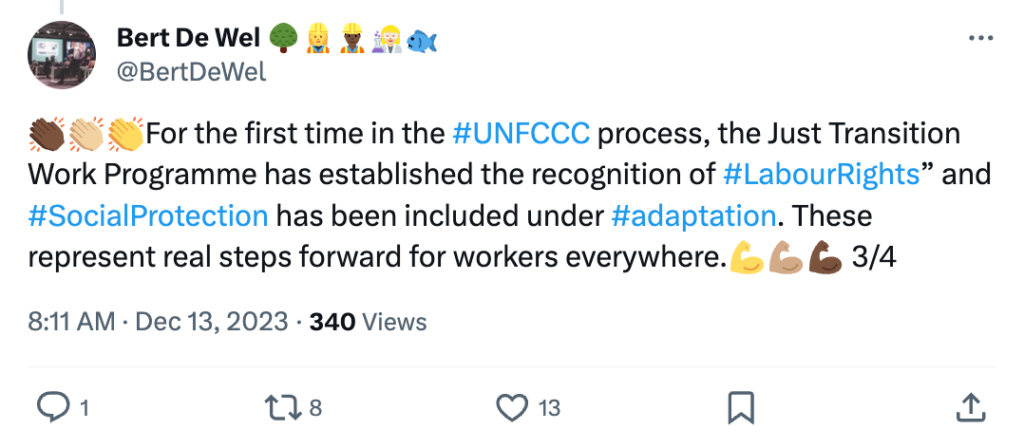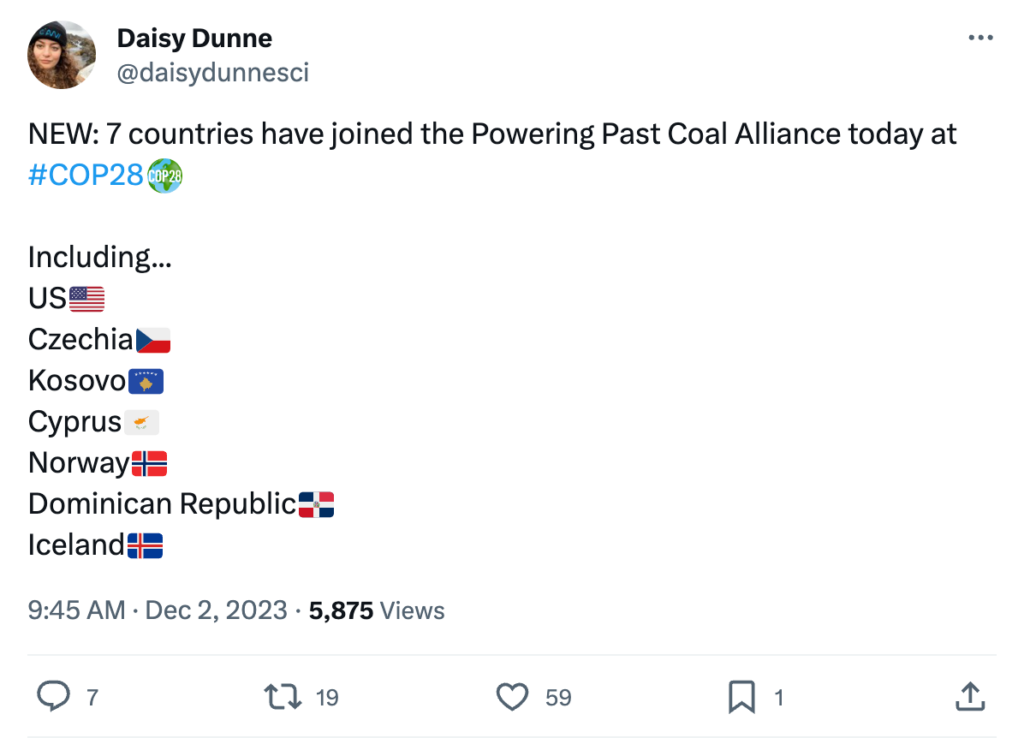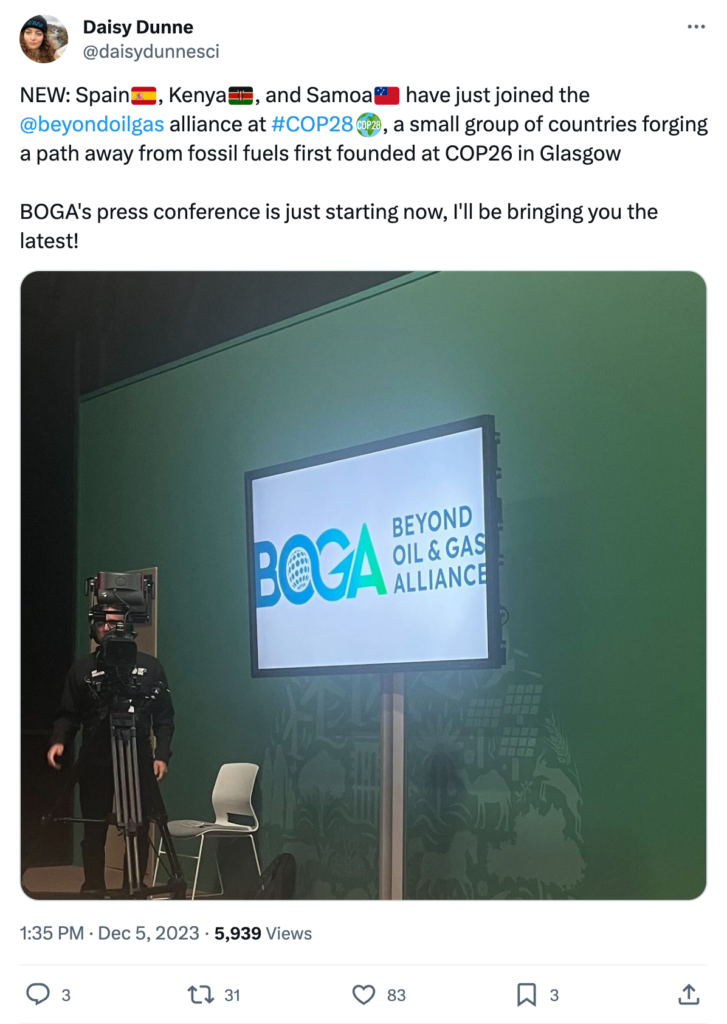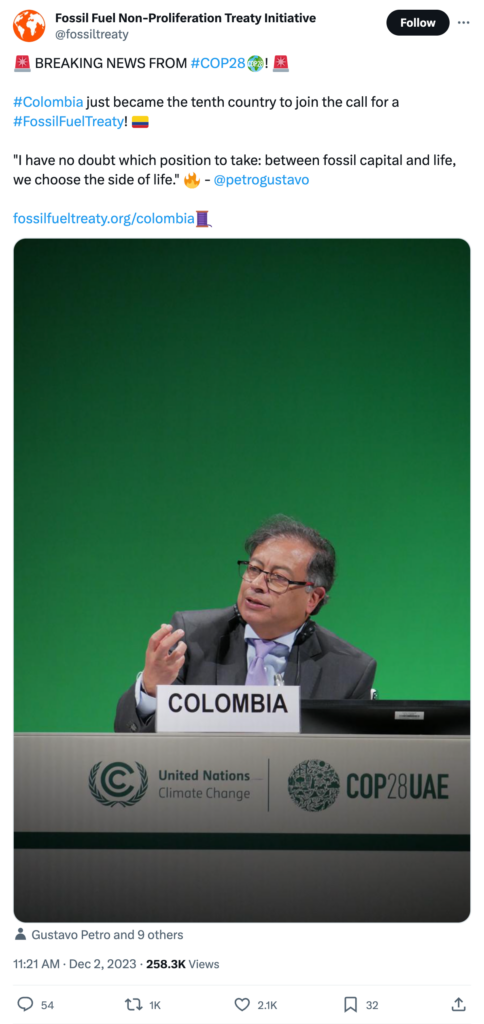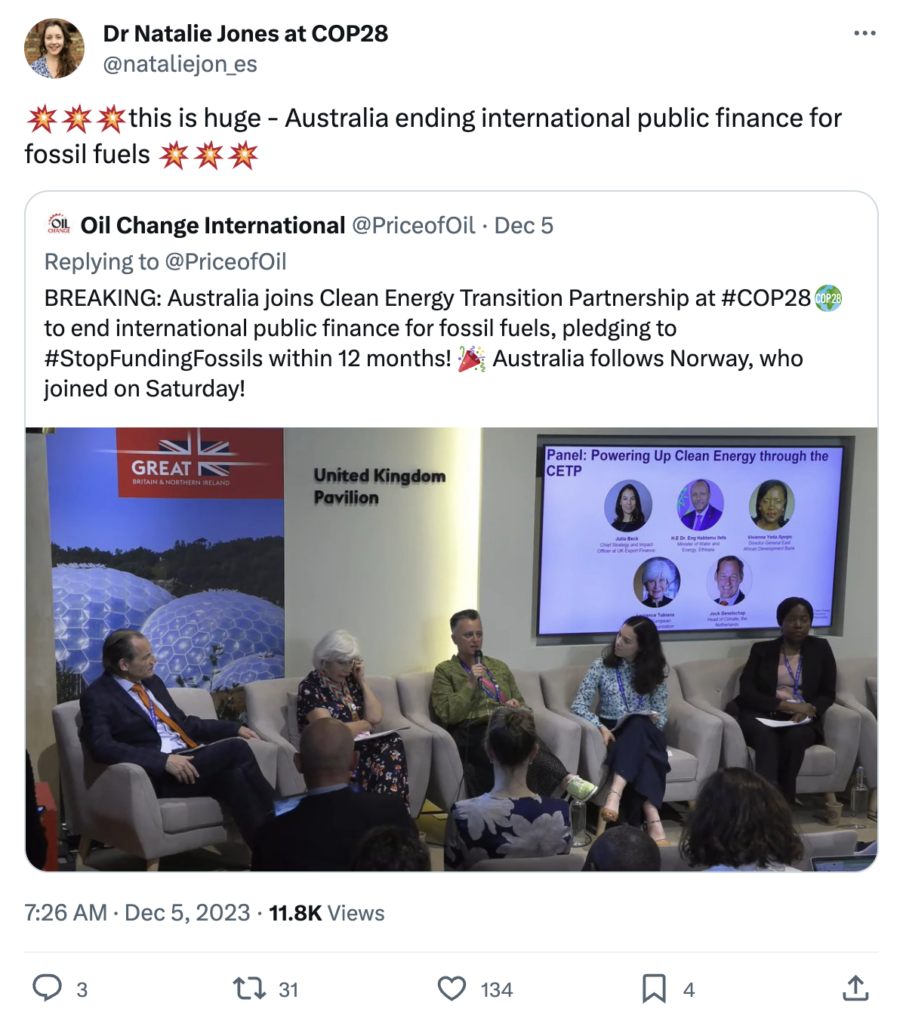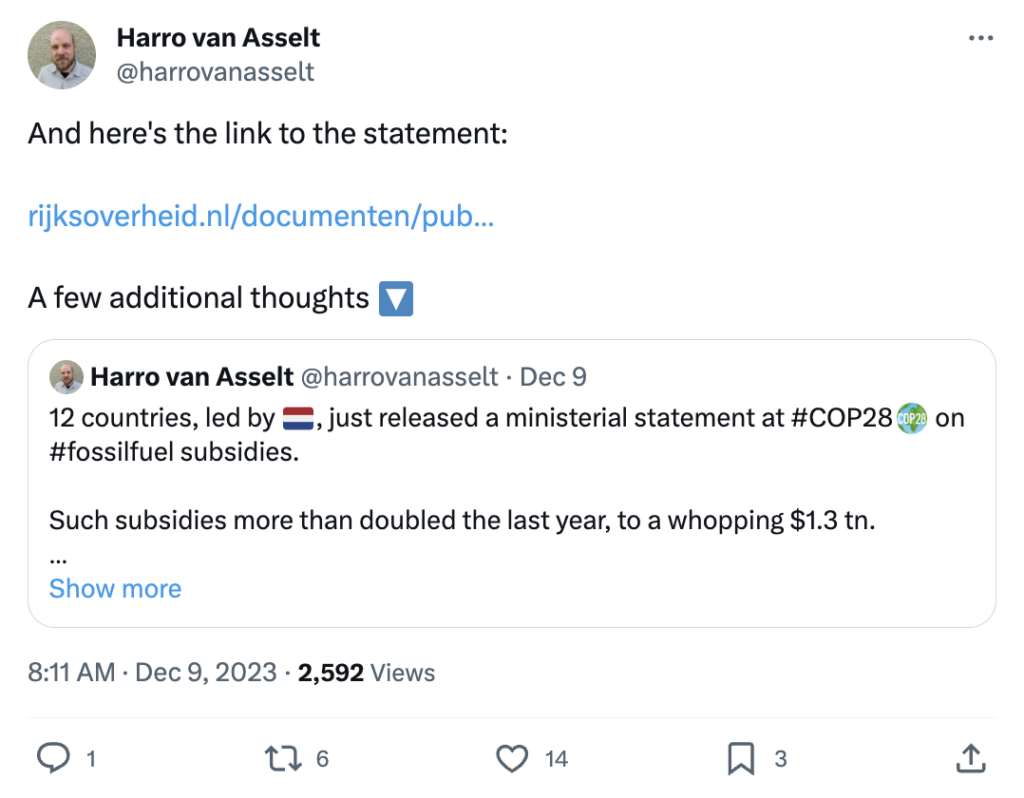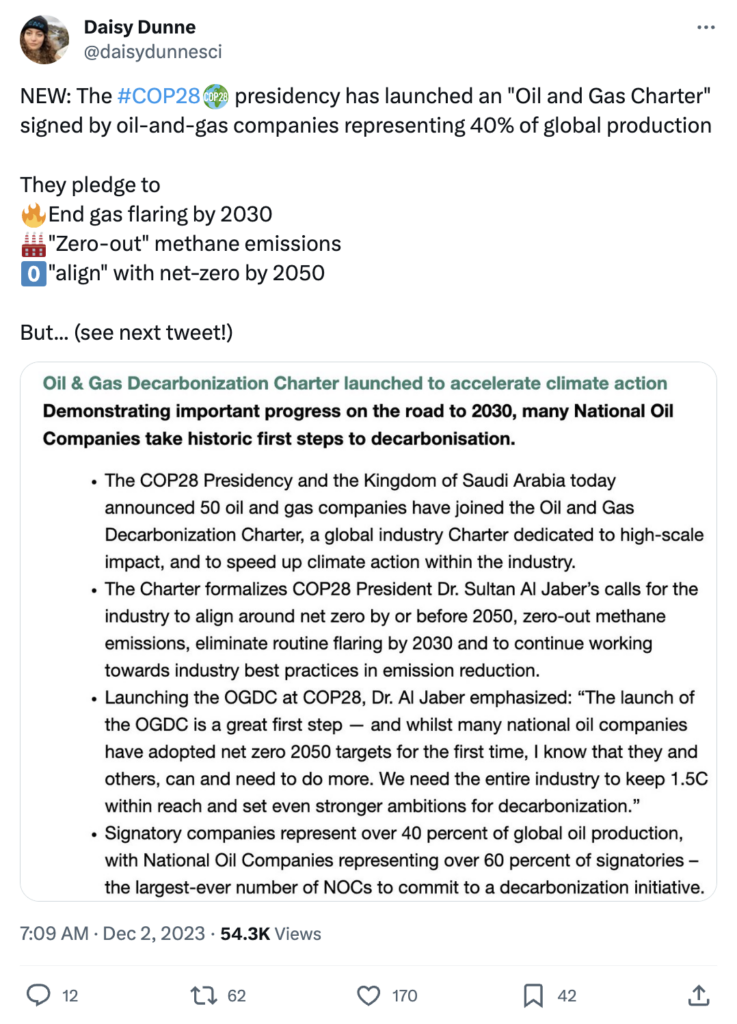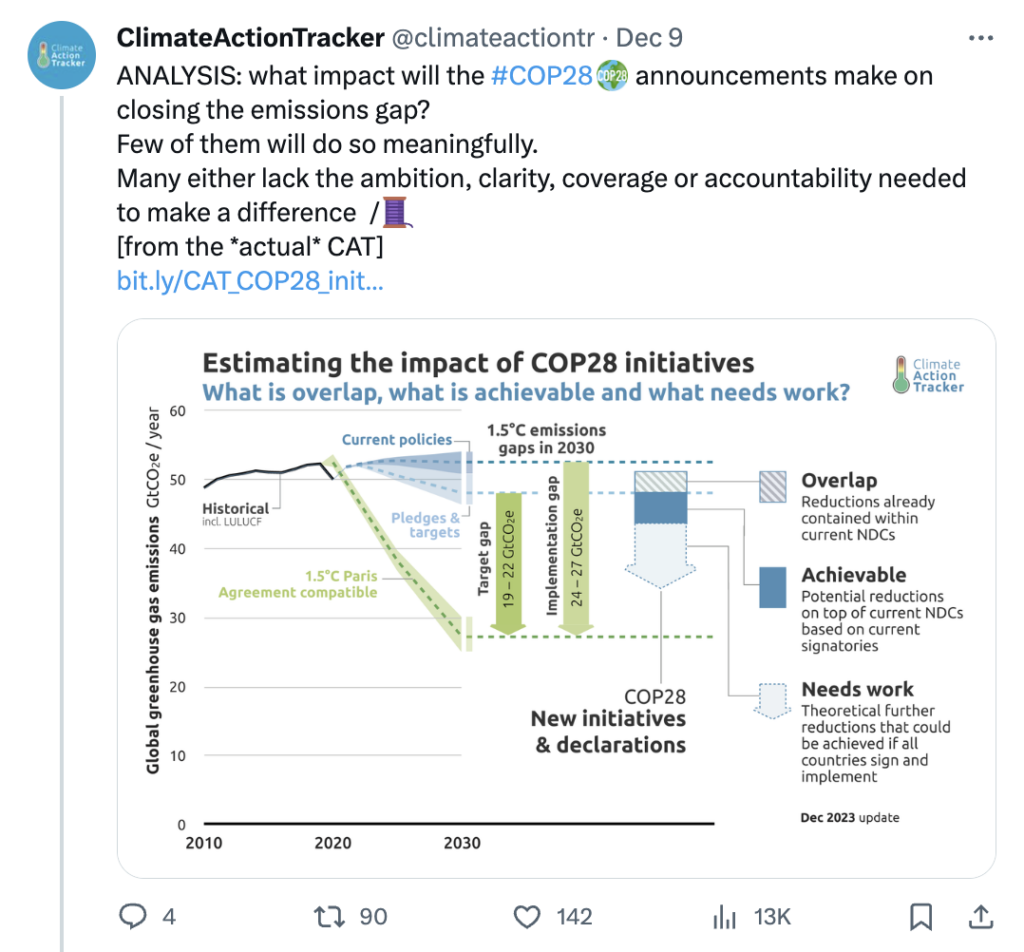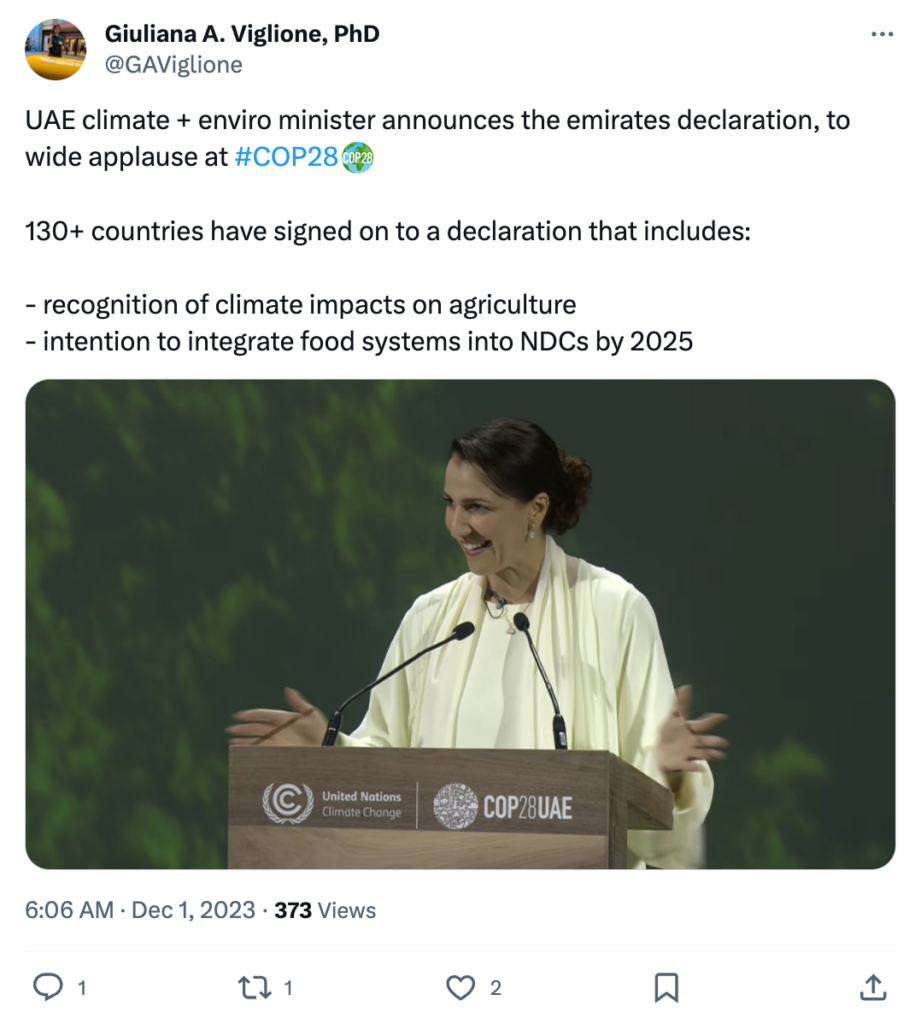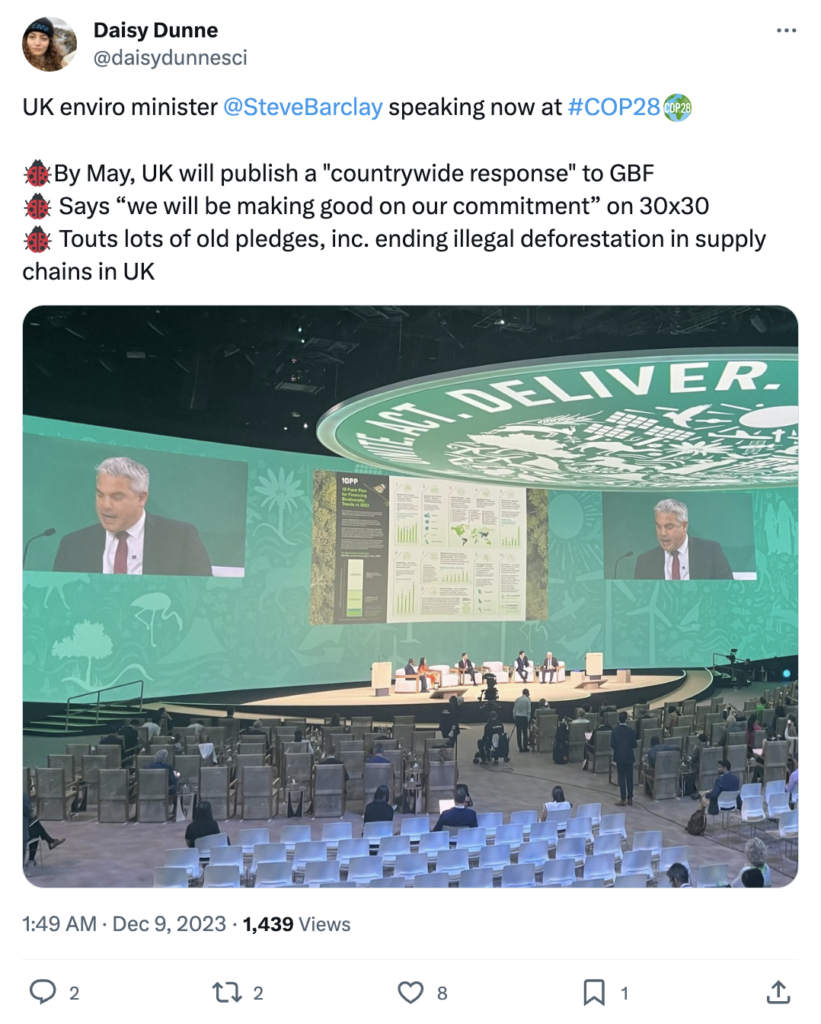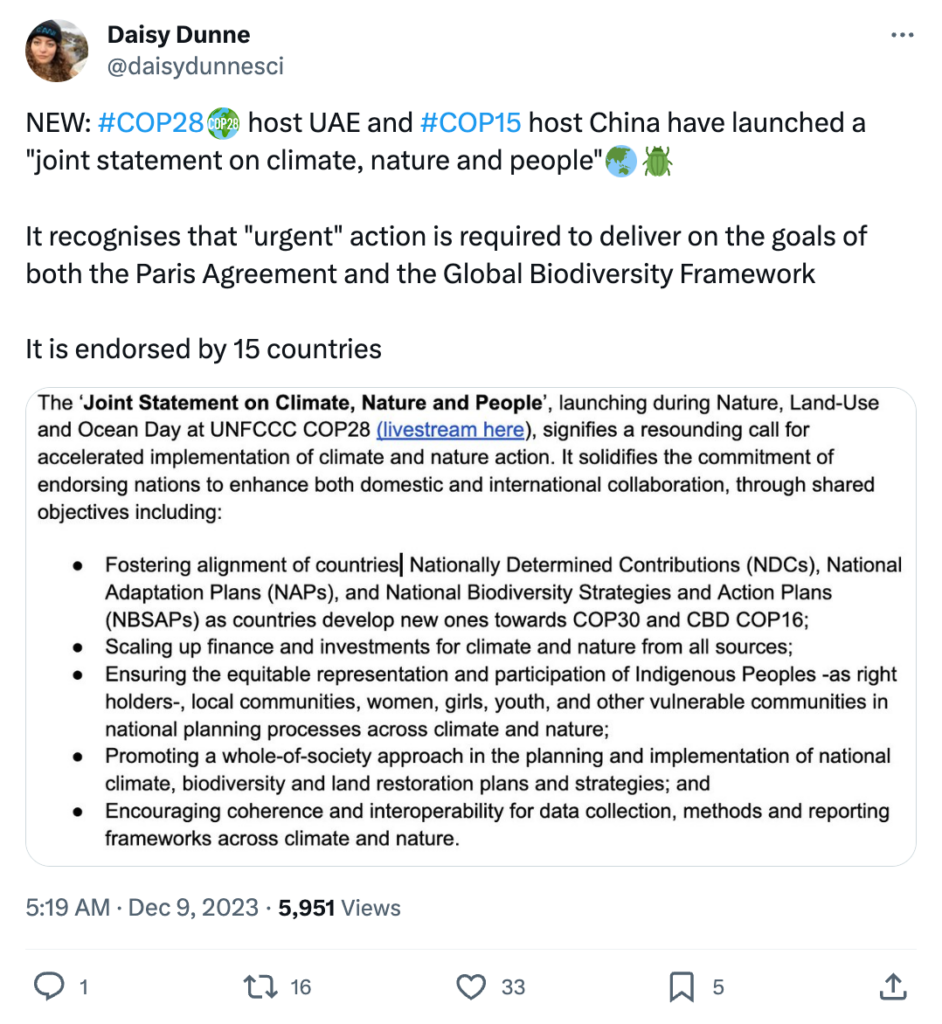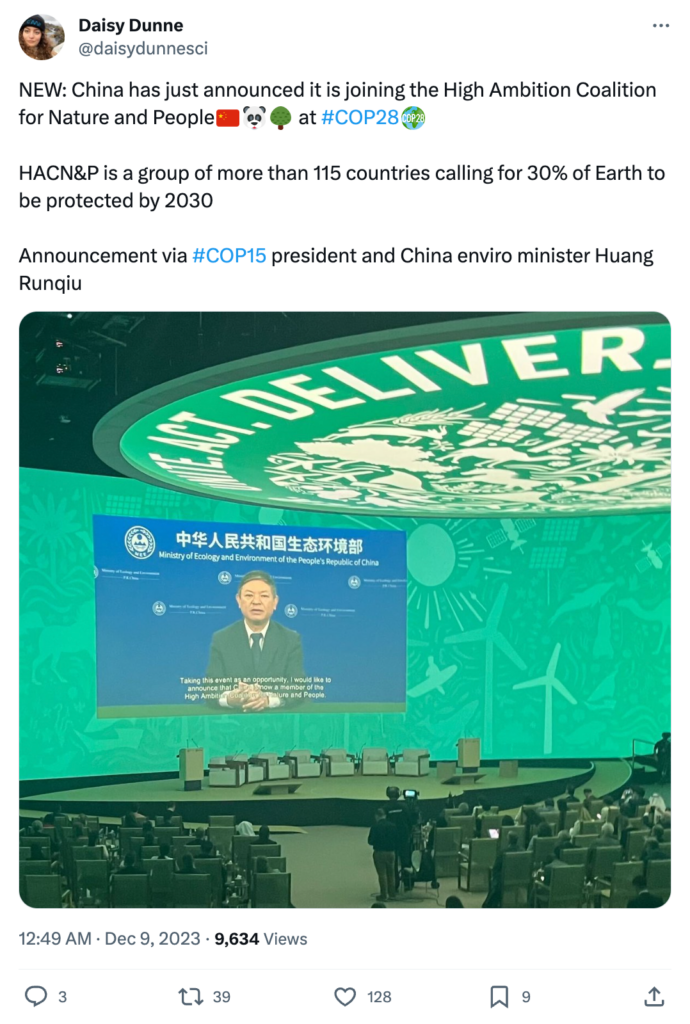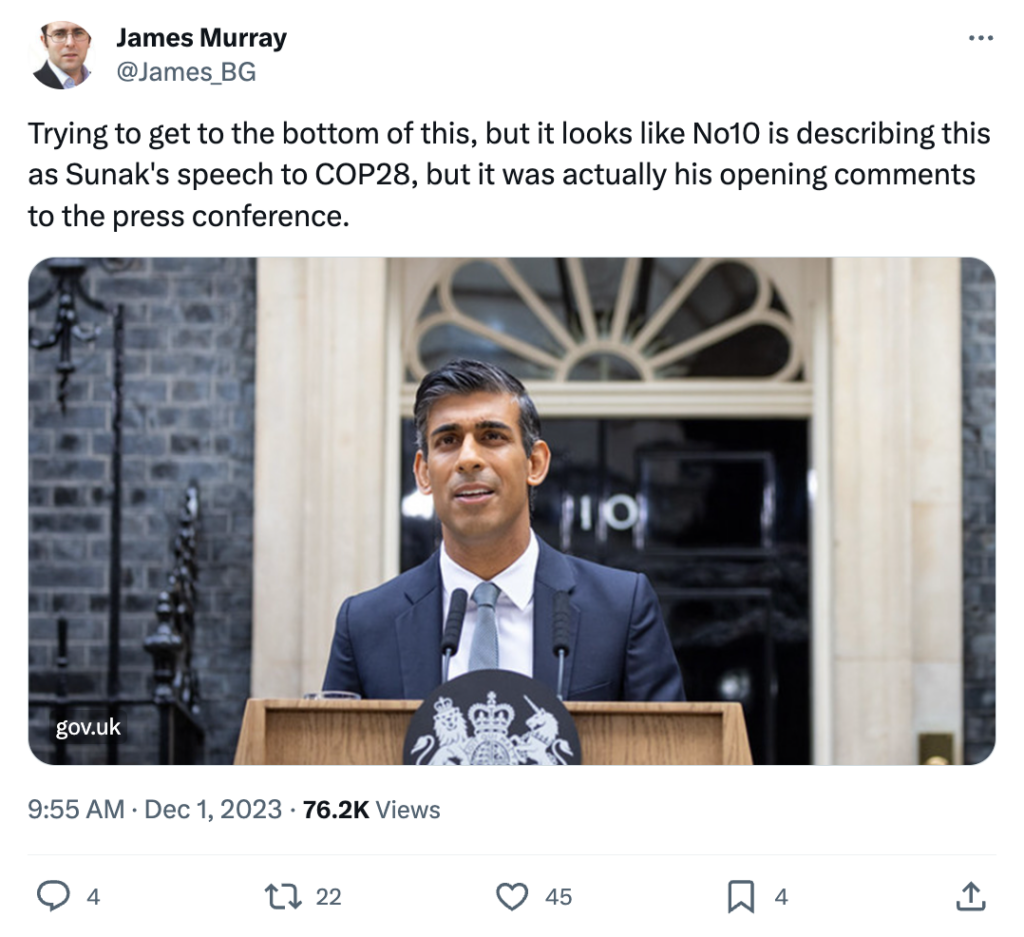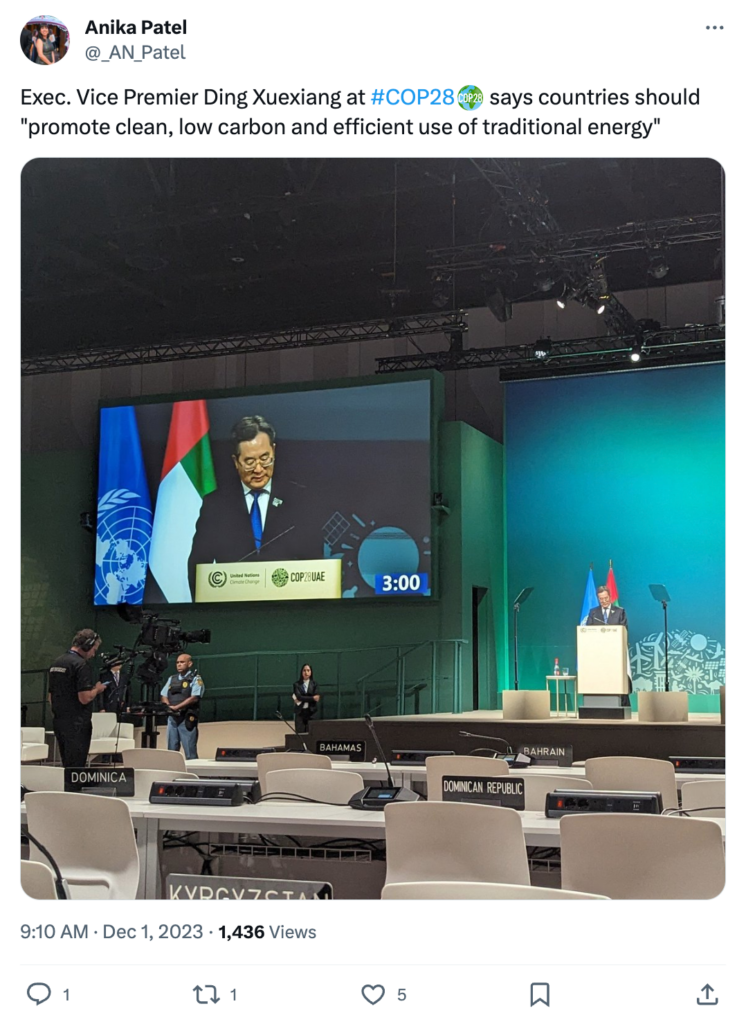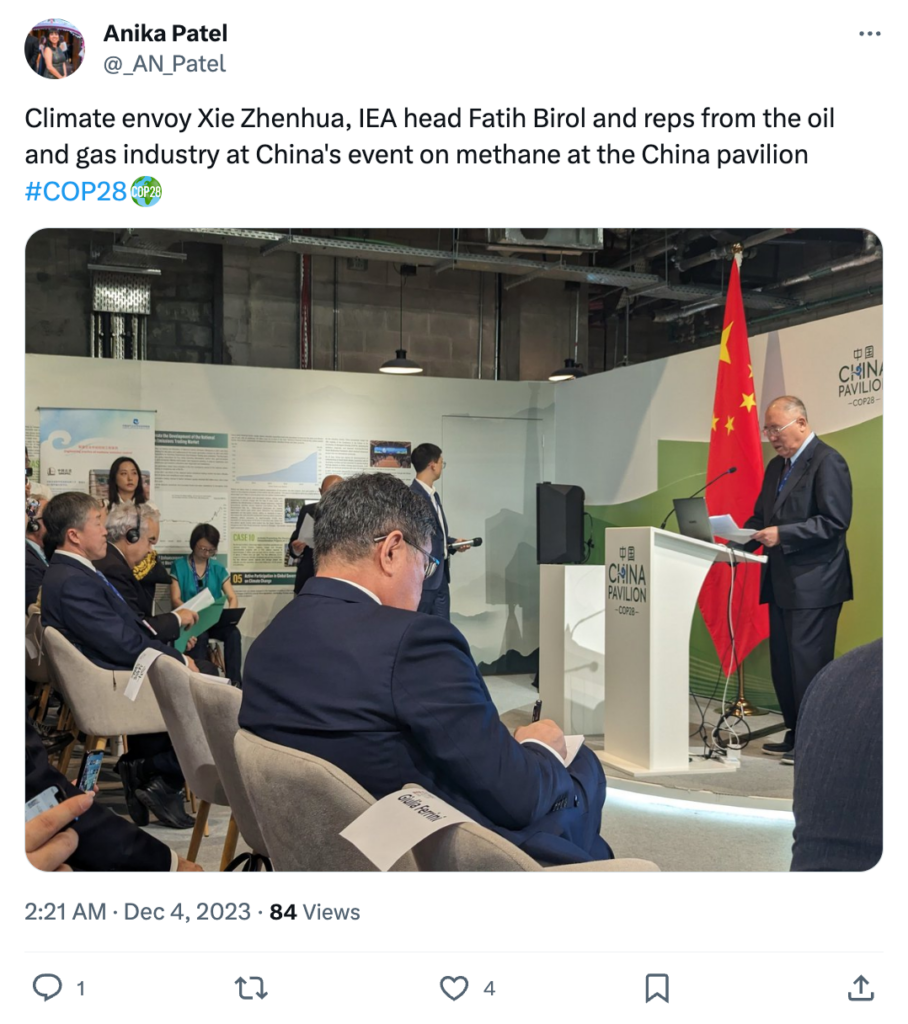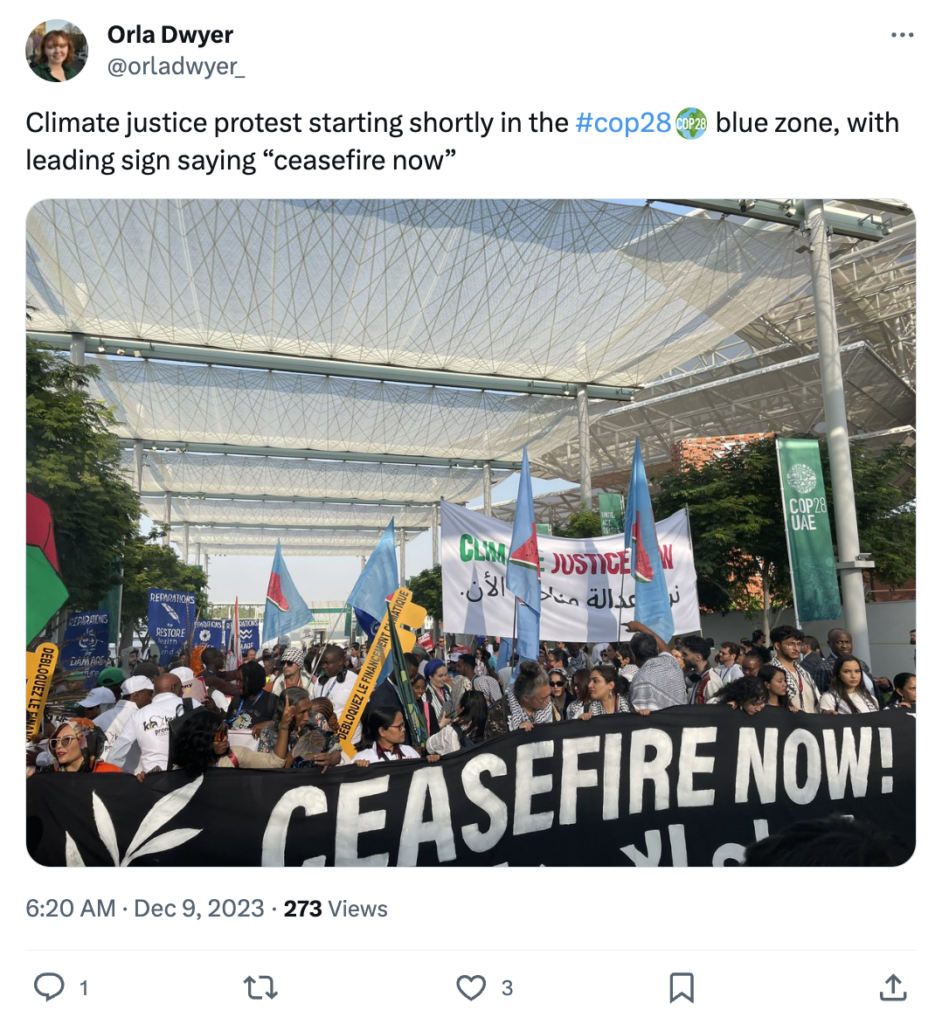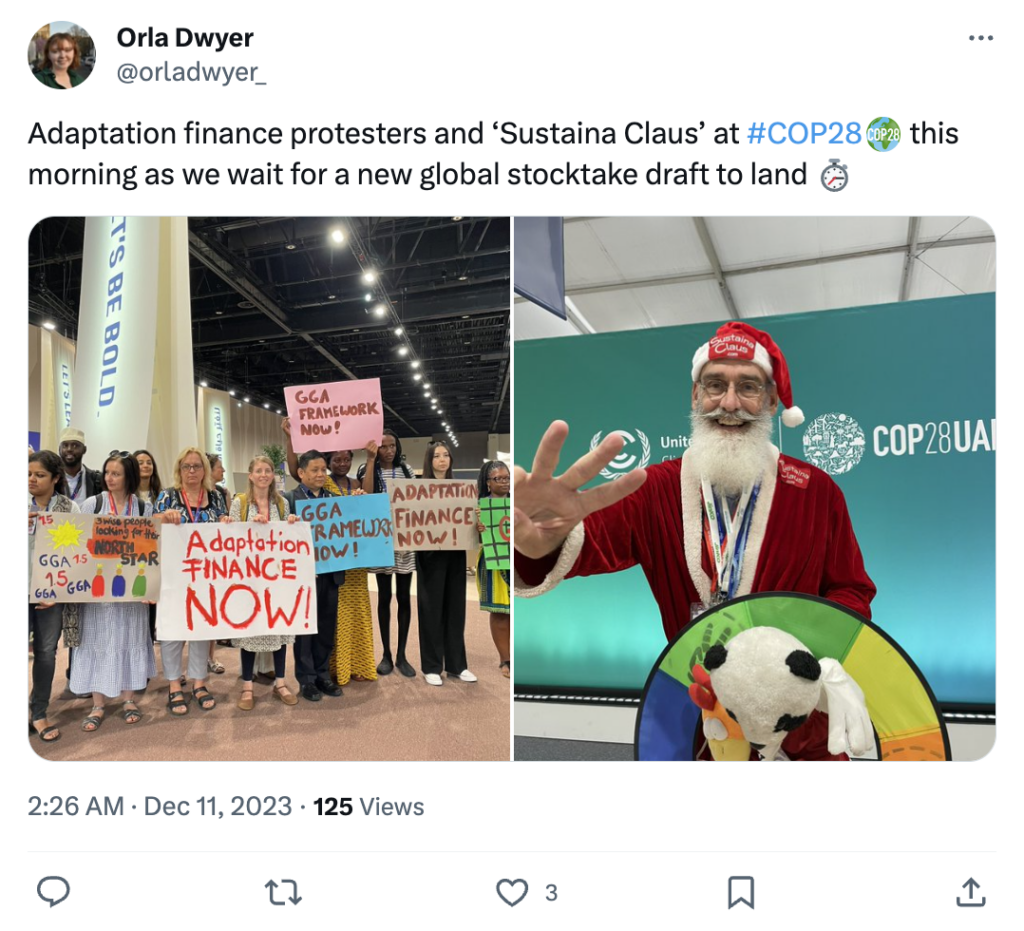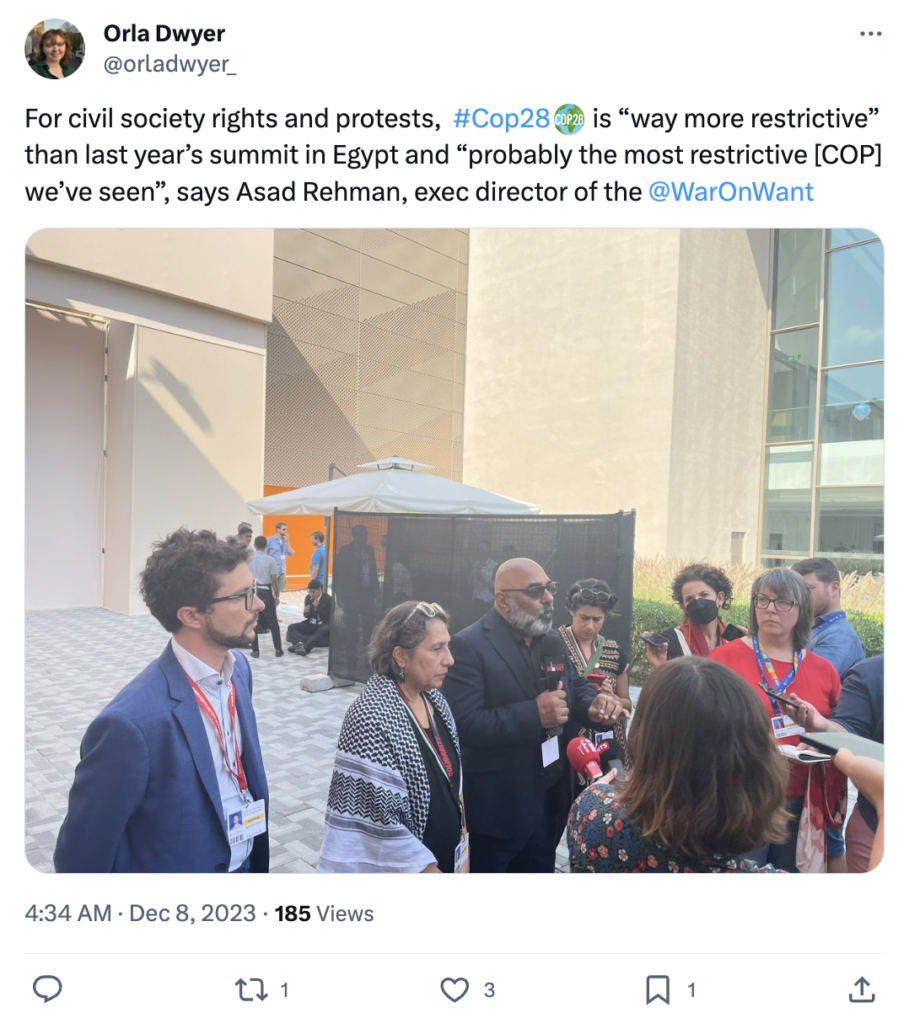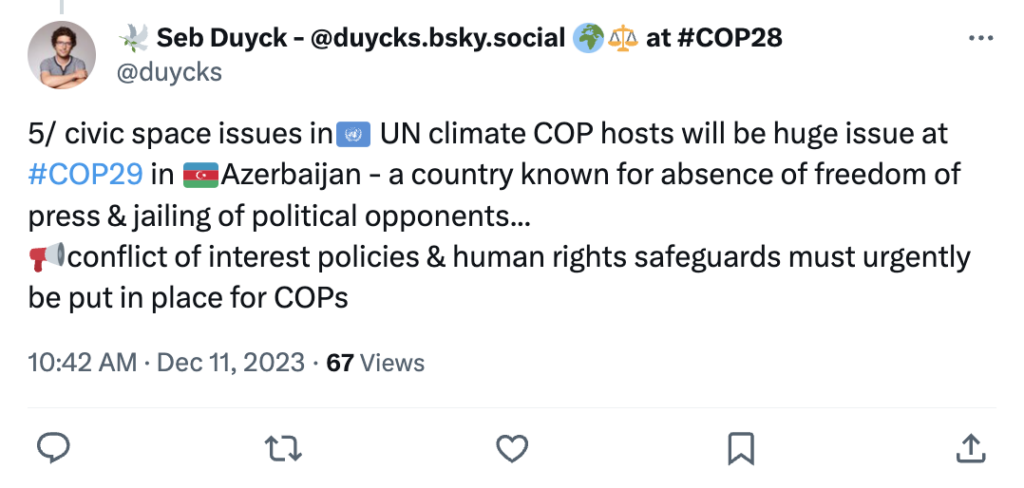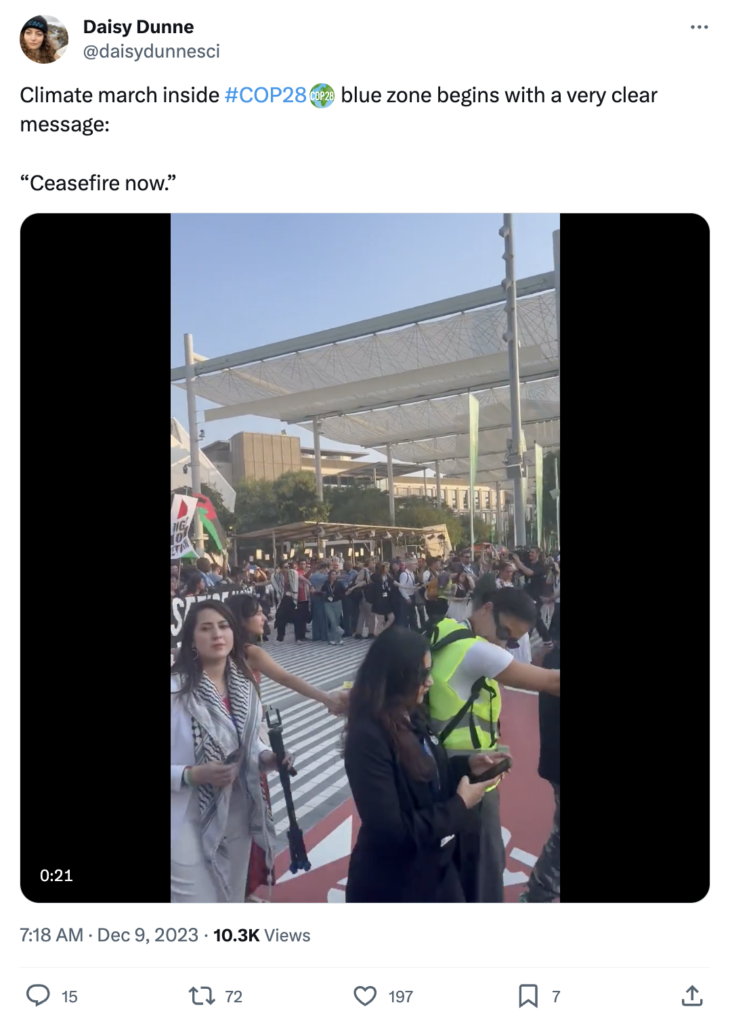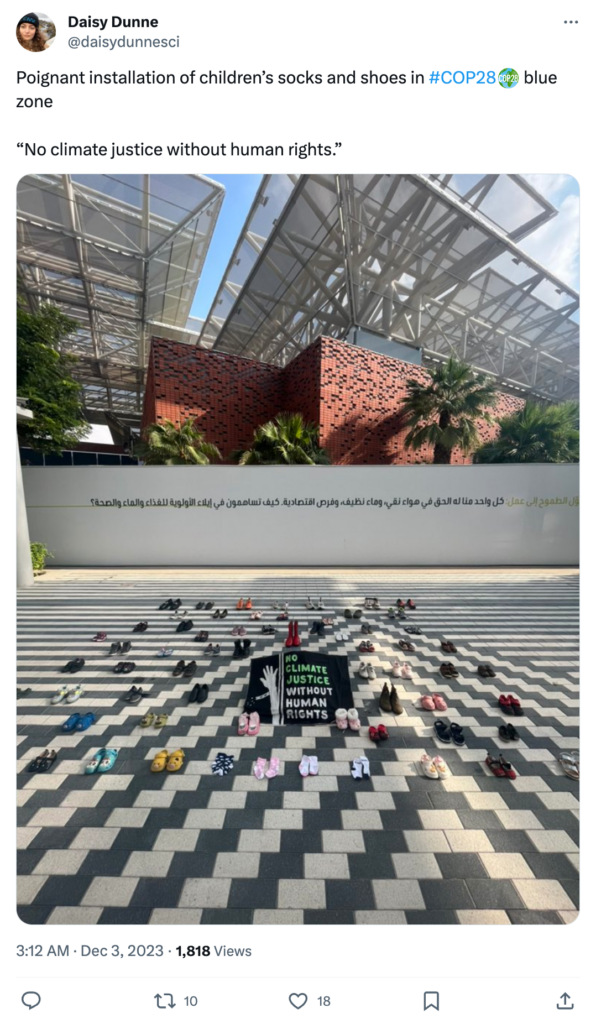COP28: Key outcomes agreed at the UN climate talks in Dubai – Carbon Brief
[ad_1]
Nearly every country in the world has agreed to “transition away from fossil fuels” – the main driver of climate change – at the COP28 climate summit in Dubai.
It is the first time such an agreement has been reached in 28 years of international climate negotiations.
The commitment is included in the first “global stocktake” of how countries can accelerate action to meet the goals of the landmark Paris Agreement.
However, many countries walked away from the talks frustrated at the lack of a clear call for a fossil-fuel “phase-out” this decade – and at a “litany of loopholes” in the text that might enable the production and consumption of coal, oil and gas to continue.
Despite an early breakthrough on launching a fund to pay for “loss and damage” from climate change, developing countries were left disappointed by a lack of new financial commitments for transitioning away from fossil fuels and adapting to climate impacts.
COP28 president and oil executive Dr Sultan Al Jaber hailed the “world-first” achievement of getting “fossil fuels” in a UN climate change agreement.
However, his presidency was overshadowed by allegations the UAE intended to use COP28 to make oil-and-gas deals.
Away from the negotiations, COP28 brought a wave of new international pledges – covering everything from oil-and-gas company emissions and tripling renewables, through to food systems and how the world can better integrate action on climate change and biodiversity loss.
Here, Carbon Brief provides in-depth analysis of all the key outcomes in Dubai – both inside and outside the COP.
Formal negotiations
Emirati leadership
UAE ruler Sheikh Mohammed bin Rashid Al Maktoum announced that Dubai would host COP28 in November 2021. The UN climate change presidency is rotated around the world, with the UAE representing the Asia-Pacific region.
Dr Sultan Al Jaber was appointed COP28 president-designate in January of this year. The appointment of the head of the UAE’s state-owned oil company, the Abu Dhabi National Oil Company (ADNOC), to the role of arbiter of climate talks immediately sparked outcry.
According to Reuters, Greta Thunberg called Al Jaber’s appointment “completely ridiculous”, while former US vice president Al Gore said fossil-fuel interests had taken over COP.
In May, more than 100 US lawmakers and members of the European parliament called for his removal, the Financial Times reported.
Some, including US special climate envoy John Kerry, called the criticism of Al Jaber “unfair” and said it was important that oil-producing countries are included in the COP process.
In the days ahead of the summit, pressure on Al Jaber intensified after an investigation by BBC News and the Centre for Climate Reporting alleged that the UAE planned to use its role as COP host to strike “secret” oil-and-gas deals behind the scenes of the summit.
On Twitter, former UN climate chief Christiana Figueres said the COP28 presidency had been “caught red-handed” and “will be under public scrutiny like no other ever before”. A COP28 advisory board member resigned over the allegations, Reuters reported.
The UAE’s COP28 team at first refused to deny the allegations to BBC News and said that “private meetings are private”. After the story’s release, Al Jaber released a statement saying that the allegations were “false, not true, incorrect and not accurate”, Bloomberg reported.
Al Jaber officially assumed the role of president during the summit’s opening on 30 November, taking over from Egypt’s COP27 president Sameh Shoukry.
In his first address to delegates, he vowed that this COP would leave “no issue off the table”, including “the role of fossil fuels” in driving climate change. (His remarks were misinterpreted by some as meaning he wanted fossil fuels to play a role in the solution to climate change.)
On the opening day, the COP28 presidency scored two big wins. First, it oversaw a new agreement on the operationalisation of a fund to pay for the loss and damage caused by climate change. (See: Loss and damage.)
This was a big priority for many parties arriving in Dubai, as illustrated by Carbon Brief’s interactive table of who wants what from COP.
Second, the COP28 presidency managed to get countries to agree on the official agenda for the conference without a time-consuming fight.
(Some items, such as one on mountains and climate change and another on the impact of unilateral trade measures on climate action, were removed from the agenda, with the presidency promising they would be taken up elsewhere.)
These two early successes left space for a “fight” over fossil fuels at COP28, Catherine Abreu, founder and executive director of NGO Destination Zero told Carbon Brief. This was in contrast to COP27 last year, she added.
At an opening press conference, Al Jaber touted the agreement on loss and damage as a “unique unprecedented achievement”.
In response to questions from journalists about his possible conflict of interest as an oil executive, he stated that he had invited countries to include the role of fossil fuels in negotiated texts, adding:
“You’re going to see full transparency and we will deliver what parties reach consensus on.”
The next day, the COP28 presidency and the International Energy Agency (IEA) launched a joint statement acknowledging that “fossil fuel demand and supply must phase down this decade” – the clearest signal yet that the UAE would, against expectations, facilitate ambitious action on fossil fuels at the talks.
The same day, a first early draft of the global stocktake text was released (the key agreed outcome from the summit, see: Global stocktake). It was the first UN document of its kind to include references to phasing out fossil fuels. (All of the COP28 texts can be viewed in Carbon Brief’s text tracker.)
However, crisis gripped the presidency again when remarks Al Jaber made regarding the science of phasing out fossil fuels during a live online event in November resurfaced in a story by the Guardian and the Centre for Climate Reporting. On video, Al Jaber said:
“There is no science out there – or no scenario out there – that says the phase-out of fossil fuels is going to achieve 1.5C.”
The remark sparked fierce backlash from the scientific and political community.
The next day, Al Jaber faced journalists during a highly unusual COP press conference attended by Carbon Brief.
Sat at a table flanked by Intergovernmental Panel on Climate Change (IPCC) chair Prof Jim Skea, he told reporters:
“We’re here because we very much believe and respect the science…Everything this presidency works on is centred around the science.”
At the press conference, Al Jaber also criticised the media for focusing on oil-and-gas deal allegations and his resurfaced remarks, while – in his opinion – omitting the presidency’s stated commitments to including language around fossil fuels in the negotiated texts.
The start of the second week saw the negotiations take centre stage.
The COP28 presidency announced a series of ministerial pairings to take discussions forward, as usual at UN climate summits. (Unusually, the presidency appointed the ministerial pairings six months in advance in a bid to speed up progress.)
When the ministerial pairings produced little progress, the presidency attempted to push talks forward by holding a “Majlis” on 10 December – an “Emirati tradition of bringing together a small, curated group to discuss specific challenges in an open, bold, and solutions-oriented way”, according to the UAE.
(At the summit’s end, Al Jaber said the Majlis made “all the difference” in agreeing the outcome of COP28. One seasoned COP observer told Carbon Brief they had been “pointless”, with countries merely restating existing positions.)
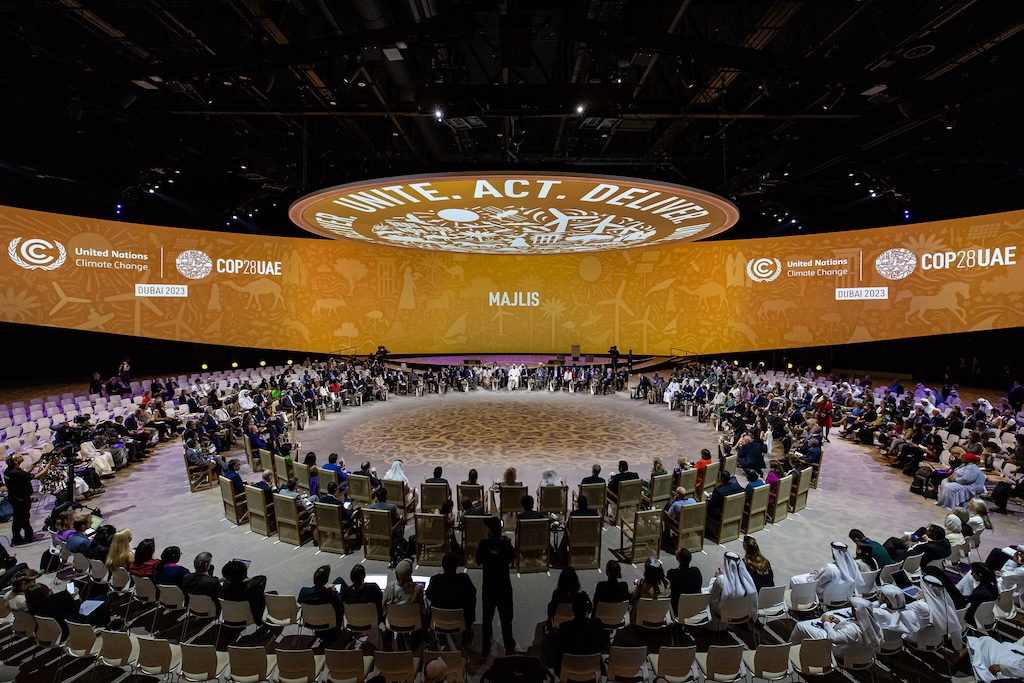
The next day – amid observers reporting that negotiations had fallen into “disarray” – the presidency launched another draft version of the global stocktake text. It was widely interpreted as being much less ambitious than previous iterations, sparking protests inside the venue and pointed reactions from parties ranging from the EU to small island states.
Amid the furore, negotiations ran over their scheduled finish time of 11am on 12 December.
Speaking to journalists on 12 December, COP28 director-general, Ambassador Majid Al Suwaidi, addressed the dissatisfaction with the global stocktake draft, saying:
“As you know, yesterday we released a text. As you also know, lots of parties felt it did not fully address their concerns. We expected that. In fact, we wanted the text to spark conversations…and that is what happened.”
Early in the morning of 13 December, a final draft of the global stocktake text containing language on transitioning away from fossil fuels was released to delegates. (See “global stocktake” for a full analysis of what it contained.)
A few hours later, a plenary session was held where the text was adopted with no objections at lightning speed – prompting hugs, cheers and celebration in the room.
Presenting the agreement to the world, Al Jaber said:
“Together, we have confronted realities and we have set the world in the right direction…Our country has shown that we can deliver on the global stage for the benefit of the planet and its people. We have helped restore faith and trust in multilateralism.”
However, small island states – a group that has played a historic role in furthering ambition to tackle climate change – stated their frustration that they were out of the room when the text was gavelled.
UN climate chief Simon Stiell summed at the progress at COP28 by saying:
“While we didn’t turn the page on the fossil fuel era in Dubai, this outcome is the beginning of the end.”
COP28 eventually ended at 5.11pm on Wednesday 13 December, just 23 hours over time.
In addition to running into overtime, “rule 16” was applied to 12 agenda items where agreement could not be reached – the same number as the 12 seen at COP25.
Global stocktake
At the heart of the COP28 negotiations was the culmination of the first-ever “global stocktake” under the Paris Agreement and, in particular, what it would say about fossil fuels.
In the end, the COP “call[ed] on” all countries “to contribute to” a list of goals, including “transitioning away from fossil fuels…accelerating action in this critical decade”.
After nearly 30 years, this is the first time a COP decision has explicitly called out all fossil fuels.
Nevertheless, the outcome fell short of the full “phase-out” many said was needed to stay below 1.5C, as well as in terms of the finance needed to support the transition.
The stocktake also calls on countries to contribute to the global tripling of renewable energy capacity and doubling of the rate of energy efficiency improvements by 2030.
Overall, the language in the stocktake text makes only limited calls to action, with most of the 196 paragraphs and 21 pages using non-operative verbs such as “recalls”, “notes” or “welcomes” that do not require any kind of response from countries.
It contains just eight “decides” and eight “calls on”, with the latter being the weakest of the various terms used to invite countries to take action in response to a COP decision.
The stocktake is a five-yearly process, designed to check progress against Paris goals and inform the next round of national climate pledges, known as nationally-determined contributions (NDCs).
It is a key part of the Paris “ratchet mechanism”, according to which countries must regularly ramp up climate action over time, until their collective goals can be met.
This process made COP28 the most important since COP21 in Paris, according to Liu Zhenmin, who is expected to be China’s climate envoy after veteran diplomat Xie Zhenhua retires. Liu told a 5 December side event at China’s pavilion attended by Carbon Brief:
“COP28 is the most important COP since the Paris Agreement, because the global stocktake will set the direction for future work on climate action.”
Similarly, US climate envoy John Kerry told a 29 November briefing the stocktake was “a unique opportunity…to rally the world to significantly step up our collective efforts to meet the goals of the Paris Agreement”. He said it needed to be “candid, strong, visionary, comprehensive”.
In the two years leading up to the summit, a technical stage of the stocktake had already shown that countries were falling far short of their collective climate goals.
The task for COP28 was to turn these stark findings into action.
Ahead of COP28, the co-chairs of the “subsidiary bodies” of the UN climate regime, SBSTA and SBI, wrote in a 17 November joint note that this was a “pivotal moment”. They said:
“The first global stocktake, a crucial process that has been examining, over the last two years, where the world stands collectively in meeting the objectives of the Paris Agreement, needs to conclude at COP28 with a comprehensive outcome that clearly identifies a path towards radical decarbonisation of our societies.”
In an opening press briefing attended by Carbon Brief, COP28 president Sultan Al Jaber said:
“We’re laser-focused on keeping 1.5C in reach and delivering an ambitious global stocktake.”
Al Jaber used these phrases – “laser-focused”, “ambitious stocktake” and his “north star” of “keeping 1.5C in reach” – repeatedly during the summit.
This appeared to be deliberate communications strategy, setting up those outcomes as key tests – albeit ambiguous ones – for the COP overall.
Al Jaber was not the only one to speak repeatedly of “keeping 1.5C in reach”. Rueanna Haynes, AOSIS lead stocktake negotiator, told a 4 December briefing attended by Carbon Brief that the process was the “only stocktake that matters” for keeping 1.5C in reach:
“We are here to make sure that this first-ever stocktake under the Paris Agreement is a success, because it is the only stocktake that matters for keeping the 1.5C goal within reach.”
(The stocktake informs the next round of NDCs, which run to 2035 or even 2040. By the next stocktake in 2028, the carbon budget for 1.5C will have been all but completely used up.)
At the same briefing, Tina Stege, Marshall Islands climate envoy, zoomed in on what keeping 1.5C in reach might actually mean, arguing that the stocktake was “the tool we have” to “course-correct” and “address the root cause of the problem, which is the burning of fossil fuels”.
For many countries and campaigners, then, fossil fuels were the key focus – particularly after efforts to include them in the outcome at COP27 in Egypt had failed.
Ahead of the talks in Dubai, 106 EU, African and island nations backed a fossil fuel phase-out, with this list expanding to “at least 127 countries” as the talks went on.
At a briefing held by Climate Action Network on day one of the talks, Romain Ioualalen, global policy campaign manager of NGO Oil Change International, said COP28 would only be a success if it delivered a decision on the phase-out of fossil fuels.
This phase-out needed to be “fast, fair, full and funded”, he added, flagging the need for support for developing countries, if they were to play their part in a global effort on fossil fuels.
In the first week of the talks, the stocktake was shepherded by co-chairs from the UK and Singapore, who had to turn hundreds of pages of submissions into a coherent document.
As Carbon Brief noted ahead of the summit, these submissions were “as varied as the COP negotiations themselves”, with one expert saying the stocktake risked becoming a “dumping ground” for “politically thorny issues” that might hamper its ability to drive real action.
The first iteration of the text delivered by the co-chairs reflected the diversity of inputs in a 12-page list of bullet points – effectively a laundry list of all the ideas put forward by parties.
On energy, it listed: “phase down/out fossil fuels, phase down/out/ no new coal, tripling renewables, doubling energy efficiency, the role of transitional fuels”.
The second version, issued on 5 December, fleshed out these bullets into 96 different “options” and ballooning to 24-pages – nearly as long as the entire 25-page Paris Agreement.
This version included three options: a fossil fuel phase-out; a phase out for “unabated” fossil fuels; or “no text”, meaning there would not be any wording on fossil fuels.
The day after this draft was issued, on 6 December, the head of the Opec oil producers’ cartel sent a letter to member states – later leaked to the press – urging them to “proactively reject any text or formula that targets energy ie fossil fuels rather than emissions”. It warned:
“It seems that the undue and disproportionate pressure against fossil fuels may reach a tipping point with irreversible consequences, as the draft decision still contains options on fossil fuels phase-out.”
Indeed, Opec members within the Arab Group of nations at the climate summit – including Saudi Arabia – were prominent among those opposing language on fossil fuel phase-out.
However, they were certainly not alone, with the group of Like-Minded Developing Countries (LMDC) including China and India also opposed – at least in part on the principled basis that, in their view, the stocktake outcome had no mandate to set sectoral targets.
At the end of the first week of the talks, the second iteration of the stocktake text was passed up to the ministerial level, accompanied by a compilation of views that parties felt were not yet reflected.
Later on the same day, 8 December, a third iteration came out, now with four options around fossil fuel “phase-out” and a fifth option for “no text”.
In total, this text ran to 27 pages and 206 paragraphs, containing 159 different options. As such, it remained more of a compilation of views than a clean set of choices for ministers to pick from.
Moreover, Carbon Brief understands that – beyond the “no text” option – this text did not reflect the views of those opposed to language on fossil fuels. As such, it represented the high point in terms of the wording on fossil fuel phase-out.
Three days later, on 11 December, the presidency itself released a new fourth version of the stocktake text. Fossil fuel “phase-out” was gone from the text, replaced with loose wording that “call[ed] on parties to take actions that could include” – making any response optional.
This text drew swift and near-universal condemnation, with David Waskow, director of international climate initiative at the World Resources Institute, telling a press briefing that the wording “could include” turned the text into a “choose-your-own-adventure approach to climate action”.
At a heads of delegation meeting that evening, Colombia, for AILAC, called the text “worrisome”, while Bangladesh for the Least Developed Countries (LDCs) said that the north star of 1.5C was “missing” and that the “language is weak and in places contradictory”.
According to RTE, EU finance negotiator Eamon Ryan threatened to walk out of the talks if the wording was not strengthened and said “that one word ‘could’ just kills everything”.
Those condemning this draft of the text including the US climate envoy John Kerry, the LDC chair, the UK, the International Energy Agency’s Fatih Birol, EU climate chief Wopke Hoekstra, COP26 president Alok Sharma, AOSIS, the German government and its climate envoy Jennifer Morgan.
Climate campaigners also reacted angrily to the text, holding an unauthorised protest at the COP28 venue where they called on negotiators to “hold the line”.
The fight over the stocktake language on fossil fuels was “not surprising”, said Dr Joanna Depledge, an expert on the international climate negotiations at the Cambridge Centre for Environment, Energy and Natural Resource Governance.
She told Carbon Brief as the talks were coming to a close:
“It’s crunch time. The climate change regime has been bypassing, avoiding, dodging, circumventing the need to phase out fossil fuels forever. The science and passage of time mean it just can’t do that anymore. And negotiators are being asked to bite the bullet, in Dubai, with a petrostate presidency.”
After hours of fevered speculation, including the wide circulation of a “leaked” draft that prompted the UNFCCC secretariat to deny its provenance, the fifth and final version of the stocktake text emerged in the small hours of 13 December.
The final stocktake deal, including the text on “transitioning away from fossil fuels”, came “after 12 hours of intense shuttle diplomacy”, said German climate envoy Jennifer Morgan.
It situates the call for “contributions to the following global efforts” in the context of the “need for deep, rapid and sustained reductions in greenhouse gas emissions in line with 1.5C”, as well as recognising “different national circumstances”.
However, beyond the loose “accelerating action in this critical decade”, the wording does not include any near-term targets, pointing only to net-zero emissions by 2050.
(After the text was released, some climate scientists argued the scope of “fossil fuels in energy systems” meant their use in industry or as chemical feedstocks was not included. Others noted that, regardless, energy systems covered more than 80% of oil and gas use.)
The figure below illustrates the development of fossil fuel language, through each version of the stocktake text at COP28. Note how, between the 11 December and final 13 December drafts, the wording pointing to “both consumption and production of fossil fuels” was lost.

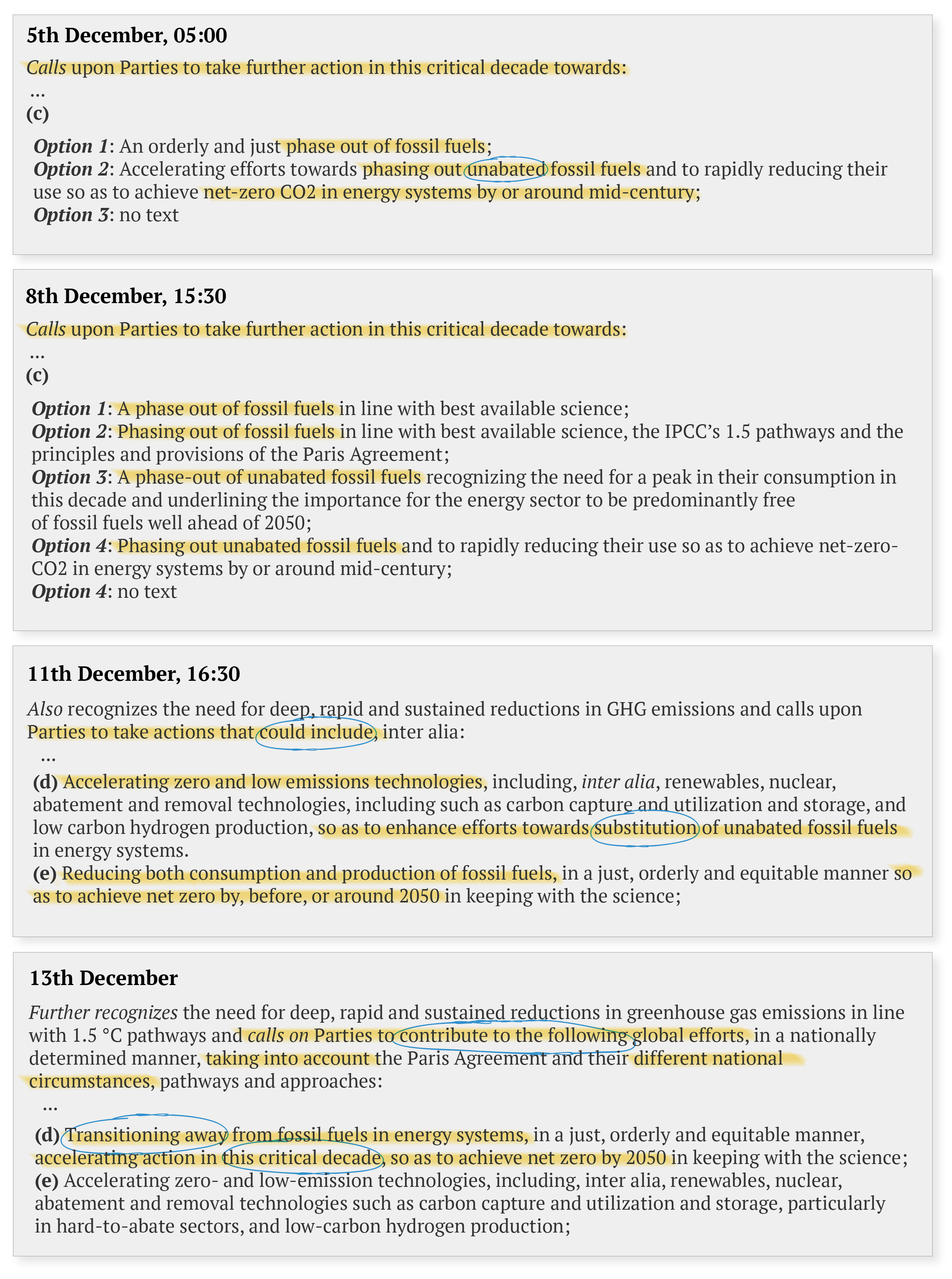
Although there was no agreement to phase out fossil fuels, many – though by no means all – reactions to the text were broadly positive.
Its adoption was greeted with a “sustained standing ovation and loud applause from across the room”, the Earth Negotiations Bulletin reported.
One developed country negotiator told Carbon Brief the outcome was “pretty strong given the circumstances”. They added:
“I think ‘transition away from’, with action in this critical decade and net-zero by 2050, sends a strong signal. The important thing now is delivering on it.”
German foreign minister Annalena Baerbock said the deal “marks the end of the fossil fuel era”. UN secretary general António Guterres responded to the text by attacking “those who opposed a clear reference to phase out of fossil fuels”, saying this was “inevitable”.
However, many noted that the deal came with very little in the way of climate finance to support developing countries “transitioning away” from fossil fuels.
Ahead of the COP, the IEA had promoted five “pillars” needed to get on track for 1.5C. The final stocktake went some way towards meeting four of them: tripling renewables; doubling efficiency; tackling methane; and an “orderly decline in the use of fossil fuels”.
However, the fifth pillar on finance for developing countries was largely missing. Responding to the deal, IEA chief Dr Fatih Birol said “greater efforts are needed on finance”.
Greater efforts in this area could have unlocked higher ambition on the other mitigation outcomes, Lola Vallejo, climate programme director for thinktank IDDRI told Carbon Brief. She added:
“It’s also a matter of balance and fairness – it’s a pretty big leap of faith to agree to targets without a recognition of the investment challenge alongside it.”
Others pointed to the continued approval of new fossil fuel extraction in developed countries – including the UK and the US – as well as the lack of clear differentiation in the stocktake text on who should be moving fastest to move away from fossil fuels.
In addition to the language on all fossil fuels, the final text repeats wording from COP26 on phasing down unabated coal power, but still does not define what “unabated” means. It also lacks wording from earlier drafts on ending permitting of new coal power.
The final text calls for the tripling of renewable energy capacity and doubling of the rate of energy efficiency improvements by 2030, though without the specific numerical targets that had appeared in earlier drafts.
(Along with cutting methane emissions from fossil fuel production, meeting these goals would provide 80% of the emissions cuts needed this decade to get on track for 1.5C.)
The text calls for “accelerating zero- and low-emissions technologies, including…carbon capture and utilisation and storage” (CCS), though this is tied “particularly” to “hard-to abate sectors”, weakly limiting the use of CCS as a cover for business-as-usual.
On non-carbon dioxide (CO2) greenhouse gases, the final text calls for “accelerating and substantially reducing” emissions “in particular methane emissions by 2030”. However, it lacks the numerical targets that had been in earlier drafts.
On fossil fuel subsidies, the text calls for the phasing out of “inefficient…subsidies that do not address energy poverty or just transitions, as soon as possible”.
Finally, the text “recognises that transitional fuels can play a role in facilitating the energy transition”. This wording, taken to refer to gas as a “bridge fuel”, was pushed by Russia.
Note, however, that it is in a separate paragraph, not linked to an operative verb in the text, as it is only “recognised” rather than tied to a “call”, “request” or “invitation” to action.
Beyond these details, the stocktake was never supposed to focus on cutting emissions alone, as AOSIS negotiator Haynes explained. She told the 4 December briefing:
“The stocktake is not just about mitigation, it is way more comprehensive than that. It covers the entirety of the Paris Agreement and, in fact, if we are to have a stocktake outcome that truly allows us to course correct, we do need to see the energy package as a component, but it does not stand alone and it cannot stand alone.”
EU lead negotiator Jake Werksman told a 5 December press briefing attended by Carbon Brief that this breadth made the stocktake “the mother of all cover decisions”, referring to the broad political “cover decisions” that have emerged from talks at COP26 and COP27.
As such, in addition to the section on mitigation, the stocktake also includes sections of:
- Adaptation.
- “Means of implementation and support”, meaning finance, capacity building and technology.
- Loss and damage.
- “Response measures”, meaning the impact of climate action on fossil-fuel dependent economies.
- International cooperation.
These are covered in the relevant sections of Carbon Brief’s summary, below.
The final part of the stocktake decision was its “guidance and way forward” for all countries, on how to develop their next national climate pledges under the Paris regime.
The stocktake decides that all countries should submit their next climate pledges “at least 9-12 months in advance” of COP30, which will be held in November 2025 in Belem, Brazil.
It “encourages” them to submit “ambitious, economy-wide emission reduction targets, covering all greenhouse gases, sectors and categories…aligned with limiting global warming to 1.5C”.
(Many NDCs to date only cover carbon dioxide emissions, selected parts of the economy and do not set emissions reduction targets.)
The text also “encourages” countries to “align” their next pledges with long-term targets, such as the net-zero goals set by most of the world’s major economies.
(At the closing plenary, US climate envoy Kerry said both the US and China would update their long-term strategies “and we invite other parties to join us”.)
In addition, paragraph 169 of the text reminds countries that their next pledges have to include information on how they have been “informed” by the first stocktake.
Naoyuki Yamagishi, energy and climate director for WWF Japan, told Carbon Brief this was “a tiny little confirmation for us to hold them accountable” on the stocktake decision.
Kaveh Guilanpour, a former negotiator and now vice president for international strategies at the Center for Climate and Energy Solutions (C2ES), told Carbon Brief:
“Coming into COP28, I was looking for three things in relation to the global stocktake: a clear and unambiguous signal that the world will accelerate the transition away from fossil fuels; that this will be reflected in the climate targets of countries to be tabled in 2025; and a commitment to enhance international cooperation to tackle climate change.”
He said the outcome delivered all three “to some extent”, but the “moment of truth” would come when countries file their new pledges in 2025.
Finally, the stocktake “decides” on a “road map to mission 1.5C” run by the presidencies of COP28, COP29 and COP30 (UAE, Azerbaijan and Brazil, respectively). This will “stimulate ambition…action and implementation over this critical decade” to “[keep] 1.5C within reach”.

In the closing plenary, the Brazilian COP30 presidency said this mission would work towards reduced dependence on fossil fuels, according to the Earth Negotiations Bulletin.
A separate four-year “dialogue” on implementing the stocktake outcomes will run from 2024 to 2028.
The final deal also removes the “invitation” in an earlier draft for climate scientists to produce a special report on progress since the first stocktake.
Rules of Procedure
A key constraint on the annual climate talks is that all decisions must be made by consensus. (Note that, contrary to what might be expected, this does not necessarily mean unanimity.)
This is because countries have never been able to agree to the “rules of procedure”, first drafted at COP1 in 1995. This includes “rule 42” on decision-making by vote – on a one-party-one-vote basis – where no consensus can be reached.
After nearly 30 years, the text on voting rules remains in unresolved square brackets.
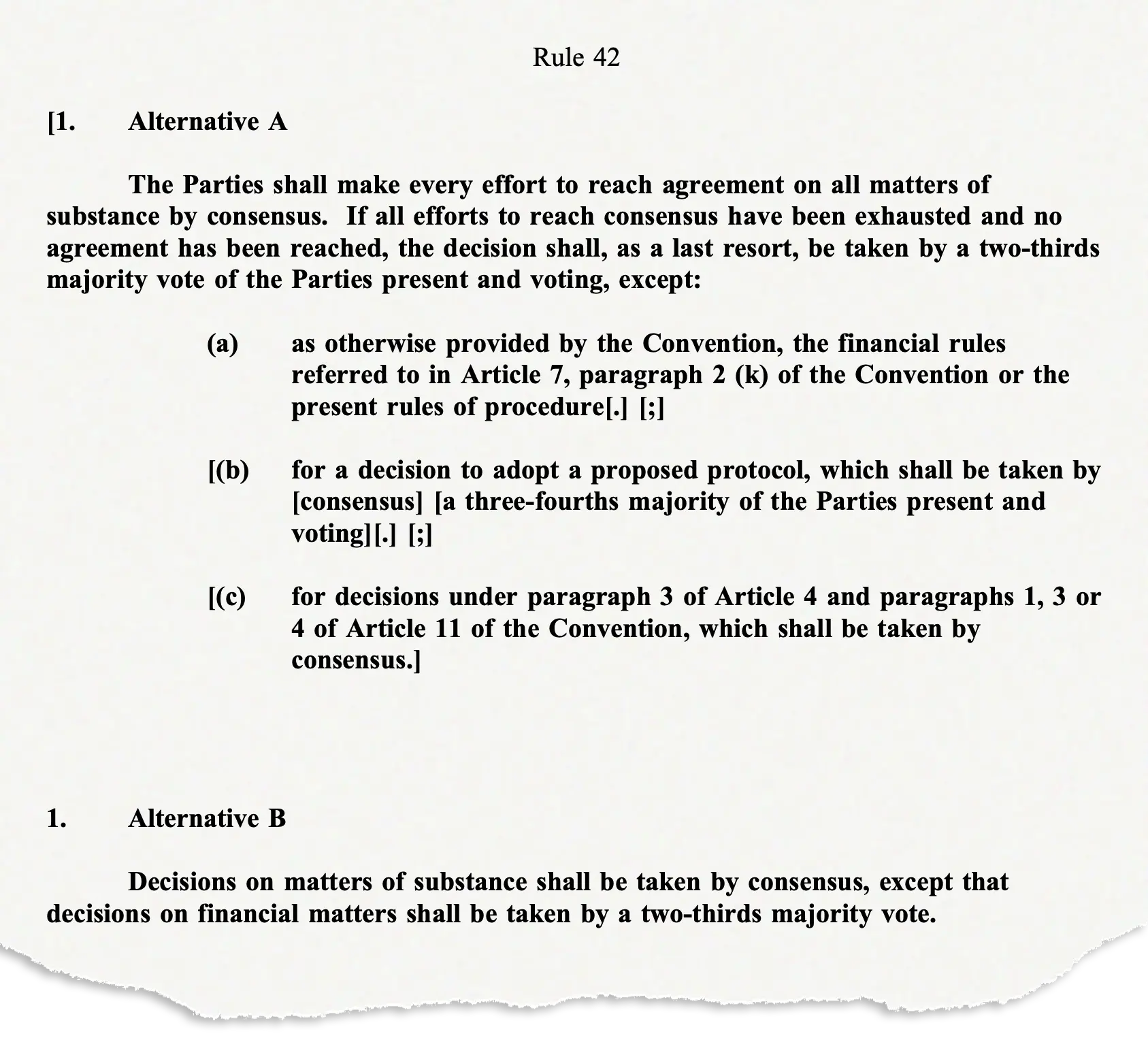
As Earth Negotiations Bulletin reported at the time, voting rules were blocked by “Opec member states”, who were then operating as a COP negotiating group. It reported:
“Many are concerned about the effects that this impasse may have on the negotiation of a protocol to strengthen the commitments in Article 4.2(a) and (b) of the convention. Since the Opec member states are largely opposed to the protocol negotiations and are holding up agreement on the rules of procedure, they could effectively block the future work of the COP and its subsidiary bodies.”
(This Opec blocking move was, in fact, “likely…devised by US oil lobbyists, who at that time were highly influential in the negotiations and working very closely with Saudi Arabia, Kuwait and other Opec nations”, Depledge told Carbon Brief.)
Ever since then, each COP has agreed to apply the rules of procedure – except rule 42 on voting – meaning decisions must always be made by consensus. Dr Joanna Depledge explained that this was a “master stroke of the fossil fuel lobby” that makes negotiations “much tougher”:
“The absence of a voting rule is what makes all of this so much tougher…Preventing adoption of a voting rule and entrenching consensus was a master stroke of the fossil fuel lobby in the early days, and by that I mean mostly Saudi Arabia and Kuwait, heavily backed by US-based lobbyists.”
She added:
“To be fair, it wasn’t just the Opec countries: there were wider disputes over decision-making on climate finance, with donor countries insisting financial decisions should be taken by consensus, and developing countries wanting these to go for a vote. It’s not difficult to see why – developing countries vastly outnumber richer nations. But, ultimately, these disputes were provoked and fomented by the oil lobby.”
Loss and damage
In an unconventional move, after officially launching COP28 on 30 November, Sultan Al Jaber immediately turned to one of the big-ticket agenda items – the loss-and-damage fund.
“Loss and damage” is a term used to describe the unstoppable harm caused by climate disasters. For more than 30 years, small-island states, in particular, have been fighting for funds to help them deal with everything from hurricane damage to sea-level rise.
Yet their efforts have been consistently hampered by wealthy nations, who feared being forced to pay compensation due to their outsized role in historic emissions.
Nevertheless, a concerted push by developing countries culminated in a decision at COP27 last year to finally set up a loss-and-damage fund.
As part of this decision, a “transitional committee” of 24 climate diplomats was tasked with hashing out the details of the fund. This included where it would be located, how it would be funded and which countries would pay into it.
The night before COP28 was due to start, the UAE presidency released a proposed text based on the one agreed at the transitional committee’s final session, which had finished three weeks earlier. (The US objected to the final outcome at the time, but it subsequently clarified that it supported the consensus reached there.)
The next day, around two hours into the opening plenary, Al Jaber asked the hall full of officials whether there were any objections to this text. With no one raising any, he gavelled the decision through, prompting a standing ovation.
The loss-and-damage fund being launched marked the first time a substantial outcome had been achieved during a COP opening session. It was the result of careful groundwork laid by the presidency, amid concerns that this historically controversial issue would otherwise be used to derail negotiations.
Laura Schäfer, a senior advisor in climate risk management at Germanwatch, told Carbon Brief:
“What we saw here was a kind of diplomatic coup of the UAE in pushing this to the very first day because they were so wary that this could crash COP.”
Countries agreed that the fund would be housed in the World Bank for at least four years, but it would also be an independent entity under the UNFCCC’s financial mechanism. They also agreed that it would have its own 26-person board, with the majority of members coming from developing countries.
The board will also be tasked with giving the fund a name. This came as the US – which for decades resisted the entire concept of “loss and damage” – pushed back against references to a “loss and damage fund”. Instead, US climate envoy John Kerry repeatedly referred to the “climate impact response” fund. The US State Department declined to comment on the reasoning behind this to Carbon Brief.
Despite being generally perceived as an early win, the fund remained highly contentious.
Unlike other forms of climate finance, there is no firm obligation for developed countries to pay into the fund. It will, therefore, depend on the generosity of wealthy nations and any other sources of money that can be leveraged.
After launching the fund, Al Jaber promptly announced that the UAE would be the first to pay into it, with a $100m contribution. Germany followed this with another $100m.
Here, too, there were signs of careful orchestration, as this brought the fund up to the minimum $200m level required to establish it as a financial intermediary fund of the World Bank.
Several other parties followed their lead with their own funding announcements, including the UK, the EU and Japan.
The UAE, classified as a “developing” country under the UN system, has no obligation to provide traditional forms of climate finance. Its contribution, therefore, fuelled wider discourse around whether relatively wealthy, developing countries should be providing climate finance. US climate envoy Kerry told a press briefing:
“There’s no limit on who can contribute to this…If you’re an emerging economy and you’ve got the ability to put a few hundred million or $10m or something in it, you want to help your fellow human beings, that’s open to that, too.”
(The US pledged just $17.5m to the fund – less than Ireland or Spain – which is still contingent on approval from a log-jammed Congress.)
More developed countries also pledged money for the fund in the following days, bringing the total to $770.6m by the end of COP28.
Campaigners were quick to point out that this funding – $115.3m of which will go towards setting up the fund rather than directly helping people – would cover less than 0.2% of the developing countries’ annual needs.
Moreover, some nations, such as the UK and Canada, simply re-pledged money for loss and damage that they had already announced.
Barbados climate envoy, Avinash Persaud, told Carbon Brief that while this was understandable in the short term, ultimately, “we need now to get new, additional sources”.
Besides filling the fund, another major source of controversy ahead of COP28 had been locating it in the World Bank.
The US-based bank was perceived among developing country representatives and civil society groups as being too rigid in the ways it could accept and disperse funds, as well as charging high administrative costs.
Speaking at a side event, World Bank president Ajay Banga appeared to emphasise the bank’s hands-off role, telling the audience:
“The reality is the bank is currently not planning to play the role of allocating the money…That could change…but, currently, that is not the case.”
Experts noted the potential for “conflict” between the rules of the UNFCCC and the World Bank, which will have to be resolved fast to get the funds flowing.
“The World Bank will have to think critically if it can play the role it is being asked to in an effective manner,” Dr Rishikesh Ram Bhandary, a climate-finance expert at Boston University Global Development Policy Center, told Carbon Brief.
Developing countries have secured various “safeguards” that, if the bank failed to meet them, would trigger a search for a new home for the fund. Banga said he anticipated the fund would start distributing money next year.
Despite these issues, Brandon Wu, director of policy and campaigns at ActionAid USA, told Carbon Brief that, ultimately, reopening negotiations was perceived as “too risky” by developing countries. “It would have been more likely to get worse rather than to get better,” he said.
The other major decision on loss and damage to emerge from COP28 concerned the location of the Santiago Network. Parties agreed to set up this institution in 2019 as a way to link countries with the technical know-how to deal with loss and damage.
At the UN climate negotiations in Bonn earlier this year, negotiators tried to reach an agreement on the location of the network so that it could be properly launched.
In the end, developing countries in the G77 and China group were split over whether the network should be in the Caribbean Development Bank (CDB) or a consortium of the UN Office for Disaster Risk Reduction (UNDRR) and the UN Office for Project Services (UNOPS).
Just four days into the summit, the G77 and China reached a consensus on locating the network at UNDRR/UNOPS, leaving the path clear for these negotiations to be resolved. The final text also mentions “exploring areas for collaboration” with the CBD.
With the loss-and-damage fund wrapped up early, many campaigners turned their attention to how the topic was treated in the final global stocktake.
They wanted to ensure it was given equal weight with other big topics, such as mitigation and adaptation, in the document. This, they argued, would encourage nations to act on loss-and-damage in their future climate plans and provide adequate funding.
In the end, loss-and-damage received mixed results in the final text. Colin McQuistan, head of climate and resilience at Practical Action, said the inclusion of a standalone section on the subject was a “big win”, but noted that it was not framed as an “independent third pillar of climate action alongside mitigation and adaptation”.
Adaptation
Another important decision to come out of COP28 was a “framework” that is meant to guide nations in their efforts to protect their people and ecosystems from climate change.
This marked a big step forward for the “global goal on adaptation” (GGA), which was originally intended to raise the visibility of adaptation so it was on a par with mitigation in the UN climate process.
This has long been a priority for the most climate-vulnerable countries, particularly the African nations that first proposed the goal.
Yet, despite being “established” with the Paris Agreement in 2015, the GGA received little attention at UN negotiations until six years later at COP26. There, the African Group led a successful push for a two-year “work programme” to jump-start the goal.
In Dubai, the GGA was expected to finally have its moment. With the work programme wrapping up, parties were tasked with agreeing on a “framework” that countries could use to guide their adaptation progress.
Many of the decisions on the table centred around technical issues, which, nevertheless, could have big implications.
Among them were what “themes” should be covered by the goal. Parties agreed on water, food, health, ecosystems, infrastructure, poverty eradication and cultural heritage.
Within these themes, negotiators discussed sub-goals that countries could work towards, such as achieving universal access to clean water or protecting 30% of ecosystems.
There is a general understanding that, unlike cutting emissions, climate adaptation is a highly varied and context-specific issue that cannot be easily quantified.
The GGA has, therefore, often been framed as an aspirational “guiding star” that does not attempt to be too prescriptive, but could still help guide future planning and spending on climate adaptation.
In the highly politicised environment of UN climate negotiations, developing countries wanted to make money a central part of the discussion. They reasoned that any ambitions set out in the framework would require major investment, which many of them could not afford.
Adaptation efforts in developing countries are severely underfunded. Unlike efforts to cut emissions, adaptation projects – which tend not to directly bring in revenue – struggle to attract private investment. This means that public, grant-based funding from wealthy nations is seen as particularly important for supporting these kinds of projects.
As it stands, the UN Environment Programme (UNEP) estimates that the adaptation finance needs of developing countries are up to 18 times higher than current flows of public finance from developed countries.
Developed countries pledged at COP26 in 2021 to double adaptation finance from a 2019 level by 2025 – amounting to roughly $40bn. But, again, progress on this goal has recently stalled.
Negotiations around the GGA got off to a bad start. Draft negotiating text did not emerge until five days into the event, due to objections by the large G77 and China group of developing countries.
G77 countries wanted adaptation finance to feature prominently in the GGA framework, including a specific target for how much money should be provided. Developed countries indicated they wanted to see progress on the GGA, but did not want to focus on money.
When asked whether the EU supported an adaptation finance goal in the GGA, EU lead negotiator Jacob Werksman told Carbon Brief that parties already had such a goal – doubling adaptation finance. He continued:
“There is a conversation that will happen next year in the context of the NCQG [new collective quantified goal], which will describe how it is that we will be continuing to deliver on public finance and other sources of finance over the medium and longer term from 2025 and onwards. And I think that’s the right moment to reflect on how we can continue to accelerate more and more resources coming from all public sources, going into adaptation.”
The US and the Environmental Integrity Group (EIG) similarly argued that GGA talks should not “prejudge” outcomes from the post-2025 climate-finance negotiations next year.
Actual financial targets were never explicitly part of the GGA’s mandate. However, developing countries and civil society were keen to see strong language on finance that actually compelled developed countries to pay out money and held them accountable.
Another issue was the UNFCCC principle of “common but differentiated responsibilities and respective capabilities” (CBDR–RC), which places a greater burden on developed countries to deal with the climate change they largely created.
Many developing countries wanted to acknowledge the principle in the GGA talks. Saber Hossain Chowdhury, Bangladesh’s climate envoy, told Carbon Brief:
“CBDR–RC is at the heart of the Paris Agreement. Equity is something that is very important and we are going to insist on it.”
Developed countries, on the other hand, completely opposed its inclusion.
Yet, while many developing country groups seemed willing to engage, observers told Carbon Brief that the LMDCs and Arab Group were keeping the focus on CBDR–RC in order to block progress.
There were reports of frustration from more climate-vulnerable groups, such as the LDCs and AOSIS, and speculation that adaptation could be used as a bargaining chip in wider negotiations. However, the LMDCs rejected the idea that the G77 was divided.
Emilie Beauchamp, a climate adaptation specialist at the International Institute for Sustainable Development (IISD), told Carbon Brief:
“If countries keep getting stuck on issues related to CBDR in the GGA, things are going to break and parties are going to walk away. That’s what is very dangerous – you see hijacking of the GGA with negative outcomes for all the other groups.”
The first two versions of text that emerged from early consultations were so unpopular among parties that they only started properly negotiating with two days to go. (Notably, the second version included an annual target of $400bn in climate finance – roughly the upper limit of the current “adaptation finance gap” estimated by UNEP.)
When national ministers were tasked with corralling parties into some kind of agreement, Chilean environment minister Maisa Rojas confirmed that “the two most contentious issues” in GGA talks were finance and CBDR–RC.
Finally, just two days before COP28 was officially due to end, a draft decision was produced by the presidency. It included three options concerning CBDR-RC, weaker language on finance and no mention of a financial target.
Many parties expressed their dissatisfaction, but said they could work with the text. Soon after the text emerged, Mokoena France, an adaptation negotiator with the LDCs from Lesotho, told journalists:
“One thing we have realised that the text doesn’t have explicitly is the means of implementation, for the GGA framework. We think that is very critical for the implementation of the GGA framework.”
As negotiations continued and another text was released to general disapproval from developing countries, the African Group released a statement saying that they “[could not] accept a GGA framework without means of implementation from developed countries”.
Ultimately, however, the final text was waved through with even weaker language around both finance and CBDR-RC. Previous wording that “request[ed]” developed countries provide developing countries with finance was deleted, as was text about “taking into account the priorities and needs” of “particularly vulnerable” countries such as small islands.
Rather than mentioning CBDR-RC explicitly, the text only refers more vaguely to “provisions and principles” of the UNFCCC and the Paris Agreement.
There was little in the text that compelled developed countries to provide more money to developing countries. Mohamed Adow, director of Power Shift Africa, told Carbon Brief that the US had successfully led the opposition to adaptation finance in the negotiations.
As for the rest of the text, there were various changes made in the final document that reflected on-going debates throughout COP28.
Developed parties, such as the EU, as well as the G77 had agreed that there should be more time to carry out risk assessments and implement national adaptation plans (NAPs). As a result, the various “governance” targets for monitoring adaptation progress were pushed back to 2030, rather than some being set for 2025.
(There was also an agenda item specifically on NAPs at COP28, but it ended up being kicked down the road into future talks, with nothing more than a procedural decision. Another adaptation agenda item, concerning the annual report on the Adaptation Committee, was also delayed until future meetings.)
As for the “thematic” targets in the GGA, none of the more specific goals included in earlier drafts made it into the final texts. Instead, there was vaguer language around “attaining resilience” or “reducing impacts”. (Earlier drafts had contained language on “universal health coverage” and ensuring 30% of ecosystems are “maintained, enhanced or restored”.)
Bethan Laughlin, a senior policy specialist at the Zoological Society of London, told Carbon Brief that there were understandable motivations behind less precise targets:
“I think it comes down to a desire for national choice over actions, but at the same time what’s the point of a framework that’s meant to be actionable and measurable…If you don’t have actionable frameworks to work towards.”
Ultimately, Laughlin said the lack of quantifiable targets in the final text was a “real disappointment”.
The final text also retained language concerning the need for “transformational” adaptation. Some developing countries had called for removal of these references, on the basis that the concept is poorly defined and would place additional barriers in their path to obtaining adaptation finance.
Parties did not agree to set up a specific agenda item to continue discussing the GGA, as some had hoped for.
However, they will now engage in a two-year work programme to establish which “indicators” can be used to work out how well adapted they are in the future.
There were some positive signals for countries seeking adaptation finance in the final global stocktake text. It “urges” developed countries to prepare a report on their progress towards doubling adaptation finance by 2025 and also “recognises” that this finance will ultimately have to be “significantly scaled up beyond the doubling”.
Finally, the text also “decides” to convene a ministerial dialogue “on the urgent need to scale up adaptation finance…to ensure the mobilisation by developed country parties of the adaptation support pledged”. (This is one of only eight uses of the relatively strong word “decides” in the text).
Mitigation work programme
The first decision under the Sharm el Sheikh mitigation ambition and implementation work programme (MWP) was adopted on COP28’s final day.
The programme is focused on accelerating and identifying the best clean-energy pathways through to 2030, building on two global dialogues held this year – one on power and one on transport systems.
At the climate negotiations in Bonn in June, an intense fight broke out over the agenda, which meant it was not accepted until the day before the two-week session was meant to close. This was due to a deadlock around whether the MWP should be added to the agenda, as, although mitigation is widely agreed to be vital, the economic toll of taking such actions could be a significant burden to many developing countries.
Ultimately, the MWP, along with a proposed item on financial support, was dropped from the agenda, with an informal note issued by the SB chairs capturing the work on it at Bonn.
Going into COP28, therefore, some observers were concerned that similar disputes over the phase out of fossil fuels and the finance needed for a just transition, would once again emerge.
The initial text produced on 2 December was an “informal tool” rather than a draft text, due to disagreement over duplication with the stocktake. This was also the case with the texts released on 3 December and 5 December, although both contained more elements of what can be considered a draft text.

Speaking at a CAN briefing on 6 December, Avantika Goswami programme manager Centre for Science and Environment, said the MWP discussion so far has “not been fruitful, it’s been extremely procedural”. Goswami added:
“What we are finding in this work programme right now is that no substance is being discussed. And conversations are stalled and delayed, potentially to see what outcome is produced from the global stocktake, which, in our opinion, would be a lot of good time available here wasted, if we leave COP28 with no substantial discussions on mitigation ambition.”
On 9 December, finally, a draft text with formal status was released, although it was peppered with brackets. This included key areas of divergence, such as whether to “encourage parties to consider…with a view to urgently scaling up” action and on whether “highlight the importance of accelerating the just energy transition”.
Fights around the mandate of the MWP – in particular, with discussions on the role of fossil fuels continuing in the GST negotiation – dominated disagreements, limiting progress on other matters over the following days.
This included the potential of regional dialogues, which the US, EIG, AOSIS, LDC and AGN expressed interest in during meetings known as “informals”.
Speaking to Carbon Brief on 10 December, Tom Evans, policy advisor at thinktank E3G, said:
“I think what’s disappointing is that there aren’t some of the technical refinements that could be done in the MWP. There’s a huge opposition to regional workshops, breaking these things down on a regional level. Other than that, we’ve heard some complaints about costs and admin.”
Following draft negotiation texts on 9 December, there was a gap of four days without any additional texts being released, as discussions stalled.
Challenges in the MWP continued around whether the decision text should include any high-level political messages – such as a stance on fossil fuels – or whether that falls outside the mandate of the programme, noted TWN.
As such, conversations remained procedural, with WWF noting in its newsletter that “parties have not stepped up on increasing ambition or discussing enough substance to agree on any energy-package language”.
Kay Harrison (New Zealand) and Carlos Fuller (Belize) were appointed as co-facilitators of the MWP on 9 December, in an effort to progress the negotiations beyond the “incremental progress” seen in the first 10 days of talks.
The final text released and accepted on the final day of COP28 is procedural more than substantive, due to challenges around the mandate of the programme and the continued mistrust amongst parties regarding who will bear the mitigation burden and how (as was seen in Bonn), suggested India’s Centre for Science and Environment in a Twitter thread.
CSE Climate Change wrote:
“Developing countries feel they already lost the equity fight by taking on equal mitigation share across the board and coming up with NDCs. They don’t want new pressures channelled through this work programme, which is fair.”
All references to 1.5C were removed from the final draft, including the point from the previous draft noting “the assessment of the Intergovernmental Panel on Climate Change that the impacts of climate change will be much lower at a temperature increase of 1.5C compared with 2C, and the resolve to pursue efforts to limit the temperature increase to 1.5C”.
The removal of this, along with the emphasis on the “urgent need for parties to increase efforts to collectively reduce emissions through accelerated action and implementation of domestic mitigation measures” (a reference to Article 4, paragraph 5 which states that support shall be provided to developing country parties to support these collective efforts) and the recognition of that countries have “different starting points, capacities and national circumstances”, speaks to the lack of substantive conclusions in the MWP.
Beyond COP28, the MWP will act as a process under which mitigation outcomes from the GST could be taken forward. There is a level of uncertainty around this, however, as it is unclear whether the “road map to mission 1.5C” (see Global stocktake) will tie in with the MWP.
Finance
Besides the early adoption of the loss-and-damage fund, none of the biggest items on the COP28 agenda focused exclusively on climate finance.
However, the topic still permeated the event and was a key talking point in most of the negotiations.
As the talks came to a head on 12 December, the official closing day of the summit, a panel of African leaders told a press conference that financial support would be “essential” if they were to transition away from fossil fuels.
They were not alone.
In order to achieve any of the lofty aspirations of COP28 – from fossil-fuel phaseout to tripling renewables (see sections on Global stocktake and Renewables and nuclear) – developing countries emphasised again and again that they would need large amounts of money.
This position is well-founded. In a new report launched at the start of COP28 from the High-Level Expert Group on Climate Finance, chaired by leading economists Vera Songwe and Nicholas Stern, the authors conclude:
“The world is badly off track on the Paris goals, as the first global stocktake shows, the primary reason for which is insufficient investment in key areas, particularly in EMDCs [emerging markets and developing countries].”
The report emphasises that these nations will require around $2.4tn of investment a year by 2030 to meet their climate goals. As for where this money will come from, many of the ideas discussed in the report were also discussed throughout COP28.
Currently, a small group of “developed” countries that includes the US, western Europe, Japan and other “global north” nations, is obliged under the UN system to provide “climate finance” to help developing countries take climate action. Most of this finance comes in the form of development aid.
These parties were tasked with providing at least $100bn of climate finance annually to developing countries by 2020 and until 2025. They have so far failed to do this and, in doing so, have contributed to a general lack of trust within this critical part of the UN climate system.
However, a recent report from the Organisation for Economic Co-operation and Development (OECD) concluded that, despite the lack of publicly available data, the goal was “likely to have already been met as of 2022”.
This was repeatedly cited as positive news by developed countries at COP28. They wanted it reflected in the outcomes within the “long-term climate finance” agenda item, which concerns the delivery of the $100bn goal. However, developed countries argued that the OECD’s conclusions were essentially conjecture and should not be considered.
There were also suggestions from some developed countries that, rather than the OECD, Oxfam’s estimates of progress towards the £100bn should be used to assess progress. (The NGO does not fully count contributions delivered as loans, slashing climate finance estimates by around three-quarters.)
The final text did not explicitly reference either the OECD or Oxfam. However, it “notes the different estimates” of progress towards the $100bn considered by the UN’s Standing Committee on Finance, in a report which incorporates both organisations’ work.
Part of the reason developing countries want to keep the focus on past failures is that, even if the £100bn goal was met in 2022, developed countries are still obliged to make up the shortfall for 2020 and 2021 – which stands at $27bn. In the global stocktake outcome, developed countries agreed to “fully deliver, with urgency” the $100bn pledge.
Meanwhile, negotiations continued over the development of a post-2025 climate finance goal to replace the $100bn pledge, termed the new collective quantified goal (NCQG).
This is expected to be the biggest agenda item at COP29 next year in Baku, Azerbaijan. In the meantime, countries have been carrying out various “dialogues” involving experts and ministers, laying the groundwork for the decision.
Developing countries, which expect to be the main beneficiaries of this new target, want to move faster on deciding its details. Developed countries, on the other hand, have been happy to delay discussions on anything substantial until they are forced to do so.
Alex Scott, a climate diplomacy lead with the thinktank E3G, told Carbon Brief that there had been some discussion at COP28 of pertinent issues, including the timescales of the NCQG. Some parties proposed setting sub-goals for underfunded areas, such as adaptation, but this was “definitely too politically contentious”, Scott said.
With little agreement among parties, the focus throughout much of the talks ended up focusing on how to continue with workshops. Ultimately, negotiators agreed to go beyond such technical discussions and make space next year to start work on a draft decision text ahead of COP29. Joe Thwaites, a climate finance expert at NRDC, told Carbon Brief:
“With a major new finance goal due to be agreed in 2024, this COP’s decisions were never likely to make new finance commitments. COP29 will be the finance COP.”
The NCQG, along with the loss-and-damage fund, is an area where developed countries are keen to discuss expanding the climate-finance donor base. That is, broadening it out to include relatively wealthy emerging economies, such as China and the Gulf states.
In her role representing the Council of the EU presidency, Spanish environment minister Teresa Ribera told a press conference:
“The EU will keep on providing financial assistance to the most vulnerable countries, but we need to enlarge the base of contributors and change the logics being applied up to now. Other relevant principles may be important in this discussion – the fair approach relates to historic responsibilities, but it also relates to the financial capacities of today, or the polluter pays principle.”
This is a highly controversial issue at UN talks, particularly in the context of past failures by developed countries to deliver climate finance.
Some large, emerging economies already distribute significant sums of climate-related finance to other global-south nations, but it is not considered under the politicised term of “climate finance” in the UN context.
Jonathan Beynon, a climate finance expert at the Center for Global Development, told Carbon Brief that disputes over who should bear responsibility for providing climate finance could be seen across many negotiating tracks at COP28:
“There are growing signs that some developing countries recognise that not all developing countries are the same and that the larger emitters should start contributing. So while developed countries must deliver on existing promises and continue to take primary responsibility, a more nuanced approach seems the best way forward.”
Many global-north countries, particularly the US, have failed to provide their “fair share” of climate finance, based on historical emissions. However, analysis by Beynon and others suggests that, based on such metrics, there are various wealthy nations outside the global north that could be candidates to be future climate-finance donors, including COP28 hosts the UAE.
Outside of the negotiations, there was a growing sense that climate funds mobilised through the UN system would not be sufficient to meet the challenges ahead. Instead, many argued for changes to global finance “architecture”, such as those outlined by the High-Level Expert Group on Climate Finance in its new report.
Barbados prime minister Mia Mottley, speaking at an event attended by Carbon Brief, welcomed the new loss-and-damage fund, but questioned whether there was a need to go beyond traditional climate finance and “laborious treaty negotiation” to raise sufficient funds:
“It cannot be governments alone, because more money is circulated among non-state actors than perhaps around two-thirds of the countries of the world, whose balance sheets are miniscule in comparison to the major non-state actors.”
This builds on a growing movement, led by Barbados and a handful of other nations from the global north and south, to reform the international finance system and help to raise the trillions of dollars that are needed for climate action.
As University College London economist Mariana Mazucatto said at the same event: “Actually, there’s plenty of finance out there, it’s just often not being directed”.
Among the ideas being proposed to raise funds for climate action are levies attached to high-emitting sectors and reforms at multilateral development banks (MDBs) to free up more finance.
These ideas came to the forefront in the UAE-led Leaders’ Declaration on a Global Climate Finance Framework, which was endorsed by 13 national governments on the third day of COP28.
This was viewed as an effort to bring together various efforts from recent months to drive widespread financial reform, including Barbados’ Bridgetown Initiative, the Paris pact from the financial summit held earlier this year and the Nairobi Declaration that emerged from the first African Climate Summit.
One of the declaration’s priorities was “building better, bigger and more effective MDBs”. This has been a growing area of concern in the international arena and the final global stocktake agreement at COP28 reflected this by “call[ing] on MDBs and other financial institutions to further scale up investments in climate action”.
Another venture, set up by France and Kenya, was termed the Taskforce on International Taxation to Enhance Development and Climate Action. This was intended to push for climate levies on aviation, fossil fuels and financial transactions, specifically.
These issues found their way into negotiations as well. The global stocktake “emphasises” the role of “governments, central banks, commercial banks, institutional investors and other financial” organisations in “ensuring or enhancing” access to climate finance.
It also says these institutions should “accelerate…new and innovative sources of finance”. The document specifically mentioned taxation as an option – the first time it has been referenced in a COP decision text.
Meanwhile, negotiators also discussed draft reports undertaken by the Standing Committee of Finance on ways to achieve Article 2.1c of the Paris Agreement, doubling adaptation finance and defining climate finance. These are all contentious issues in UN negotiations.
Article 2.1c refers to the section of the treaty that describes making all financial flows consistent with the Paris Agreement.
Scott told Carbon Brief that, in theory, discussions of this topic could cover the kind of systemic changes being discussed outside the negotiating rooms. However, developing countries have resisted developed-country efforts to raise this issue, viewing it as an attempt to divert the conversation away from the provision of traditional climate finance.
Sharm el-Sheikh joint work on agriculture and food security
The Sharm el-Sheikh joint work on implementation of climate action on agriculture and food security (SSJW), agreed at COP27 last year, is the only formal UNFCCC workstream to address agriculture and food systems.
SSJW is the successor to the Koronivia joint work for agriculture, which was established at COP23 in Bonn, in 2017.
The goal of the SSJW negotiations at COP28 was to establish a roadmap for the joint work. There were three main elements to this: to agree on a set of topics for the three mandated workshops to be held under the joint work; to establish the online portal for submissions under the workshops; and to determine how the work itself should be carried out and synthesised.
Under the SSJW, as with Koronivia before it, a series of workshops brings together a wide range of voices on a particular topic, with each workshop resulting in a synthesis report.
Such reports are “a form of recommendation”, said Marie Cosquer, co-coordinator of the Climate Action Network’s agriculture working group and advocacy analyst at Action against Hunger. She added:
“Even if it’s sometimes very top line, it’s still a political signal for countries to orient and define their food-systems policies.”
On the first day of the negotiations, some developed countries suggested that it would be more constructive to start with a clean sheet, having failed to come to a consensus at the last session of the subsidiary bodies in Bonn. But developing countries supported using the informal note prepared in Bonn in June as the basis of negotiations.
As a result, the negotiations began “very blocked”, Cosquer said. She told Carbon Brief:
“We were really disappointed to see that nothing has moved since Bonn.”
Parties reportedly “lamented” the lack of progress in the negotiating rooms over the course of the first several days, with some noting that the Emirates Declaration on Sustainable Agriculture gave added weight and urgency to the work being done there. Both parties and observers said they lamented that one year of the SSJW mandate had already passed, with nothing to show for it.
There were two elements “gluing up” the negotiations, said Teresa Anderson, global climate justice lead at ActionAid. She told Carbon Brief:
“One is the process and the bureaucracy entailed in making outcomes. And one is the content – and, of course, we need the right bureaucracy, we need the right systems in place, in order to have the right conversations about the content.”
The G77 plus China negotiating bloc put forward a proposal for a “coordination group”, which would help facilitate implementation of the joint work. Developed countries expressed concerns over what that group would achieve and the costs it would incur to implement additional meetings.
Anderson noted that it was clear that changes needed to be made in the process in order to begin to effectively implement the joint work, but “developing countries hadn’t proven to developed countries that this [coordination group] is really the right structure to solve the problem”.
As the negotiations progressed, the coordination group remained the major sticking point, with the G77 plus China bloc insisting that if they could not come to an agreement on the group, there would be no agreement on anything else.
Ultimately, the SSJW negotiations ended with a procedural text. This “essentially means, ‘we talked, we’ll talk again’”, Anderson told Carbon Brief. She continued:
“There’s a long, bloated, confusing text now, with everybody’s pet pieces and pet hates all in there. That’s now being recorded as an informal note, which means that it can be picked up to be discussed again next year.”
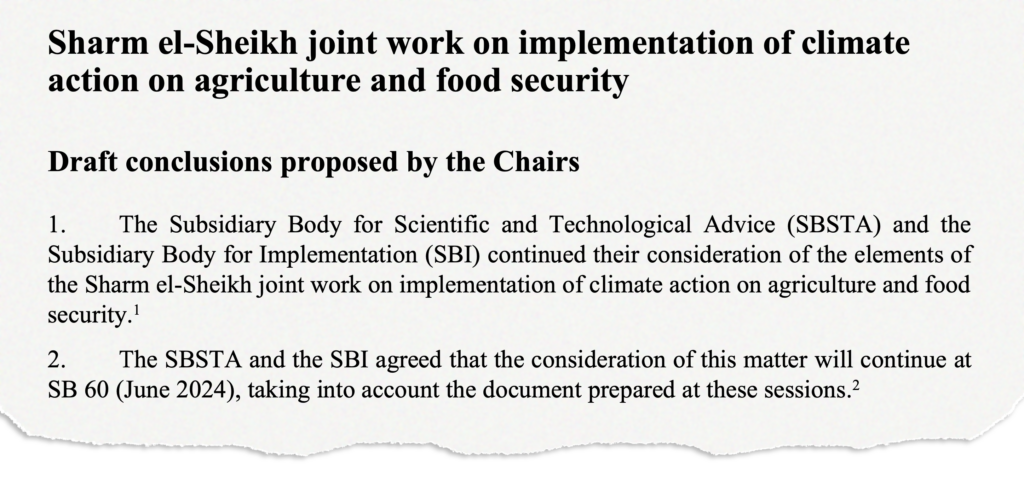
The draft decision on the Sharm el-Sheikh joint work on agriculture and food security. Source: UNFCCC
The informal note that will be forwarded to Bonn has no legal status, and may or may not be used as the basis of the next round of negotiations.
Annex I of the informal note contains a still-bracketed decision to establish a coordination group to “facilitate the Sharm el-Sheikh joint work…for the duration of the mandate established” at COP27.
Annex II lays out the seven proposed topics for the three workshops, with two options for each of the first two workshops and three for the final one:
- Scaling up means of implementation, including finance, technology development and transfer and capacity-building.
- Risk management, including early-warning systems for food security.
- Approaches to sustainable agriculture and food security.
- Holistic approaches to agriculture and food security.
- Fisheries and aquaculture.
- Understanding sustainable food systems through climate action.
- Measuring, monitoring, reporting and verifying climate action for agriculture and food security.
Clement Metivier, acting head of international advocacy at WWF-UK, told Carbon Brief:
“The key word is implementation. And the big question is: how can the UNFCCC actually help with implementation at the national and even the local level? When we talk about agriculture and food security, this is very much about local issues and very concrete solutions. And, obviously, this [COP] process is very different from implementation on the ground.”
Article 6
Article 6 of the Paris Agreement covers international carbon markets and other “cooperative approaches” that nations could use to help meet their climate targets.
Outside the international climate regime, the so-called “voluntary” carbon market (VCM) has been under intense scrutiny this year, after high-profile investigations highlighting its shortcomings.
Carbon markets are also contentious at the COP with some countries opposed to the idea in principle. At COP25 in Madrid in 2019, negotiations on Article 6 ended without agreement.
Those cracks were smoothed over at COP26 the following year. There, rules were finally agreed on bilateral country-to-country carbon trading under Article 6.2, on the centralised international carbon market under Article 6.4 and on “non-market approaches” (NMAs) under Article 6.8.
Ahead of this year’s talks, the International Emissions Trading Association (IETA) said that, with those rules already agreed, Article 6 was no longer high on the political agenda.
It said that this was an opportunity to “avoid extreme politicisation and focus on key decisions to operationalise international carbon markets”.
At COP28 in Dubai, however, countries once again failed to reach agreement on Article 6.2 and Article 6.4, both of which were subject to “rule 16”, meaning talks will resume next year.
Independent climate policy analyst Catalina Gonda, who was advising a number of NGOs on Article 6 at COP28, told Carbon Brief:
“Overall, it is good to see both 6.2 and 6.4 texts will continue to be discussed next year, as they were clearly not ready for adoption.”
Similarly, NGO Carbon Market Watch said in a statement: “No deal was better than agreeing to a bad one that would torpedo the Paris Agreement.”
However, the outcome was “disappointing”, said Juliana Kessler, research associate at thinktank Perspectives Climate Research. She told Carbon Brief:
“The Article 6.2 and Article 6.4 negotiations outcome at COP28 is disappointing and sends the wrong signals to carbon market actors. The further delay of the Article 6.4 mechanism – which is expected to become a benchmark [for quality] – is very problematic.”
Article 6.2
Against the hopes of IETA, the Article 6.2 discussions were indeed heavily politicised, with deep disagreements over whether – and how – to impose processes and controls on bilateral trading.
COP27 gave countries reporting on their use of Article 6.2 a free hand to mark information as confidential, with oversight limited to a review of reported information by a UN technical team.
At COP28, some countries were pushing for a clear process for “identifying, notifying and correcting Inconsistencies”. Earlier draft texts at the summit included a lengthy section on this topic – but it was reduced to a single paragraph in the penultimate draft.
They also wanted a more clearly defined sequence for the authorisation of carbon-cutting schemes and the subsequent issuing of related carbon credits, as well as tightly limited rules on when the authorisation of carbon credits could be “revoked”.
Gonda told Carbon Brief that the US was the main proponent of looser rules, opposed by the EU, Latin American countries and others. She explained:
“We have a paradoxical situation in which stringent rules are being negotiated for a highly regulated UN-governed carbon market (6.4), while countries also have the option to exchange carbon credits under ‘cooperative approaches’ of Article 6.2, through highly unregulated bilateral or multilateral agreements and without independent oversight.
“The main dispute in these Article 6.2 negotiations is between those favouring voluntary standards and vague, expedited processes – mainly the US – and those [including the EU, AILAC and others] advocating for greater stringency, supervision and cooperative approaches to minimise the already large asymmetry between 6.2 and 6.4.”
Andrea Bonzanni, IETA director of international policy, told Carbon Brief:
“The gap in expectations remains large and it will be difficult to bridge. However, Article 6.2 does not need further guidance to be implemented.”
Kessler said that the lack of agreement on Article 6.2 left this implementation wide open to interpretation by the countries pressing ahead with such carbon-trading. She explained:
“Adopting the Article 6.2 decision would have brought important clarifications on basic definitions, the authorisation process, reporting processes and the dealing with inconsistencies therein. The resulting lack of guidance causes uncertainty and undermines transparency – leaving key design choices to states engaging in bilateral Article 6.2 cooperation without a guiding star.”
Article 6.4
In order to start operating, the international carbon market under Article 6.4 needs rules on how to define the number of carbon credits each project generates.
Draft recommendations on Article 6.4 “methodologies” were up for approval at COP28. They define key ideas such as the “baseline” against which emissions reductions or emissions removals can be “credited”, generating “Article 6.4 emissions reductions” credits that can be bought and sold.
The draft rules say the baseline has to be consistent with the host country’s climate pledge, rather than being set against “business-as-usual”. They also set out how the issuing of Article 6.4 carbon credits should avoid “locking in” emissions inconsistent with climate goals.
These recommendations were developed by a “supervisory body” that oversees the Article 6.4 international carbon market.
While these recommendations had broad support at COP28, agreement foundered on rules for carbon credits generated via “removals”, meaning engineered or natural processes that suck carbon dioxide (CO2) out of the atmosphere.
(An earlier draft of this guidance had been sent back to the drawing board at COP27.)
Many approaches to carbon removal are non-permanent, Gonda told Carbon Brief, carrying risks of reversal. Using non-permanent credits to offset ongoing fossil fuel emissions “should be treated with extreme caution and limited in some way”, she explained.
While the draft guidance on removals set out to do this in a number of ways, including “buffer pools” of credits that could be held back as insurance, it left a variety of matters unfinished.
This included a tool to assess the risk of reversals and a decision on how long projects would need to be monitored after they stop issuing credits. This monitoring is needed to ensure that the carbon removed from the atmosphere is still being stored – in other words, it has not been “reversed”.
A number of other important matters had been left unfinished ahead of COP28, including the “sustainable development tool” that carbon-credit projects will have to use under the Article 6.4 market, as well as a grievance procedure for dealing with disputes.
The supervisory body is also yet to draw up tools to help carbon-credit projects work out the appropriate baseline for crediting and to demonstrate that the emissions being reduced or removed are truly “additional” to what would have happened anyway.
It is also yet to develop a tool on avoiding the risk of carbon “leakage”. Most of these tools are mandatory, meaning projects would not be able to start issuing Article 6.4 credits until the tools are in place.
The EU pushed for COP28 to adopt the recommendations on methodologies, while asking for more work to be done in the document on removals. (The EU’s Article 6 negotiator Martin Hession had co-authored the recommendations on methodologies.)
The group of Like-Minded Developing Countries (LMDCs), on the other hand, insisted that the two documents be adopted as a package. (Maria AlJishi, Article 6 negotiator for LMDC member Saudi Arabia, had co-authored the recommendations on removals.)
In addition, the draft text at COP28 “provided insufficient guarantees on safeguards and human rights”, Gonda said, as well as failing to “clearly state the need to establish an independent grievance mechanism before moving projects forward”. She added:
“This is extremely risky, as seen with the clean development mechanism [CDM, the carbon market under the Kyoto Protocol], where multiple projects faced allegations of human rights violations and environmental impacts and where an independent grievance mechanism was never adopted, leaving communities completely unprotected.”
At a 3 December COP28 side event attended by Carbon Brief, supervisory body chair Olga Gassan-zade said they had “worked 10-12-14 hour days just to bring this package to this meeting. We rely on the support of parties to allow this package to proceed.”
In the end, however, COP28 was unable to sign off any decisions on Article 6.4. This means the international carbon market it is supposed to set up will be put on ice for another year.
Finally, COP28 was also discussing a proposal from the Philippines for Article 6.4 to allow “emissions avoidance” schemes to generate carbon credits.
Emissions avoidance has a narrow and specific meaning under the CDM, but is used in a wide variety of ways in other contexts.
In the Philippines proposal, it could include generating carbon credits by agreeing not to develop new fossil fuel infrastructure or reserves, tapping into a huge potential supply of hypothetical “avoided emissions” that could then be used to “offset” ongoing emissions.
Carbon Brief understands this is opposed by all other parties, with those publicly stating their opposition including India, the EU, the Coalition for Rainforest Nations and the UK.
Also up for debate at COP28 was whether to allow credits from “conservation enhancement”. Many also opposed this, or said that such projects could instead generate emissions reductions or removals that are already eligible under Article 6.4.
Article 6.8
The third part of Article 6 on cooperation is via “non-market approaches” (NMAs) under Article 6.8.
The idea has long been ill-defined, but has been pushed by those that object to market-based mechanisms on principle, particularly in light of issues with some carbon-market schemes.
Disagreement over the meaning of NMAs continued at COP28. Draft texts “invite[d] parties to consider non-market approaches, including domestic fiscal measures [such as carbon pricing”.
This proposal was backed by the EU, but opposed by several groups of developing countries including the LMDCs and AILAC, according to Down to Earth.
The final version of the text, published on the evening of 13 December, eschews specific examples of NMAs and simply “encourages parties to continue identifying opportunities” to use them.
(The text offers an insight into the position of those promoting NMAs, noting the “importance of ensuring the integrity of all ecosystems…recognised by some cultures as Mother Earth”.)
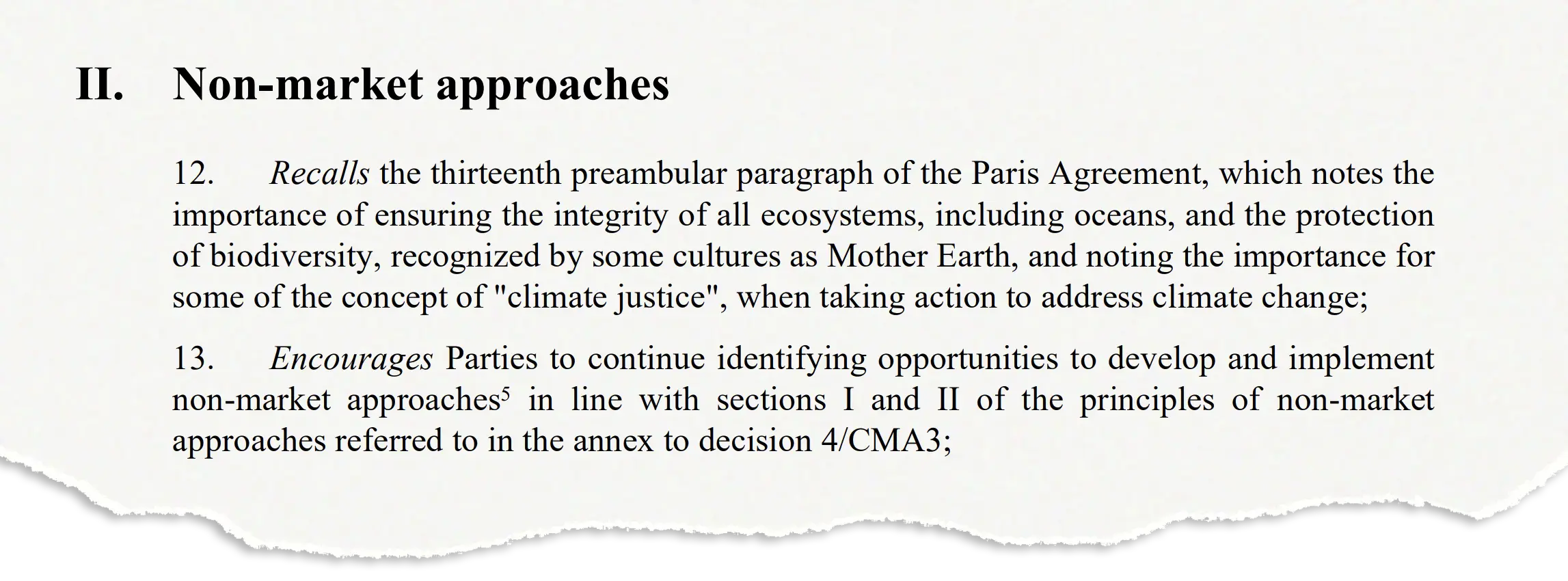
The text “takes note of the progress” in setting up a “web-based platform” for sharing NMAs, adding that this has not been completed according to the timelines agreed at COP27.
The text asks the UNFCCC secretariat to complete the platform before the next climate talks are held in Bonn, in June 2024, and “encourages” countries to use it to submit information on NMAs.
The text also asks countries to submit ideas for the ongoing work of the “Glasgow committee” on NMAs, which was set up at COP26 and is continuing to operate.
Voluntary carbon markets
The COP28 presidency said ahead of the talks that it “aim[ed] to restore credibility and confidence in VCM by convening the highest level governmental and institutional leaders to publicly recognise high-integrity VCMs as catalysts for climate action”.
The summit also saw a huge number of VCM-related announcements, from the Integrity Council for Voluntary Carbon Markets (ICVCM), from a group of EU countries on “high-integrity” markets and from the head of the World Bank Ajay Banga, among many others.
These efforts are, on the one hand, a response to the scrutiny over certain VCM schemes, and on the other hand a reflection of slow progress on Article 6.
One long-time observer of carbon-market discussions at the COP told Carbon Brief:
“There was a lot of love for the VCM out there in the pavilions and side events…the VCM seems to be taking on renewed strength from this COP.”
UNFCCC chief Simon Stiell offered a somewhat contrasting perspective on the matter, telling a 4 December event at COP28:
“Markets can help us increase ambition and reduce emissions…[But] voluntary carbon markets cannot substitute for government action…And voluntary markets cannot substitute for robust internal emission cuts by the private sector, this means it is ensured that emissions reductions are not substituted with offsets or carbon credits.”
Response measures
Established at COP17, “response measures” has traditionally been seen as a staging ground for disputes outside of climate target-setting.
The latest iteration of the response measures work programme (RMWP) spans dialogues on the just transitions of the workforce, socio-economic and economic assessments, diversifying economies and creating decent work conditions and quality jobs.
At COP28, battles over the impacts of response measures were expectedly protracted, but following heated discussions a clean text was produced ahead of closing.
With the EU’s carbon border justice adjustment (CBAM) tax entering into force in October and its deforestation law in July, as well as the ensuing north-south trade and environment spats at the WTO, discussing climate-related trade measures was a running undercurrent throughout many of the negotiations at COP28, as well as the RMWP.
Four days before the start of COP28, the BASIC group of countries submitted a proposal to the UNFCCC and the UAE presidency to add an item on “unilateral trade measures related to climate change” to the COP28 agenda.
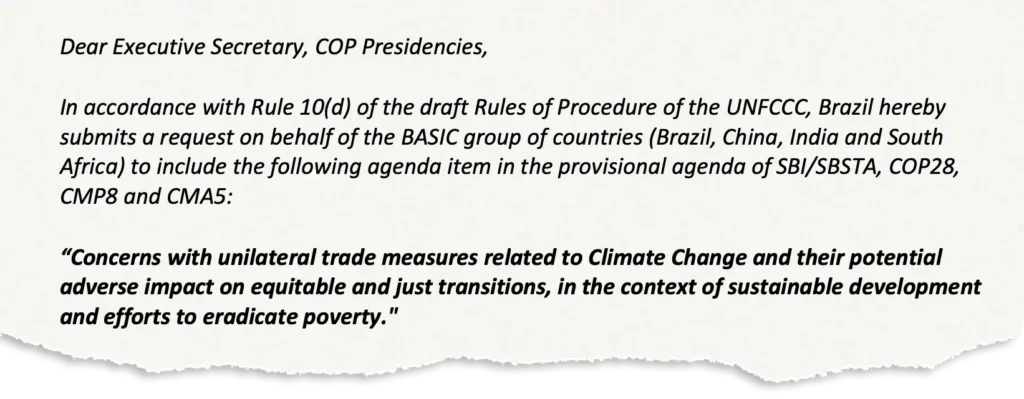
The presidency included this additional item in the provisional COP28 agenda, but eventually dropped it. Discussions on response measures, however, continued under SBSTA and the global stocktake.
This year, countries were supposed to conduct a mid-term review of the six-year work plan of the forum, its council of experts (KCI) and decide which additional activities should be added to it.
As of 1am on 6 December, there were 56 unresolved points of disagreement in the draft negotiating text.
Some of these were on the forum’s functions, modalities and composition, but a majority of brackets surrounded its work programme – and whether it would consider the positive co-benefits and negative trade-offs of climate policies.

Capacity-building was an area of contention, with G77 countries demanding an assessment of the negative impacts of unilateral measures and assistance in minimising these harms. There are no references to cross-border impacts or unilateral measures in the final response measures text.
With brackets showing no signs of lifting before the SBI/SBSTA closed, KCI co-chairs held lengthy discussions, reassuring countries their concerns would still be up for discussion in full during the second week.
On 6 December, subsidiary body chairs concluded they were unable to close the work on response measures and forwarded the text to the COP presidency.
On 8 December, COP president Al Jaber appointed Andrei Marcu of Honduras and Georg Børsting of Norway to conduct informal consultations on response measures.
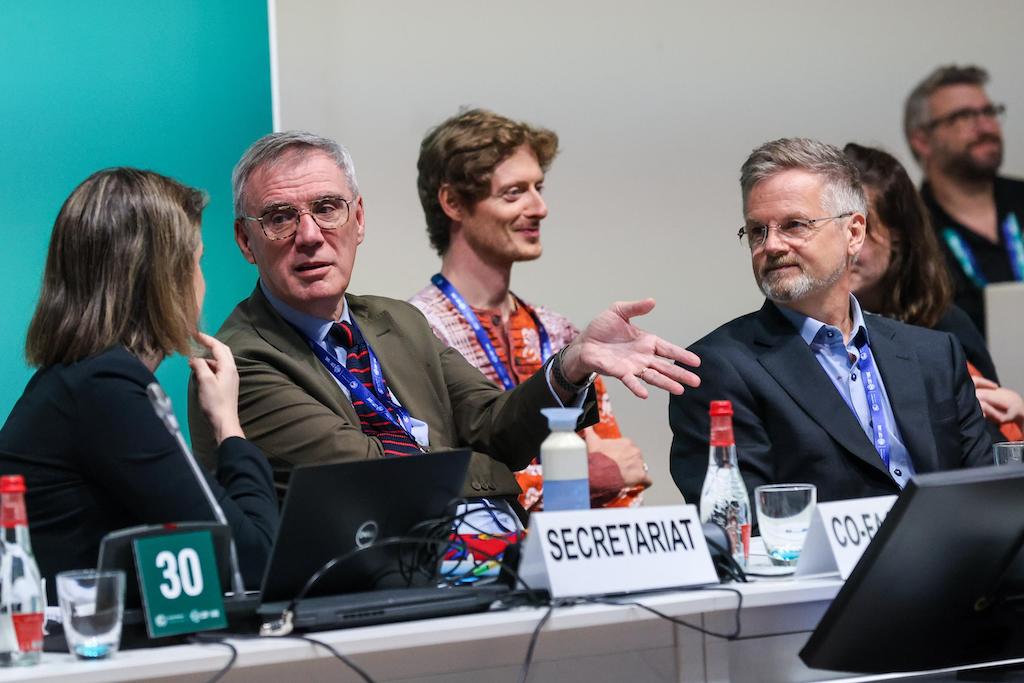
Under the Paris Agreement, the global stocktake “may also take into account” the impacts of response measures, as well as loss and damage.
According to a synthesis report of submissions to shape the stocktake’s political outcome, “almost all parties” had views on the impacts of response measures, but only one party “did not see the need” for a stand-alone section on it.
Avoiding unilateral measures featured as a high priority in the stocktake submissions of developing country blocs, such as G77 China, LMDCs, BASIC and ABU, many of whom pointed out that “protectionism” could increase the costs of implementing the Paris Agreement.
Separately, Russia proposed the stocktake consider the “socio-economic risks of [an] accelerated fossil phase-out”, specifically impacts on electricity prices and unemployment.
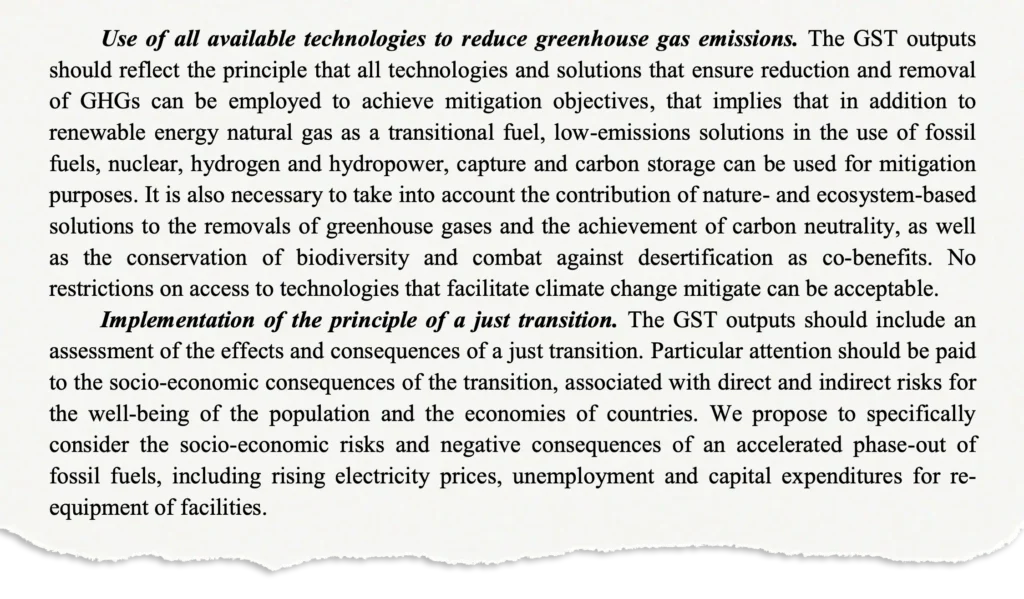
Russia’s submission to the global stocktake. Source (UNFCCC, 2023)
Countries, notably the US, wanted the positive impacts of response measures and their lack of implementation by “major emitters” captured in the global stocktake.
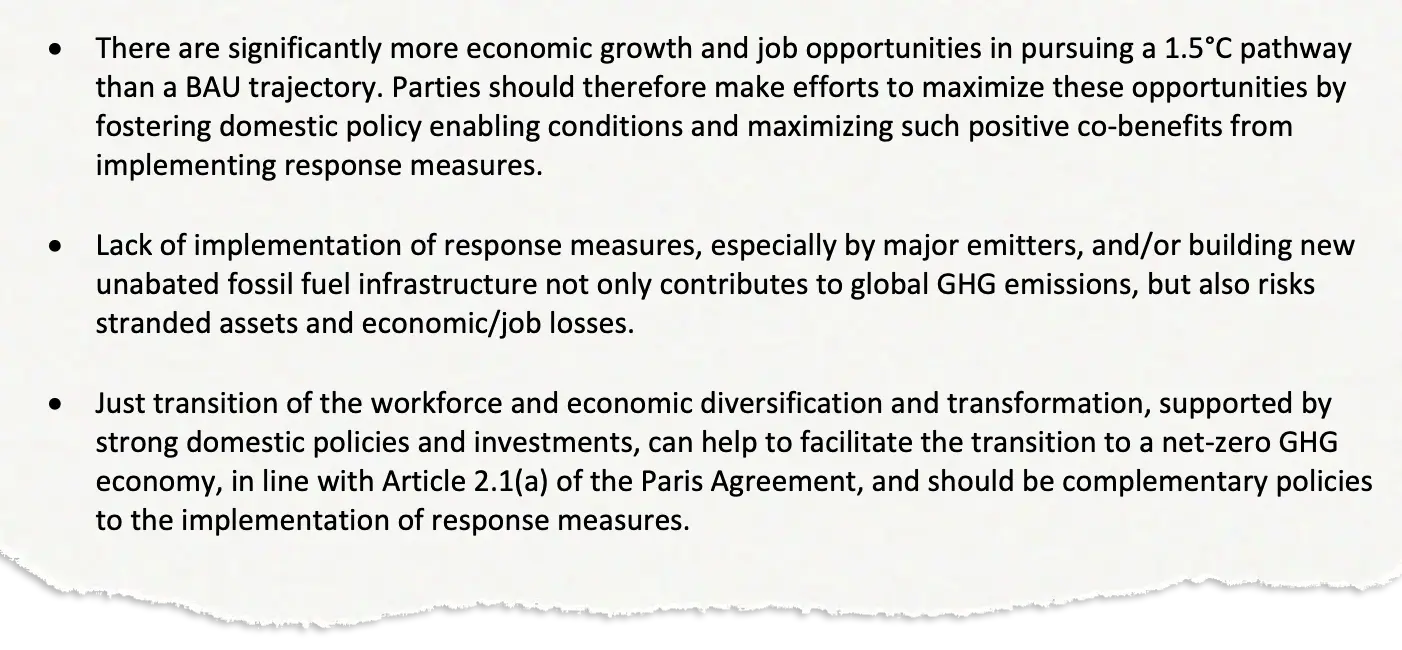
Many of these views were reflected in the first sets of building blocks of global stocktake text.
In the final version of the global stocktake, response measures were included as a stand-alone section. However, the only explicit reference to “unilateral” trade barriers is under international cooperation.
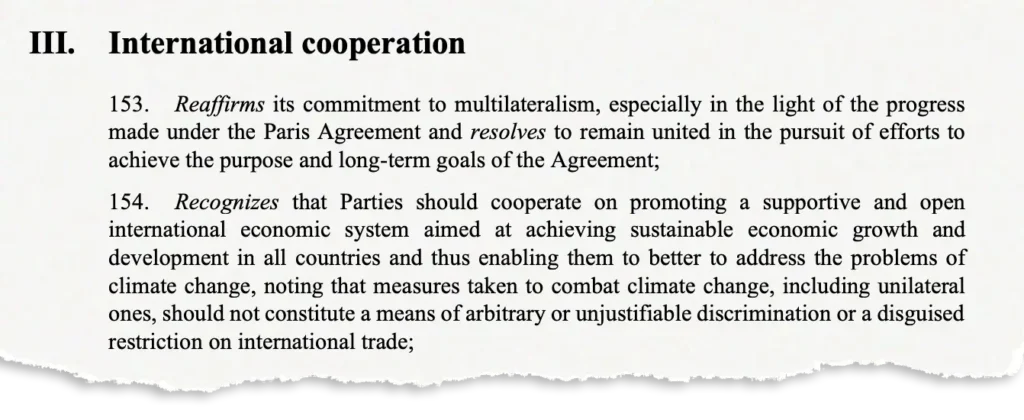
It also “notes” that the global low-emissions transition provides “opportunities” and poses “challenges to sustainable development, economic growth and eradication of poverty, “encourag[ing]” states to promote policies mindful of these considerations when diversifying their economies.
According to Pascal Lamy, former WTO director-general and coordinator of the Jacques Delors thinktank, the dissimilarity between climate and trade governance is a key driver of disagreement around the responses to policies, such as CBAM. In a media huddle on the morning on 9 December, Lamy told reporters:
“The trade governance system is based on rules, with no quantitative target. On the climate side, we have a target, which is net-zero emissions, but we have no rules. This is where we have friction, inevitably, because the Paris Agreement leaves total freedom to countries to decarbonise the way they want to do it in a nationally determined manner: it’s an N-DC not an MDC (multilaterally determined contribution).”
To Dr Vaibhaiv Chaturvedi, a fellow at Indian thinktank Council on Energy Environment and Water (CEEW), threats to the “nationally determined nature” of pledges on top of “frayed, withering” trust from lack of pre-2020 actions by developed countries were a source of “major discomfort” for developing countries. He told Carbon Brief:
“What does it do to the nationally determined nature of the Paris Agreement if some other country is trying to regulate your own emissions in some industries?”
To Sandra Guzmán, founder of the Climate Finance Group for Latin America and the Caribbean (GFLAC), finance discussions – including the non-delivery of $100bn and the post-2025 goal – were particularly important in this context. She told Carbon Brief:
“I’m from Mexico. I would like my country to continue improving its decarbonisation pathway, but it’s one thing to set a target and a plan to do so and another to receive imposition without the support to do so. We are just starting on this path and we are not there yet. CBAM might be good for the European Union, but not for the developing world.”
To Lamy, countries urgently needed a conversation where trade, climate and development are considered together. He added:
“Developed countries don’t like to discuss this in COPs, and there is huge resistance from developing countries to discuss this in the WTO because of an understandable fear against green protectionism.”
Just transition work programme
Launched within the Sharm el-Sheikh implementation plan, the just transition work programme (JTWP) held its first high-level ministerial round table at COP28, preparing the work programmes’s activities for the next five years.
Disagreements arose around the focus of the JTWP, with developed countries broadly viewing it as a labour transition, while developing countries argued it needs to be more multilateral.
This echoed the disagreements seen at Bonn in June, when the G77 and China said their views were being overlooked in the talks, which they described as being “mitigation-centric”.
As Anabella Rosemberg, senior advisor on the just transition at CAN, explained to Carbon Brief, the JTWP struggled to encompass a workers transition, the social elements around this, as well as an international cooperation and development aspect.
“It has been almost a philosophical conversation here about whether we’re talking about just transition pathways or pathways to just transition.”
These debates led to continued challenges in the JTWP negotiations, with 12 drafts of the text produced before consensus was reached.
On 8 December, new co-facilitators – Marianne Karlsen (Norway) and Simon Cardy (South Africa) – were appointed to preside over discussions after negotiations had failed to reach a consensus. Following group huddles, parties welcomed a text as the basis of negotiations, reported ENB, and set out their remaining concerns.
Many of these concerns, as with other negotiations at COP28, centred around the need for support to enable global-south countries to undertake a just transition. Within the JTWP, this went beyond financial support and included patent and licence restrictions, as well as punitive tax and trade measures.
Speaking to Carbon Brief, Dr Leon Sealey-Huggins senior campaigner at charity War on Want, explained how the JTWP was playing out as a microcosm of wider positions at COP28.
“The G77 – on the back of the loss-and-damage win – sees this as a potentially unifying fight. They said…if they don’t get a just transition work programme, that it could break the process for them. All the other stuff is either going to be enabled or constrained by the lack or presence of this aspect.”
In an effort to move the JTWP forwards, G77 and China brought a bridging proposal on the scope and preamble during the consultations under the presidency on 8 and 9 December. This was not reflected in the draft text released on 9 December, however, as the US said “it would take us backward if we take in [a] new option”, noted TWN.
Within this new draft, however, “pathways to just transition” was introduced by the developed countries, a linguistic difference that caused frustration for numerous parties.
The language had previously been accepted by 180 countries within the International Labour Organisations’ guidelines for a just transition, noted Bert de Wel climate policy officer at the International Trade Union Confederation speaking to Carbon Brief, adding:
“It’s watering down, stretching out the definition, diminishing the role of workers in this definition. While, at the same time, it’s obvious that we recognise that national circumstances are different between Poland and Senegal.”
Developing countries broadly wanted to retain “just transition pathways” – in line with the title of the work programme. For example, Brazil, Argentina and Uruguay said the original language was stronger in linking transition pathways to justice and equity, noted TWN.
Additionally, the change in language occurred during the closed-door consultations under the presidency, noted TWN. The exclusion of key parties both during this process and going forwards was flagged as a concern by many throughout COP28.
Another draft was released on 10 December, which was close to a clean text, and retained reference to “just transitions” plural. The final text was released in the early hours of 13 December and passed through the closing plenary.
It did not differ greatly to the 10 December text and includes human rights within the final preamble – something observers told Carbon Brief had been in question.
Reference to “country-driven, gender-responsive, inclusive and participatory, socially just approaches to pathways to just transition, taking into consideration human rights, labour rights, rights of Indigenous Peoples, vulnerable groups, children and youth, local communities and ecosystems” was removed from the text.
Changes to the timeframe of submissions under the JTWP were also changes, with parties and non-party stakeholders invited to submit their views on the work to be undertaken by 1 March each year from 2024.
Other matters
Gender action plan
The gender action plan, launched at COP25 in Madrid and building on COP20’s Lima work programme on gender, aims to mainstream gender-responsive thinking and policy across the UNFCCC negotiations.
Currently in the penultimate year of its five-year mandate, the gender action plan was “set to be an extremely procedural negotiation” at COP28, said Bridget Burns, the executive director of the Women’s Environment and Development Organization. She told Carbon Brief:
“We came to COP hoping to use it to make progress in talking to governments about what they hope and expect for next year and to share what we hope and expect for next year. But they ended up in a lot of meetings to debate language that had already been agreed.
“I think we’re seeing some governments using it as an easy strategic blocking negotiation.”
Finance remained a sticking point across the negotiations, with developing countries holding the line that they need resources in order to implement gender-responsive policies at the national level.
The text that was ultimately agreed upon was significantly “diminished”, with “quite crucial things missing”, Rebecca Heuvelmans, advocacy and campaigning officer with Women Engage for a Common Future (WECF), said.
References to a number of workshops and reports carried out under the plan, including a report from the International Labour Organization on gender and a just transition, were not included in the final decision.
Language on supporting Indigenous women was also removed from the final text.
Russia, in particular, “seemed to take a strategy of wanting to really block a lot of the aspects of the negotiations”, Burns said.
According to Sascha Gabizon, executive director of WECF, Russia argued against the specific inclusion of Indigenous women and attempted to change references to “gender” in the text to references to “sex”. She told Carbon Brief:
“They are very much politicising anything which has to do with gender equality in the negotiations. So that doesn’t really look good for the future.”
The gender action plan is set to be renewed and renegotiated at COP29 next year.
Action for climate empowerment
Action for Climate Empowerment (ACE) aims to encourage people to engage in climate action in different ways – through education, training and global cooperation, alongside public awareness, participation and access to information.
The “Glasgow ACE work programme” was agreed at COP26. At last year’s talks in Sharm el-Sheikh, countries agreed on a new four-year ACE “action plan”.
This plan “focuses on immediate action through short-term, clear and time-bound activities” – including finding ways to bring ACE into UN climate work and national climate plans.
SBI discussions on ACE at COP28 centred on an implementation progress report, released in October. This contained information from countries and stakeholders on ACE targets and how they have been integrated into NDCs.
According to the ENB, many delegates welcomed the report and some called for more details on the financial needs of countries.
On 2 December, a draft negotiating text was produced on matters relating to ACE. This “welcomed” the annual summary report, “invited” countries to make use of its information and “requested” that the secretariat boost engagement with ACE activities.
But, ultimately, the issue was suspended until the Bonn talks next summer. The EU and Canada were disappointed, the ENB reported, with the EU noting it regretted the “static positions” of some countries that prevented an ACE outcome at COP28.
Around the COP
International pledges
Fossil fuels
New pledges and alliances on fossil fuels dominated the first few days of COP28.
Nine new countries signed up to the Powering Past Coal Alliance, a large group of nations pledging to phase out “unabated” coal power first founded at COP26 in Glasgow two years ago.
This included the US, Czech Republic, Kosovo, Cyprus, Norway, the Dominican Republic and Iceland, the Associated Press reported – and later COP28 host UAE and Malta, Edie added.
An initiative called the coal transition accelerator was launched by France, alongside Canada, the European Commission, Indonesia, Malaysia, Senegal, UK and US.
According to its benefactors, “it aims to share expertise, design new policies…and unlock new sources of public and private financing to facilitate just transitions from coal to clean energy”.
Elsewhere, Spain, Kenya and Samoa joined a small group of nations pledging to phase out all fossil fuels, known as the Beyond Oil and Gas Alliance, at an event attended by Carbon Brief. The alliance was first launched at COP26 in Glasgow two years ago and now has at least 14 country members.
Speaking at the event, Denmark’s climate minister Dan Jørgensen, who spearheads the alliance, said:
“The stone age did not end because we ran out of stone. Just like the fossil age won’t end because we run out of fossils…We need to make political decisions.”
Colombia made waves by becoming the first major oil exporter to sign the fossil fuel non-proliferation treaty. This brought the number of countries interested in a legal agreement for ending new fossil-fuel projects up to 11.
Australia and Norway joined the clean energy transition partnership (CETP), an initiative with a goal of ending international public finance for fossil fuels. It now has 41 members.
The Netherlands led a group of 12 countries in releasing a new joint statement on the need to phase out fossil-fuel subsidies.
The countries committed to provide more transparency on the amount they spend on fossil-fuel subsidies, to work together to identify the “international barriers” that allow subsidies to continue and to set up an “international dialogue” for facilitating their phase-out.
Countries signing the statement include Antigua and Barbuda, Austria, Belgium, Canada, Costa Rica, Denmark, Finland, France, Ireland, Luxembourg and Spain.
On Twitter, Prof Harro van Asselt, a climate law researcher at the University of Cambridge, noted that the statement repeated past commitments on fossil-fuel subsidies and used “tentative and aspirational wording”.
Elsewhere, the COP28 presidency presented its own “energy package” aimed at accelerating the transition away from fossil fuels.
The flagship of this was an “Oil and Gas Decarbonisation Charter” signed by 50 fossil-fuel companies, co-launched with Saudi Arabia. The charter pledges to end gas flaring by 2030, “zero-out” methane emissions and “align” with net-zero by 2050.
The companies – including BP, Exxonmobil, Shell, Adnoc, Equinor and Saudi Aramco – account for more than 40% of oil production worldwide. COP28 president Al-Jaber described the pledge as a “great first step”, adding that companies still “can and need to do more”.
However, many figures criticised the initiative for focusing on emissions associated with operations rather than from burning fossil fuels, which account for the majority, the Financial Times said.
This included the UN secretary-general António Guterres, who told journalists that the charter “says nothing about eliminating emissions from fossil fuel consumption”, the FT reported.
In its assessment of COP28 pledges, the research group Climate Action Tracker called the charter “a prime example of a greenwashing initiative by oil-and-gas companies”.
Other pledges made at the summit – in particular on renewables and energy efficiency, see below – would have a larger impact, if implemented, the group said.
Renewables and nuclear
On 2 December, governments launched a new initiative to boost renewable energy and energy efficiency.
EU president Ursula von der Leyen launched the global pledge on renewables and energy efficiency, together with the COP28 presidency and 118 countries as part of the World Action Summit at COP28. (As of 11 December, the number of governments to endorse the target had grown to 130.)
The initiative sets a global target to triple installed capacity to at least 11 terawatts (TW) by 2030. It was first proposed by von der Leyen at the Economies Forum in April.
Additionally, it sets a target to double the rate of global energy-efficiency improvements, from roughly 2% to 4% per year, by the end of the decade.
Tripling renewables and doubling energy efficiency are the biggest actions the world can take to get back on track for 1.5C, a recent guest post in Carbon Brief highlighted, even though they would be insufficient on their own to meet the target.
Along with the EU, US and UAE who led the initiative, backers included Brazil, Nigeria, Australia, Japan, Canada, Chile and Barbados, noted Reuters.
In a statement, von der Leyen said:
“With this global pledge, we have built a broad and strong coalition of countries committed to the clean energy transition – big and small, north and south, heavy emitters, developing nations and small island states. We are united by our common belief that to respect the 1.5C goal in the Paris Agreement, we need to phase out fossil fuels. We do that by fast-tracking the clean energy transition, by tripling renewables and doubling energy efficiency.”
She added that the EU will invest €2.3bn to support the energy transition “in our neighbourhood and around the globe”.
The announcement was broadly welcomed, but with many highlighting that the growth of renewables “must go hand-in-hand with a full #FossilFuelPhaseOut”, as the Elders, an NGO founded by Nelson Mandela, tweeted.
An analysis by researchers at Climate Action Tracker described the pledge as a “key highlight” of COP28, saying it could “close about a third of the gap between current policies and 1.5C in 2030 if fully implemented”.
Both China and India were notably absent from the initiative, despite backing a tripling of global renewable energy capacity by 2030 at the G20 summit in Delhi in September.
Additional renewable energy announcements at COP28 included the Latin American and Caribbean Renewables Hub raising the target for renewable energy in total electricity generation to 80% by 2030, up from 70%, and aiming to reach a share of renewable energy in total energy supply of at least 36%.
The High-Level Champions, together with International Renewable Energy Agency (IRENA), launched the utilities for zero alliance, with 31 partners including 25 global utility and power companies committing to advance electrification, renewables-ready grids and clean energy deployment, in line with the goals of the 2030 Breakthroughs, a set of roadmaps for hitting the Paris Agreement 1.5C goal across all sectors, developed by the UN High-Level Champions Marrakech Partnership.
Beyond renewables, a declaration to triple nuclear energy was endorsed by 22 national governments on 1 December, including the US, France, UAE and the UK.
It sees countries commit to the loose goal of working together to “advance a global aspirational goal of tripling nuclear energy capacity”.
Additionally, it invites shareholders of international financial institutions to encourage the inclusion of nuclear energy in lending policies.
Food systems
The World Climate Action Summit on 1 December kicked off with the release of the Emirates Declaration on Sustainable Agriculture, Resilient Food Systems and Climate Action, signed by 134 parties. (By 12 December, the declaration had garnered an additional 20 signatures and two further endorsements.)
At the release event, UAE climate and environment minister Mariam Almheiri noted that those signatories collectively represent more than three-quarters of the world’s total food systems emissions.
The headline of the declaration was a commitment to include agriculture and food systems into countries’ NDCs and other national plans “before the convening of COP30”. Many observers, NGOs and food-systems experts told Carbon Brief that the pledge to integrate food into national policy was a welcome one – as long as there was follow-through from governments.
But some rued the lack of attention paid in the declaration to the links between fossil fuels and agriculture, and the pressing need to phase out fossil fuels. Marie Cosquer, co-coordinator of the Climate Action Network’s agriculture working group and advocacy analyst at Action against Hunger, told Carbon Brief:
“All the declarations, all this flurry of engagements, it’s diverting attention from the actual multilateral process and the fact that we need a strong GST at the end of the next week, and a fossil-fuel phase-out.”
At the same time, the lack of specificity in the declaration was necessary for it to garner such wide support, said Prof Tim Benton, research director at Chatham House. He told Carbon Brief:
“To get 100-and-something countries to sign up, you can’t be too demanding of the hurdles that they have to go over.”
More than 200 non-state actors, such as research institutions, farmers’ groups and philanthropies, signed an accompanying Call to Action for Food-Systems Transformation, released on the same day. That document included a call for “transitioning away from fossil fuel use within food systems”.
Several financial pledges accompanied the food-systems announcements, including $890m to the research consortium CGIAR, $57m from the Bezos Earth Fund for food systems transformation and approximately $47m from Norway towards adaptation, largely for smallholder farmers.
COP28’s thematic food day, 10 December, saw the launch of the Alliance of Champions for Food Systems Transformation, akin to the Beyond Oil and Gas Alliance. Co-chairs Brazil, Norway and Sierra Leone were joined by Cambodia and Rwanda as the founding members of the alliance.
The five governments that make up the alliance have committed to “reorienting policies, practices and investment priorities to deliver better food systems outcomes for people, nature and climate”, according to a press release.
Benton told Carbon Brief:
“It’s not just the countries developing their own plans for food-systems transition, but it is also the ability of a group of countries to change the political space and change the political dynamics at negotiations such as this.”
Also on food day, the UN Food and Agriculture Organization released a “global roadmap” for achieving food security without crossing the 1.5C threshold. The roadmap is the first in a series of three, with one set to be released at each of the two subsequent COPs.
Deforestation
Several new measures to tackle deforestation were announced by countries at COP28.
Brazil, which will host COP30 as the “tropical forests COP” in 2025, turned heads by announcing a new “tropical forests forever” fund proposal on 1 December.
Launched by environment minister Marina Silva and finance minister Fernando Haddad, the proposal aims to provide 80 tropical countries with finance to help maintain trees, with annual payments based on hectares conserved or restored, according to Reuters.
The newswire added that Brazil hopes to raise $250bn for the fund from sovereign wealth funds and other investors, including the oil industry.
According to Deutsche Welle, Silva said when announcing the initiative:
“It’s a very creative proposal. We want to create conditions for developed countries to protect the forest without it being charity. They will get a return.”
Speaking to Carbon Brief, Fran Price, global forest lead at WWF, said the initiative, while lacking detail, is “the kind of thinking we need”. She added:
“We need new finance mechanisms. Existing [climate finance] mechanisms aren’t well suited for protecting forests. And we need more mechanisms that are being designed in global-south governments.”
Elsewhere, French president Emmanuel Macron used his appearance at the summit from 1 and 2 December to confirm funding for three forest finance packages, including $100m for Papua New Guinea, $60m for the Democratic Republic of Congo and $50m for the Republic of Congo, according to the COP28 presidency.
At least some of this funding will come from “verifiable carbon credit transactions”. (Read Carbon Brief’s recent in-depth explainer on the current risks and pitfalls associated with carbon offsets.)
The UK pledged an additional $38m to Brazil’s Amazon fund on 2 December. According to the South Atlantic newswire Merco Press, this makes the UK one of the top three contributors to the fund.
Later on, UK environment secretary Steve Barclay arrived to tout the country’s pledge to ban the sale of products with illegal deforestation in their supply chains. At the summit, his department announced that the rules would apply to palm oil, cocoa, beef, leather and soy.
On Twitter, Prof Simon Lewis, a global change scientist from the University of Leeds and University College London, noted that there was a “striking contrast” between the ambition of Brazil’s tropical forest forever initiative and the smaller packages announced by individual countries.
On COP28’s “nature day”, the presidency held an event to showcase “progress” from the forest and climate leaders’ partnership (FCLP), an alliance of 26 countries – launched at COP27 – that have pledged to halt and reverse forest loss by 2030.
(The initiative is designed to build on the Glasgow forests and land use declaration made last year at COP26. However, as Climate Home News noted, this agreement had the backing of 145 nations representing over 90% of the world’s forests – suggesting most nations declined to up their deforestation commitments by signing on to the new initiative.)
The FCLP event saw a number of new small announcements and updates.
This included a coalition of 17 countries committing to advancing policies to support “low-carbon construction and increase the use of wood from sustainably-managed forests in the built environment”.
The coalition includes Australia, Canada, the Republic of Congo, Costa Rica, Fiji, Finland, France, Germany, Ghana, Japan, Kenya, South Korea, Norway, Pakistan, Sweden, the UK and the US.
Nature
COP28’s “nature day” took place on 9 December.
This round of climate talks were the first to take place since countries agreed to a landmark new nature deal at the COP15 biodiversity summit, known as the Kunming-Montreal Global Biodiversity Framework (GBF), in December 2022.
Because of this, many of the new initiatives and pledges announced on nature day were focused on how countries can better integrate actions to meet the goals of both the GBF and the Paris Agreement.
In a first-of-its-kind initiative, the UAE COP28 presidency and China COP15 presidency released a Joint Statement on Climate, Nature and People.
It was initially signed by Belize, Brazil, Cape Verde, Canada, Colombia, Costa Rica, Egypt, France, Germany, Ghana, Indonesia, Norway, Palau, Rwanda, Samoa, Senegal, Seychelles, Spain, the UK and the US.
The statement “recognised” that climate change poses a large threat to biodiversity and “noted” that the “continued loss and degradation of nature increases climate vulnerability”. (See Carbon Brief’s in-depth piece on the links between climate change and nature loss.)
The countries also pledged to ensure “comprehensiveness and coherence” between their next national climate pledges (“nationally determined contributions” or “NDCs”), due to be submitted before COP30 in 2025, and their next national nature plans (“national biodiversity strategies and action plans” or “NBSAPs”), due to be submitted before COP16 next year.
The joint statement was broadly welcomed by civil society groups, with James Lloyd, lead at the NGO Nature4Climate describing it as “groundbreaking” in a statement to journalists.
Elsewhere on nature day, China surprised delegates by announcing that it was joining the High Ambition Coalition for Nature and People (HACN&P) – a group of 118 nations that have pledged to protect 30% of Earth by 2030, first launched at the One Planet Summit in Paris in 2021.
Rita El Zaghloul, a former biodiversity negotiator for Costa Rica who now directs the HACN&P secretariat, told Carbon Brief that the announcement came after more than two years of talks with China:
“It’s extremely important. It’s one of the most megadiverse countries and the role of China in the adoption of the GBF was extremely important.”
Near the end of the COP28 summit, Colombia surprised delegates by announcing it intends to host the next biodiversity summit, COP16, in 2024.
Methane
Methane – the short-lived but potent GHG – featured heavily in pledges and voluntary finance pushes at COP28.
Turkmenistan, Kazakhstan and three other countries signed up to the Global Methane Pledge, which commits to reducing methane emissions worldwide by 30% by 2030.
Earlier this year, the Guardian reported on “mind-boggling” methane emissions from Turkmenistan’s two main fossil fuel fields. The methane pledge has been signed by 155 countries since it was first announced at COP26 in 2021.
Dozens of companies also signed up to the Oil and Gas Decarbonisation Charter, flagged months in advance, to speed up decarbonisation of the oil and gas industry, to end routine flaring and to “zero-out” methane emissions by 2030. (See: Fossil fuels)
Dr Stephen Cornelius, the deputy global climate and energy lead at WWF, said that action to reduce flaring in particular is “the sort of thing [companies] should be doing anyway” for environmental and economic reasons. He told Carbon Brief:
“You could argue that what they’re doing is a bit of a fig leaf or greenwashing, because it’s best practice to not leak and to not have the need to flare.
“A voluntary pledge is all well and good, but it doesn’t have any sort of spike behind it without having some sort of regulation. The best thing would be for them to move out of fossil fuels into alternative emitters.”
In her leader’s speech in Dubai, the prime minister of Barbados, Mia Mottley, called for methane regulation and compliance rather than voluntary pledges. According to Climate Home News, she said that “the global methane agreement that the world needs to see has not yet come”.
Other voluntary announcements included commitments from companies including Danone, Nestlé and Kraft Heinz to report and reduce their methane emissions. (For more on this, see Carbon Brief’s upcoming COP28 outcomes piece focused on food, agriculture, forests and nature.)
The US, China and UAE held a summit on methane and other non-CO2 gases on 2 December in Dubai. At the event, the host nation called for countries to submit their next round of national climate plans and to ensure they are economy-wide and cover all GHGs.
The US also announced plans on how it would “sharply reduce” methane and other pollutants from the oil and gas industry.
In addition, governments and the private sector pledged more than $1bn in new grant funding for methane reduction “in support” of a “methane finance sprint” launched by US president Biden earlier this year, according to the US government.
The US says that this more than triples the current level of yearly methane grant funding. It will be used to slash methane emissions across all sectors, with a particular focus on lower-income countries.
Heavy industry
On the second day of COP28, Germany and Chile launched a “climate club” aimed at fostering cooperation between nations trying to cut emissions from heavy industry, such as steel and cement making.
In its initial statement, the club said that its intention is to support developing and emerging countries, in particular, to decarbonise their industries.
One of its initiatives will be to set up an “inclusive matchmaking platform” to connect members with technical assistance, as well as finance to support transitions to low-carbon methods.
The club currently has 36 members, including the EU, Switzerland and Kenya.
Health
On 3 December – the first-ever thematic health day at a COP – the presidency announced the Emirates Declaration on Climate and Health, with 123 signatories.
The declaration recognised the “urgency of taking action on climate change” for better health outcomes “from deep, rapid and sustained reductions in greenhouse gas emissions”.
Health experts welcomed the declaration as a step towards productive engagement with the public-health community, but many felt it could have been more ambitious in its aims.
Dr Marina Romanello, a climate change and health researcher at University College London and the executive director of the Lancet Countdown, told Carbon Brief:
“Having a declaration is great. Having involvement of ministers of health here is fundamental…There’s a few elements of the declaration that are fantastic.”
In particular, Romanello said, the commitment to strengthening health systems, the recognition of the need to work with marginalised communities and the acknowledgement of the need to reduce emissions were all welcome elements of the declaration. But, she added:
“We know that phasing out fossil fuels is the most beneficial, most sensible public health intervention of our times and it could save literally millions and millions of lives every year. So that omission [from the declaration] becomes very concerning.”
Ahead of the declaration, a set of groups, including the Rockefeller Foundation, Green Climate Fund and Asian Development Bank, announced $1bn in funding for climate and health.
Global Cooling Pledge
Within the heavily cooled COP28 buildings, 66 countries signed a new pledge to cut emissions from fridges and air conditioning over the coming decades.
Countries including the US, UK, Brazil and Kenya committed to reduce global cooling-related emissions across all sectors by at least 68% by 2050, based on 2022 levels.
This is equal to around 78bn tonnes of CO2-equivalent between 2022 and 2050, according to the United Nations Environment Programme (UNEP).
The UAE-led voluntary commitment was launched on 5 December, alongside a UNEP report, which says cooling demand is growing. As temperatures soar around the world, people are turning to air-conditioning in homes and public buildings, and to refrigeration to “keep food fresh” and “vaccines viable”, the report notes.
But more cooling “must not come at the cost of the energy transition and more intense climate impacts”, UNEP executive director Inger Anderson said in a statement.
Local governments and private funders committed $57m to support the implementation of the pledge, according to the COP28 presidency.
Global leaders and country pledges
Some 154 world leaders descended on Dubai to express their views on how to tackle climate change. (Just 15 of them were female, according to the NGO CARE International.)
This year, interventions by world leaders exposed the stark split between countries’ views on the need to rapidly phase out fossil fuels in order to keep 1.5C in sight.
Most interventions came during the high-level World Climate Action Summit from 1-2 December. (Some countries did not get a chance to speak until a resumed session of the summit on 7-8 December.)
As ever at COP, some of the most impassioned pleas for phasing out fossil fuels came from small island states.
John Silk, foreign affairs minister for the Marshall Islands, well captured the mood from island nations when he told the resumed high-level segment on 8 December:
“We will not go silently to our watery graves. Therefore, we cannot and will not accept an outcome from this COP that does not set us on a course for a future that stays within the 1.5C temperature limit and leads to a more resilient world.
“We have heard that we need a pragmatic outcome from COP. There is no more pragmatic response to the climate crisis than phasing out fossil fuels and investing in a resilient and just world.”
Colombia emerged as a powerful voice for both climate and nature action at COP28. It made waves by becoming the first major oil exporter to sign the fossil fuel non-proliferation treaty and by stepping in to host the COP16 biodiversity summit in 2024.
According to African Arguments, Colombian president Gustavo Petro announced the country was joining the treaty by saying:
“It is a paradox that, at this table, together with populations that could disappear, there is a country like us, which also depends on oil, and which is committed to endorsing a treaty that implies zero new exploration projects in the world. My own society would say ‘how would the president produce such economic suicide?’, given that we depend on oil and coal. But this is not economic suicide.
“There is no other way, the rest are illusions. Today we face an immense confrontation between fossil capital and human life. And we must choose a side. Any human being knows that we must choose life.”
Writing for African Arguments, Prof Fadhel Kaboub, an economics researcher at Denison University in the US, said Colombia “set an example” for oil-rich African nations to follow.
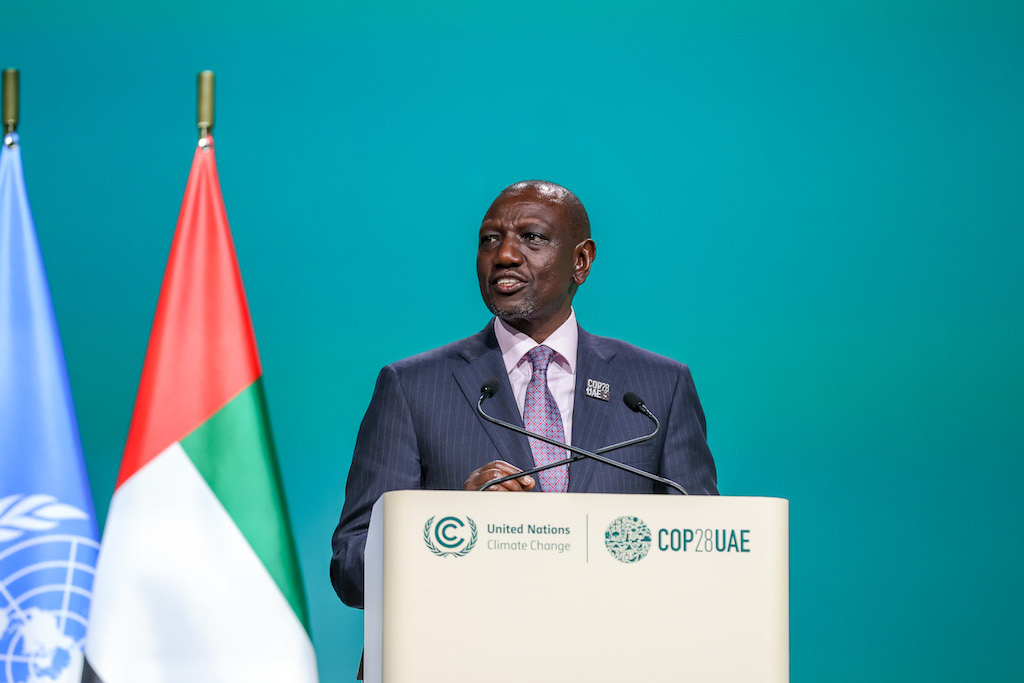
Self-styled African climate champion and president of Kenya, William Ruto, told gathered leaders that “climate change stands out as by far the defining issue of our era”. He added:
“At the heart of our discussion at this COP28 summit must be a package of ambitious energy transition and investment goals and incentives aligned with our commitment to maintain temperatures within the 1.5C limit. This contains a pledge to triple renewable energy and double energy efficiency, alongside a significant reduction in fossil-fuel dependency.”
Brazil president Luiz Inácio Lula da Silva, whose pledge to end deforestation was widely celebrated at COP27, raised eyebrows this year by using his intervention to announce he intended to align his country more closely with OPEC. He later clarified to journalists that Brazil will “never” join the organisation as a full member and instead intends to be an observer.
India used its intervention to make a bid to host COP in 2028, the Indian Express reported.
US president Joe Biden did not appear at the summit. However, vice president Kamala Harris used her intervention to announce $3m for the Green Climate Fund, Climate Home News reported.
UK prime minister Rishi Sunak caused controversy by releasing a misleading statement on what he told world leaders gathered at COP28, BusinessGreen reported.
The statement appeared to confuse Sunak’s intervention at COP28 with remarks that he gave to a closed room of political journalists later on at the summit. As BusinessGreen noted, Sunak’s remarks to political journalists focused more on the UK’s “pragmatic” decision to rollback climate measures and blamed China for rising emissions.
China at COP28
China’s presence at COP28 this year loomed large, boasting the joint-third largest delegation with more than 1,400 badges issued, Carbon Brief analysis found.
The delegation, headed by ministry of environment and ecology (MEE) vice-minister Zhao Yingmin, featured many high-ranking government officials, including MEE minister Huang Runqiu, special climate envoy and COP veteran Xie Zhenhua, as well as UN under-secretary-general for economic and social affairs Liu Zhenmin, who is expected to replace Xie as climate envoy after COP28.
Executive vice premier Ding Xuexiang – one of the seven members of China’s top political body, a trusted aide to Xi and responsible for the ministerial portfolio on environment – represented China at the World Climate Action Summit at the start of COP28.
His opening remarks, recorded by Carbon Brief, followed established positions. He proposed that delegates “practice multilateralism”, accelerate the “green transition” while “promot[ing] clean, low-carbon and efficient use of traditional energies” while strengthening implementation of current actions, particularly for “support for developing countries”.
China also hosted a jam-packed schedule of side events at its country pavilion, which ranged from methane emissions and “green” banking through to overseas energy investments and UK-China cooperation on climate science, a series of which were attended by Carbon Brief.
“The pavilion is always an interesting place to see what [China] want[s] the world to see about them”, Prof Alex Wang, co-director of the Emmett Institute on Climate Change and the Environment at the University of California, Los Angeles, told Carbon Brief.
In his view, “there’s more information available, there’s more societal involvement than ever before…That may be strategic, but it does also reflect genuine changes on the ground [in China].”
Despite a donation by the UAE “put[ting] the spotlight on China”, according to Politico, China did not pledge to the loss and damage fund operationalised at the start of COP28 and Chinese media coverage of the fund was muted.
Yuan Ying, chief China representative at Greenpeace East Asia, argued that criticism of China’s position was misguided. China on a per-capita basis is poorer than the UAE – the only developing country to contribute to the fund – she told Carbon Brief:
“China is pretty clear that [payments from] the loss and damage fund will prioritise vulnerable and least developed countries. Meanwhile, China is chipping into other channels and platforms to help other countries cope with climate change, like the south-south cooperation fund and Africa climate summit.”
Xie echoed this argument at a press conference on 9 December, saying that China “has been carrying out south-south cooperation” over the past 10 years to help other countries build capacity. (Recent analysis for Carbon Brief also underscored this point.)
Meanwhile, anticipation rose throughout the two weeks about the final text of the global stocktake and its implications for China. Many looked to the Sunnylands statement, which set “necessary, but insufficient, conditions for success at COP28”, as Li Shuo, director of China climate hub at the Asia Society Policy Institute, previously told Carbon Brief.
The final draft of the global stocktake did not refer to a “fossil fuel phase-out”, instead calling for “tripling renewable energy capacity”, “accelerating efforts towards the phase-down of unabated coal power”, using “abatement and removal technologies…particularly in hard-to-abate sectors” and transitioning away from fossil fuels in a “just, orderly and equitable manner”, all of which align with China’s policy priorities. (See: Global stocktake.)
The document was a “compromise text”, Li explained, with the overall language on coal being “very modest”.
Professor Pan Jiahua, vice-chair of the national expert committee on climate change, member and director of the Chinese Academy of Social Sciences’ Research Center for Sustainable Development and director of Beijing University of Technology’s Institute of Eco-Civilization Studies characterised it in comments to Carbon Brief as “based on a consensus that actions must be taken in line with the 1.5C target”.
He argued that the outcome showed that a “negotiated accord…[is] not a solution” and , instead, the global stocktake should shift focus from “restricting” fossil fuels to “accelerating zero-carbon industries”.
Meanwhile, Yuan said in a statement the text “will undoubtedly further boost China’s already booming renewable energy sector, accelerate the substitution of coal power and achieve the country’s target of peaking emissions from its power sector by 2025 and society as a whole as early as possible by 2030”. However, she added: “The final text lacks clear and effective implementation pathways to ensure a just and rapid energy transition.”
The Sunnylands statement itself significantly influenced the final outcome. Key language from the document featured in the final global stocktake text, with John Kerry attributing the success of the methane summit (see below) to “the meeting we had in Sunnylands” in his remarks at the event.
For example, the Sunnylands statement included a call for the US and China to “pursue efforts to triple renewable energy capacity globally by 2030…so as to accelerate the substitution for coal, oil and gas generation”.
Nevertheless, China did not sign up to an official pledge to triple renewable energy and double energy efficiency.
Professor Zou Ji, president of the Energy Foundation China, attributed this to an issue of measurement. He told Carbon Brief:
“I would say that before [COP28] we had seen the endorsement [of the renewables target] from G20 and the Sunnylands statement, but neither statement tells us very clearly which year should be the base year – should it be 2020 [or] 2022? This might seem technical, but, in the past two years, development of renewables – both globally, but particularly in China – has been greatly boosted. So using different [base years] could be very significant.”
Wang said he believes that China’s unwillingness to sign was “due to a line on acknowledging the need to phase out unabated fossil fuels”, which was not acceptable to the country.
By contrast, Pan told Carbon Brief that tripling renewable energy was “not enough” and that countries should be more ambitious. In his view, “renewable energy does not require a huge amount of investment” and consumers will be unlikely to settle for “more expensive” abated fossil fuels.
China also suggested in its initial submission to the UNFCCC that language be included on “rising unilateralism, protectionism and anti-globalism”. However, the final text saw this watered down to “measures taken to combat climate change, including unilateral ones, should not constitute a means of arbitrary or unjustifiable discrimination or a disguised restriction on international trade”. Li pointed out that “this is actually stronger” than language in the Sunnylands statement, which the Chinese delegation “should be happy about”.
The EU’s carbon border adjustment mechanism (CBAM), which was seen as a possible point of conflict going into the conference, seems to have faded from the text. “I think the consensus is that CBAM is to be discussed at the World Trade Organisation, not at the UN”, Yan Qin, carbon analyst at the London Stock Exchange Group, told Carbon Brief.
In addition to the global stocktake, one of two other key developments was Xie’s announcement that China would release a new nationally determined contribution (NDCs) that included targets for both 2035 and 2030, the year before which China has pledged to peak its carbon emissions. “The Chinese government also attaches great importance to this matter”, Xie said.
Li attributed two possible motivations to the announcement. “One is ‘don’t ask us again, there won’t be anything new, wait until 2025’. That’s my interpretation. The other is ‘2030 isn’t entirely fixed, we could still enhance the ambitiousness of the 2030 target’.”
The second key development was the summit on methane and non-CO2 greenhouse gases, co-hosted at COP28 by China, the US and the UAE and attended by Carbon Brief. The summit was intended as a strong political signal of US-China cooperation and the importance they both now place on reducing methane emissions. In his remarks at the event, John Kerry emphasised the countries’ progress in driving the conversation, noting that methane “was not even talked about in Paris”. (Also see: Methane.)
Xie described the summit as an “important step”. However, he argued, China has a “poor foundation” for regulating methane, adding: “We need concrete measures, we need capital support and we also need a feasible technical pathway on how we can join hands to tackle climate change.”
As with China’s domestic methane emissions action plan, however, the methane summit did not see any concrete targets for reducing methane. “I hope that we can maintain the momentum”, Li told Carbon Brief, because, “of [all the] topics they could choose, they chose methane”. It would be frustrating if this level of momentum “still can’t move the ball”, he added.
At a side event on methane abatement held at the China pavilion on 4 December and attended by Carbon Brief, Xie explained that, for China, the priorities for controlling methane emissions under the plan are measuring, reporting and verification (MRV), the waste and agricultural sector, energy security and food security.
Controlling methane emissions, he said, will happen “under the precondition of energy security and food security”.
The plan is the first “specialised and holistic” strategy for methane abatement, Xu Huaqing, director general of the National Center for Climate Change Strategy and International Cooperation and a former IPCC author, said at the same event.
He added that China has “strengthened” its nationally determined contribution in terms of abating methane emissions in the agriculture sector and oil and gas sector.
Kerry also said at the methane summit that the friendship between him and Xie “was the reason we could work together in Paris, in Glasgow and now in Dubai”.
With Xie likely to be replaced by Liu Zhenmin, there is now an important open question about whether Liu will be able to maintain this positive dynamic.
(Liu and Susan Biniaz, considered to be “one of the most innovative American legal minds when it comes to climate negotiations”, were seen together on multiple occasions, while Jennifer Morgan, Germany’s special representative for international climate policy and former Greenpeace co-leader, shared a stage with him and told the audience that they had held discussions on Germany’s net-zero transition in an event attended by Carbon Brief.)
And, despite his and Kerry’s respective ages (Xie is 74 and Kerry just turned 80), Xie said at the 9 December press conference: “We will not leave this field, we will still do our best to promote progress in this field.”
Oil-and-gas influence and greenwashing
Allegations of oil-and-gas influence and greenwashing plagued the COP28 presidency throughout the summit (see: Emirati leadership).
In the days ahead of the summit, the presidency was rocked when an investigation by BBC News and the Centre for Climate Reporting alleged that the UAE planned to use its role as COP host to strike “secret” oil-and-gas deals behind the scenes of the summit.
The UAE’s COP28 team at first refused to deny the allegations to BBC News and said that “private meetings are private”. After the story’s release, Al Jaber released a statement saying that the allegations were “false, not true, incorrect and not accurate”, Bloomberg reported.
The Centre for Climate Reporting also released a second investigation alongside Channel 4 News on 27 November alleging that Saudi Arabia had a plan to “artificially” boost oil consumption in African and Asian countries.
In an undercover sting operation, journalists from the Centre for Climate Reporting posed as oil investors and asked officials from Saudi’s ministry of energy whether the country had plans to boost oil demand in certain markets. In response, an official said:
“Yes…It’s one of the main objectives that we are trying to accomplish.”
Representatives from Saudi’s government refused requests for comment, according to Channel 4 News.
In a first for COP summits, the UNFCCC released an excel spreadsheet listing the names of every delegate registered for COP28. This allowed journalists and NGOs to scrutinise the delegates in attendance in more detail than ever before. (See Carbon Brief’s analysis of COP28 delegate numbers.)
Heated reported that the list contained “hundreds of fossil-fuel industry representatives”.
BBC News covered an NGO analysis that found that “around 2,400 people connected to the coal, oil and gas industries” registered for COP28. It described this as a “record” number.
The Guardian reported on analysis by the NGO Corporate Accountability that found more than 160 attendees had a past record of pushing climate scepticism.
The Guardian also covered an analysis finding that “at least a quarter of the billionaires registered as delegates at COP28 made their fortunes from highly polluting industries such as petrochemicals, mining and beef production”.
Near the start of the summit, the NGO Global Witness released an analysis finding that ADNOC, the fossil-fuel firm headed by Al Jaber, was on course to become the second-largest oil producer in the world by 2050.
On 5 December, ADNOC and the state oil company of Azerbaijan, which is hosting COP29, announced that they will collaborate to advance “blue hydrogen” – a type of hydrogen made from fossil gas.
Protests, surveillance and harassment
In the build-up to COP28, civil society and activists feared surveillance and restriction in the UAE where protests are not allowed.
A UAE official said “peaceful assembly” and “expression of views” would be permitted at the Dubai summit, the Financial Times reported last month. But activists told Carbon Brief at the summit that they remained concerned about their rights.
While protests did take place over the course of the two weeks within the UN-run blue zone, activists claimed they were limited in where they could protest and what they could say. (At every COP, the UN insists on strict rules about pre-sanctioned protests.)
Sebastien Duyck, a senior attorney at the Center for International Environmental Law, told reporters that restrictions were “having a terrible impact” on civil society. He added:
“It leaves all of the delegates second-guessing what they can say without getting in trouble, constantly trying to self-censor and understand how far to go.
“This is an experience of restrictions of assembly, freedom of speech that the United Nations shouldn’t be giving to the delegates that are coming here.”
On 9 December, hundreds sweltered under the midday sun to call for climate justice in the biggest protest at the summit.
At this and several other protests in Dubai, people called for a ceasefire in Palestine. (See: Israel and Gaza crisis section.) Posters held aloft by activists and posted around the expo centre called for “climate justice now” and to “make polluters pay”.
Pikachus, “sustaina claus” and dugongs (also known as sea cows) were among the more eclectic demonstrators in the blue zone.
Young people marched into one of the plenary rooms for a “Fridays for Future” protest on 8 December.
Activists staged a sit-down protest at the Organisation of the Petroleum Exporting Countries (OPEC) pavilion, after Bloomberg and other outlets reported details of a leaked letter from the organisation urging member countries to reject any COP28 texts that target fossil fuels.
One protest group called for the release of jailed democracy activists in the UAE and Egypt, which Human Rights Watch described as historic, Reuters said.
However, despite these gatherings, Dubai’s COP was “probably the most restrictive we have seen” for civil society, Asad Rehman, the executive director of UK campaign charity the War on Want, told media including Carbon Brief on 8 December.
He said that it was “way more restrictive than Egypt last year” (read Carbon Brief’s COP27 key outcomes piece). The protests at both summits differed to previous years, including COP26 in Glasgow, where around 100,000 people took to the streets for the main protest.
Looking ahead to next year’s summit in Baku, Azerbaijan, another petrostate with restrictions on protest, Duyck told reporters:
“It will be essential to make sure that the secretariat and the presidencies decide their rules, their division of responsibility so as to ensure and protect the human rights of every single participant.”
Alongside protests, cyber-security concerns hit the summit months in advance. Adnoc, the UAE’s state oil company – which COP28 president Al Jaber is head of – was able to read emails “to and from the COP28 climate summit office”, the Guardian reported in July. This was despite the office stating that its email system was “separate” from Adnoc.
Activists, NGOs and journalists internally discussed the safety of using their own mobile phones and public wifi connections while at COP28. Many opted to use a private network connection.
The poor air quality in Dubai was another notable issue, particularly on health day at the summit, when France 24 said that the city’s skyline was “obscured by a blanket of smog rated as “unhealthy”. A Human Rights Watch report released during COP said that the UAE’s fossil fuel production “contributes to toxic air pollution”.
People shared images of their hotel room views, which ranged from gas plants to cement factories. Some attendees even spotted methane flares from the city’s metro line – something which continues to occur at UAE oil and gas fields despite the country committing two decades ago to stop routine flaring, the Guardian recently reported.
Israel and Gaza crisis
The impact of the on-going Israel and Gaza crisis was felt inside and outside of negotiating rooms at COP28.
Politico reported that climate change was “shoved to the side” during the world leaders segment on 1 December, as several heads of state used their addresses to speak about the crisis and others skipped the event in protest.
According to the publication, Jordanian king Abdullah II, Iraqi president Abdul Latif Rashid, South African president Cyril Ramaphosa and Turkish president Recep Tayyip Erdoğan were among the leaders who used their COP28 speeches to draw attention to the crisis, with Abdullah saying:
“This year’s COP must recognise even more than ever that we cannot talk about climate change in isolation from the humanitarian tragedies unfolding around us. As we speak, the Palestinian people are facing an immediate threat to their lives and wellbeing.”
Both Israeli president Isaac Herzog and Palestinian Authority leader Mahmoud Abbas did not appear at the summit as scheduled, Politico said. Saudi Arabia’s Prince Mohammed bin Salman was also absent.
In addition, Iran’s delegation walked out over the Gaza crisis on the summit’s first Friday and had cleared out their pavilion by the end of the day, Politico said.
The New York Times reported that US president Joe Biden was unable to attend COP28 because he was “consumed” by the crisis. US vice president Kamala Harris used some of her time at the summit to speak about the crisis with the UAE president, the National reported.
Towards the end of the summit – as negotiations fell into “disarray” – some observers said that the crisis had heightened distrust between developed and developing countries in the negotiations. Meena Raman, head of programmes at the Third World Network, told a media huddle:
“The distrust is really there…You can see the frustration on the faces of the developing countries.”
Outside of the negotiations, calls to address the Gaza crisis dominated COP28’s biggest protest, which took place in the blue zone – technically, UN soil for the duration of a COP – on 9 December.
Because protests are usually not permitted in the UAE, the march represented the first demonstration in support of Palestinians to take place in the country, Reuters reported.
Elsewhere in the blue zone, an installation of children’s shoes and socks highlighted the number of children that have been killed in Gaza.
New climate science
The World Meteorological Organization (WMO) released a pair of reports at COP28: the provisional 2023 state of the climate report and a decadal climate report covering 2011-20.
The state of the climate report confirmed that 2023 is “set to be the warmest year on record”, at around 1.4C above pre-industrial temperatures. Although the report was based only on data through to October 2023, the size of the temperature anomaly in 2023 meant that the final months of the year were “very unlikely to affect the ranking”, the report said.
The decadal report termed 2011-20 a “decade of acceleration” and documented the devastation that extreme weather had wreaked on food security, migration and national development.
For the first time, the WMO’s decadal report included a section on climate finance, which pointed out that while climate finance had nearly doubled over the past decade, it still needs to increase sevenfold “to achieve climate objectives”.
On 3 December, the annual 10 New Insights in Climate Science report was released. The report highlighted the near-inevitability of overshooting 1.5C of warming, the risks of overreliance on natural carbon sinks, the accelerating loss of mountain glaciers and the need to reform food systems for climate action.
During a press conference, Prof Johan Rockström, director of the Potsdam Institute for Climate Impact Research, said:
“To return back to 1.5C by the end of the century requires that we do everything right – phasing out fossil fuels, transforming the global food system, maintaining all the carbon sinks and stocks on land and ocean and scaling carbon dioxide removal. Everything has to happen simultaneously.”
Scientists from the UK Met Office published a commentary piece in Nature on 1 December calling for an agreed definition of the current level of global warming in order to monitor when the world might breach the Paris 1.5C limit. They proposed a new indicator that blends observations for the past 10 years with climate model projections or forecasts for the next 10 years.
A new report, published on 6 December, warned that Earth system tipping points have put the planet on a “disastrous trajectory”. The authors said that promoting “positive social tipping points” is “the only realistic systemic risk governance option” to limit the risks.
The 2023 Global Carbon Budget report was published on 5 December. It found that global carbon dioxide emissions from fossil fuels and cement increased by 1.1% in 2023, hitting a new record high of 36.8bn tonnes of CO2.
On 9 December, researchers at Climate Action Tracker released an analysis that found few of the international pledges made at COP28 “will meaningfully contribute to closing the emissions gap” to 1.5C.
“Many of them lack either the ambition, clarity, coverage or accountability needed to really make a difference,” the research said.
Road to COP29 and beyond
After months of wrangling and blocking, it was agreed at COP28 that next year’s COP will take place in Baku, Azerbaijan.
The summit’s location rotates among the five UN regional groups each year, with COP29 set for eastern Europe. Deciding a host country requires consensus, however, and Russia’s opposition to different choices due to the country’s ongoing war in Ukraine caused a delay.
Russia blocked bids from nations including Bulgaria, Slovenia and Moldova, the New York Times reported.
If a location had not been agreed, the talks could have been held in Bonn where the UNFCCC headquarters are located. But Azerbaijan was eventually selected on 9 December, according to Climate Home, following the brokering of an agreement with neighbouring Armenia.
Additionally, Brazil was confirmed as the host of COP30 in 2025, with the summit taking place in the rainforest city of Belém. Other countries have already put bids forward to host future COPs – including Australia for COP31 and India for COP33. But these have yet to be formally decided.
In the table below, Carbon Brief has compiled the key meetings and milestones leading up to COP29 in Azerbaijan.
| 8 February 2024 | Pakistan general election |
| 14 February 2024 | Indonesia general election |
| 1 March 2024 | Submission date for the JTWP |
| June 2024 | UNFCCC intersessional meeting in Bonn, Germany |
| 2 June 2024 | Mexico general election |
| 6-9 June 2024 | European parliament election |
| 17-19 June 2024 | G7 summit, Puglia, Italy |
| 22-30 June 2024 | London climate action week |
| 12-14 July 2024 | G20 summit, Rio de Janeiro, Brazil |
| 22-29 September 2024 | Climate week New York City |
| 10-24 September 2024 | UN General Assembly (UNGA 79), New York City, US |
| 21 October – 1 November 2024 | UN Biodiversity Conference (COP16), Expected to be in Colombia |
| 5 November 2024 | US elections |
| 11-24 November 2024 | COP29, Baku, Azerbaijan |
Sharelines from this story
[ad_2]


